Jelgava yesterday and today
Each city has its own story to tell, assembled by little pieces of history through time, forming the portrait and proving its strength. During the long period of its existence, Jelgava has experienced a lot and formed the foundation for its future growth. In the anticipation of the 756th birthday of Jelgava, a photo series “Jelgava yesterday and today” has been created, offering everyone a virtual and visual assessment of the changes our city has underwent in the last two decades.
Everyone is already familiar with Jelgava “today”, though many have forgotten or never even experienced Jelgava “yesterday”. Many streets and buildings have been reconstructed and renovated, new objects have been built and unique recreation places have been established in the last two decades, local events have gained an international dimension, and all this together forms Jelgava, which we love and are proud of. But the main value of the city is its people, and everyone has the opportunity to grow with the city and contribute to it, because together we are Jelgava!
.jpg)
In 2022, through the implementation of two projects supported by the European Regional Development Fund (ERDF), the building at 47A Zirgu Street was both reconstructed and insulated.
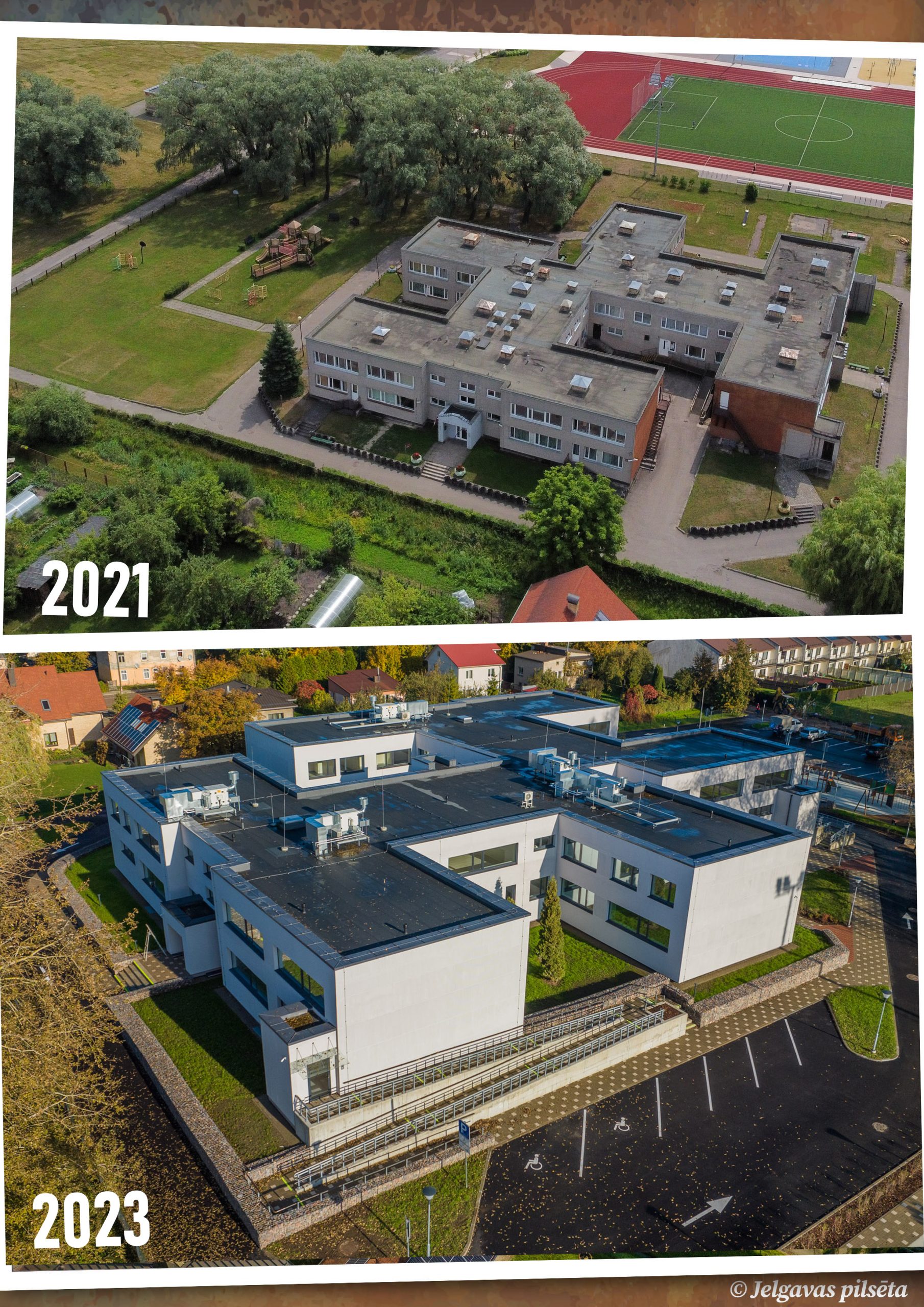
The renovated building now provides the opportunity to serve a larger number of clients, offering services in a modern environment equipped for various target groups. It also facilitates the formation of a strong team of specialists who provide related services all in one place. The new premises house the day centres “Harmony” and “Integra,” a Crisis Centre, some specialists from the Family Support Division, and offer educational and support group services as well as the Behavioural Social Correction Program.
The surrounding area has also undergone significant changes, with the construction of a parking lot, access road, and pedestrian pathways, a children’s playground, and ensured accessibility for people with mobility impairments, including the installation of an elevator.
.jpg)
The reconstruction project of Jelgava Technology Secondary School is one of the most significant municipal projects undertaken in recent years, both in terms of the scope of work completed and the technical and professional challenges, as well as the amount of funds invested.
The school has been completely rebuilt. An observatory has been constructed on its roof to collect data for educational purposes, and solar panels have been installed, enabling students to practically learn about the use of renewable energy in everyday life. An innovative playground has been built in the schoolyard for the younger students, while older students have access to a workshop where they can weld, mill, and build electric cars. More than 15 million euros have been invested in the school’s reconstruction.
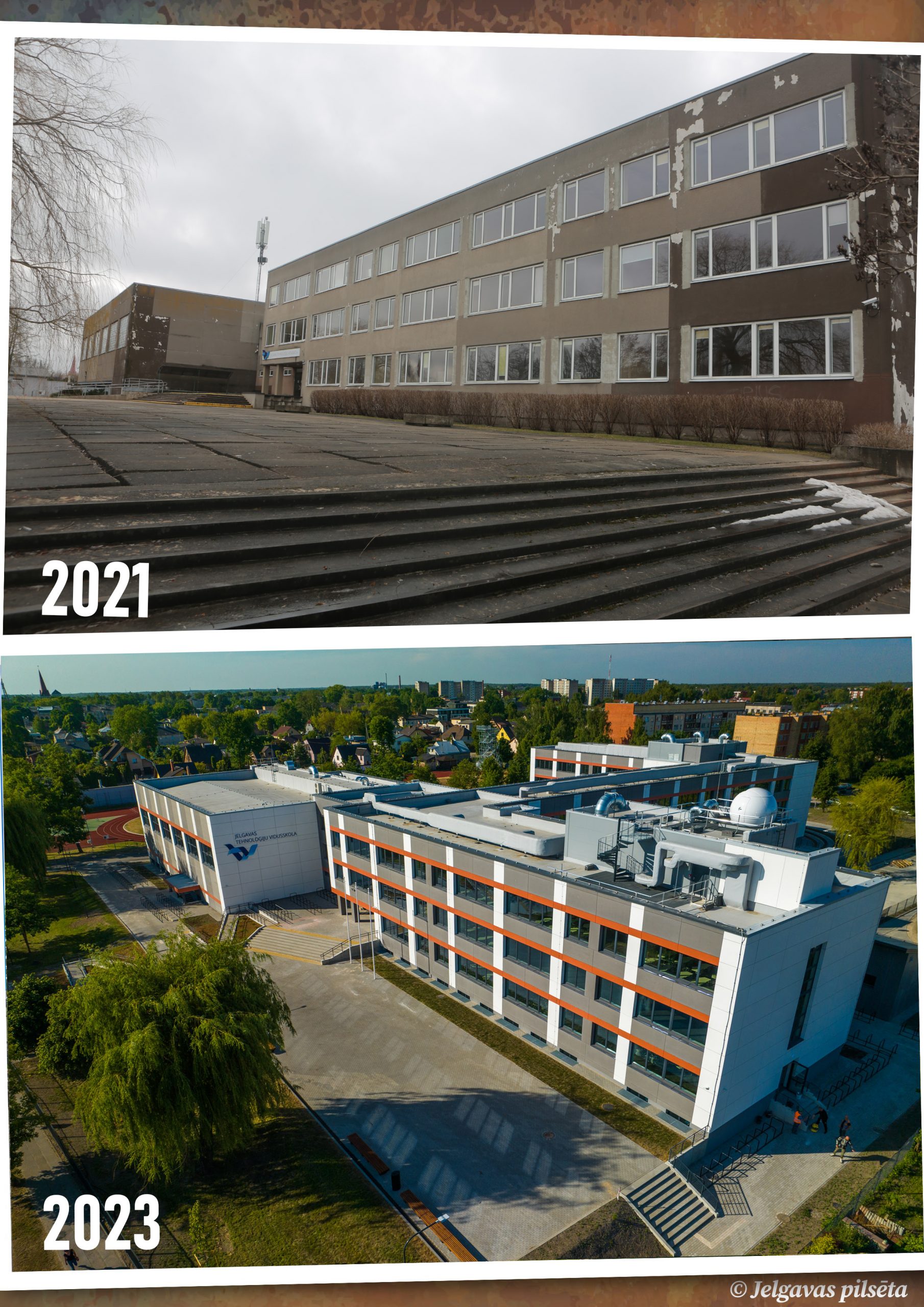
During the reconstruction, the building’s energy efficiency has been enhanced by insulating it, replacing windows and doors, and overhauling the heating network and unit, as well as the ventilation and lighting systems. Internal and external engineering networks have been rebuilt and installed. New technologies have been introduced, such as a sensor-based ventilation system that calculates oxygen levels in classrooms and ensures optimal air quality when needed.
The school’s grounds have also been landscaped. A spacious paved area for events has been created in front of the school, with video surveillance installed. Bicycle racks for 240 bikes have been set up around the building, and new trees and greenery have been added to the area. A ramp has been built at the entrance, and a lift has been installed on the opposite side of the school, which was not there before.
In the schoolyard, a playground with a rubber surface has been built for younger students. It features various equipment such as balance elements, rubber balls and cubes, outdoor musical instruments, trampolines, and an interactive play equipment “Yalp memo,” which consists of a play area and seven columns equipped with 360-degree LED touchscreens and sound. This equipment allows students to learn in an engaging and interactive way. On the other side of the school, an amphitheatre or green classroom has been constructed for outdoor lessons.
To promote astronomy, an observatory has been built on the school’s roof. Data from the observatory will be collected remotely. Solar panels have also been installed on the roof, allowing students to learn about using renewable energy in practice. Initially, solar energy will be used in the smart classroom, where students will learn about technology, and in the future, it could be used to power the school’s outdoor lighting in the summer.
The school’s auditorium has received a new floor covering, acoustic ceilings, and modern sound and lighting systems. A screen has been installed on the stage for projecting images, and a special theatre classroom has been built behind the stage, equipped with lighting and sound systems and a movable digital screen.
The sports hall has undergone significant changes—it now features a special sports floor with a FIBA certificate, and acoustic solutions have been implemented in the ceiling to accommodate other events if needed. The hall can now be divided into two sections to allow simultaneous sports activities, and an 8.2-metre climbing wall has been installed.
To reinforce theoretical knowledge with practical experience, a 70-square-metre workshop has been built in the schoolyard where students can weld, mill, build electric cars, and repair their bicycles.
The school canteen and kitchen have also been renovated and leased to a service provider. The kitchen is divided into zones such as a bakery, distribution area, meat processing room, etc. A food lift has been installed to transport products from the storeroom in the basement to the kitchen.
Historical features have been preserved in the building—concrete mosaic flooring has been restored in the corridors of the 1st and 2nd floors. Additionally, the ceramic bas-reliefs created by Aleksandrs and Māra Djačenko have been retained in all school corridors. Monitors have been installed in the corridors and near the auditorium to display current information for the school and to broadcast live events happening in the auditorium.
.jpg)
To address the demand for places in municipal kindergartens, a modern preschool educational institution has been established at 31A Brīvības Boulevard in Jelgava through the project “Building Reconstruction into a Preschool Educational Institution at 31A Brīvības Boulevard, Jelgava.” The kindergarten has a total capacity of 160 places.
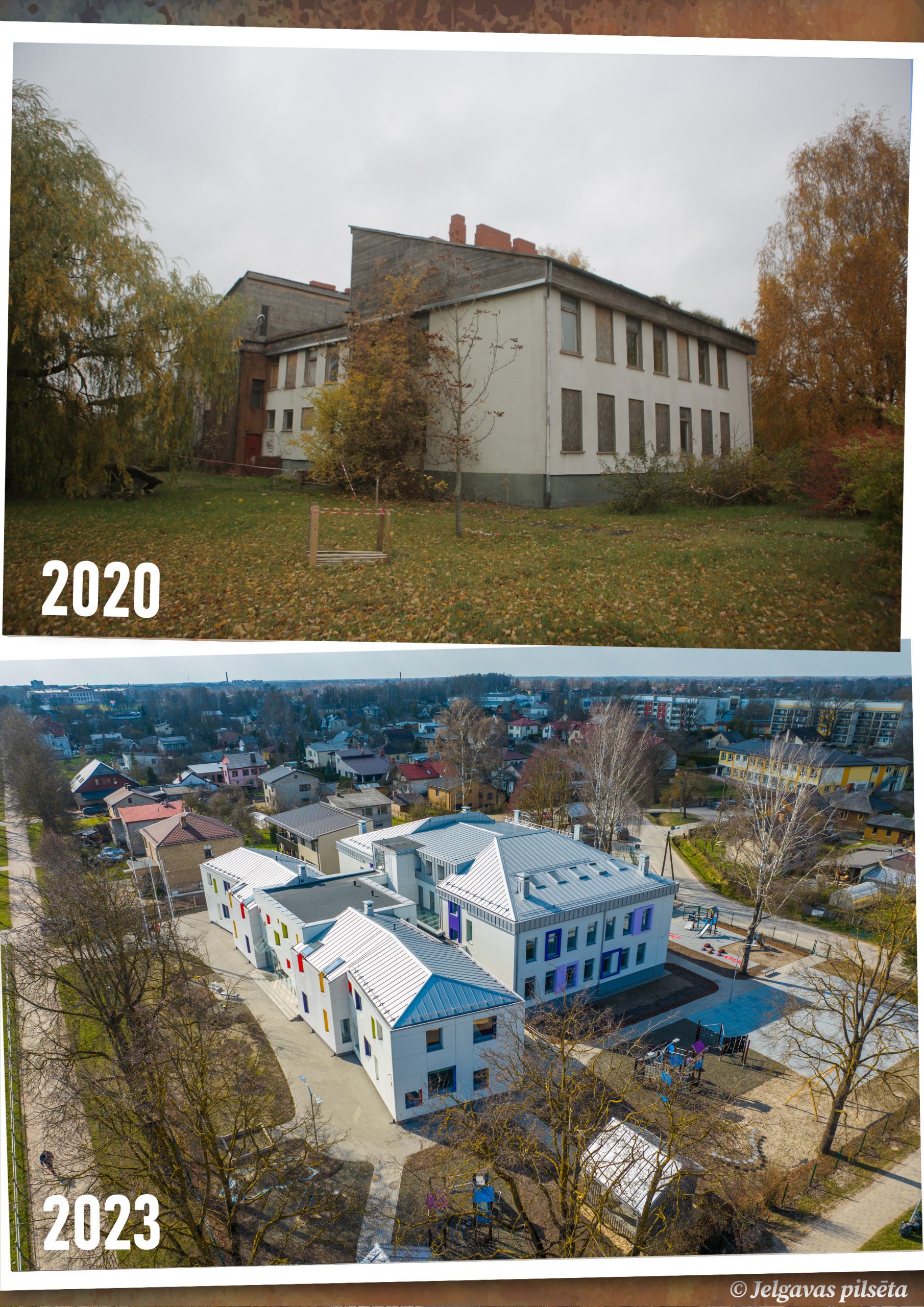
The total area of the kindergarten is 2019 square meters, and the building consists of two wings and three floors. The first and second floors accommodate eight groups. On the first floor, there is a kitchen and a common area where a receptionist will coordinate the flow of people. The second floor features a sports hall and a room for music lessons. The third floor, or the attic, houses administrative offices, an art room, a methodological room with an interactive whiteboard, a small library, and a special stepped area where students can watch educational films. The attic also includes offices for specialists such as a speech therapist, nurse, social pedagogue, and psychologist.
.jpg)
During the reconstruction, the building at 13 Stacijas Street has been completely transformed. The former dormitory-style building now features 28 one- and two-room rental apartments and four service apartments adapted for people with functional impairments.
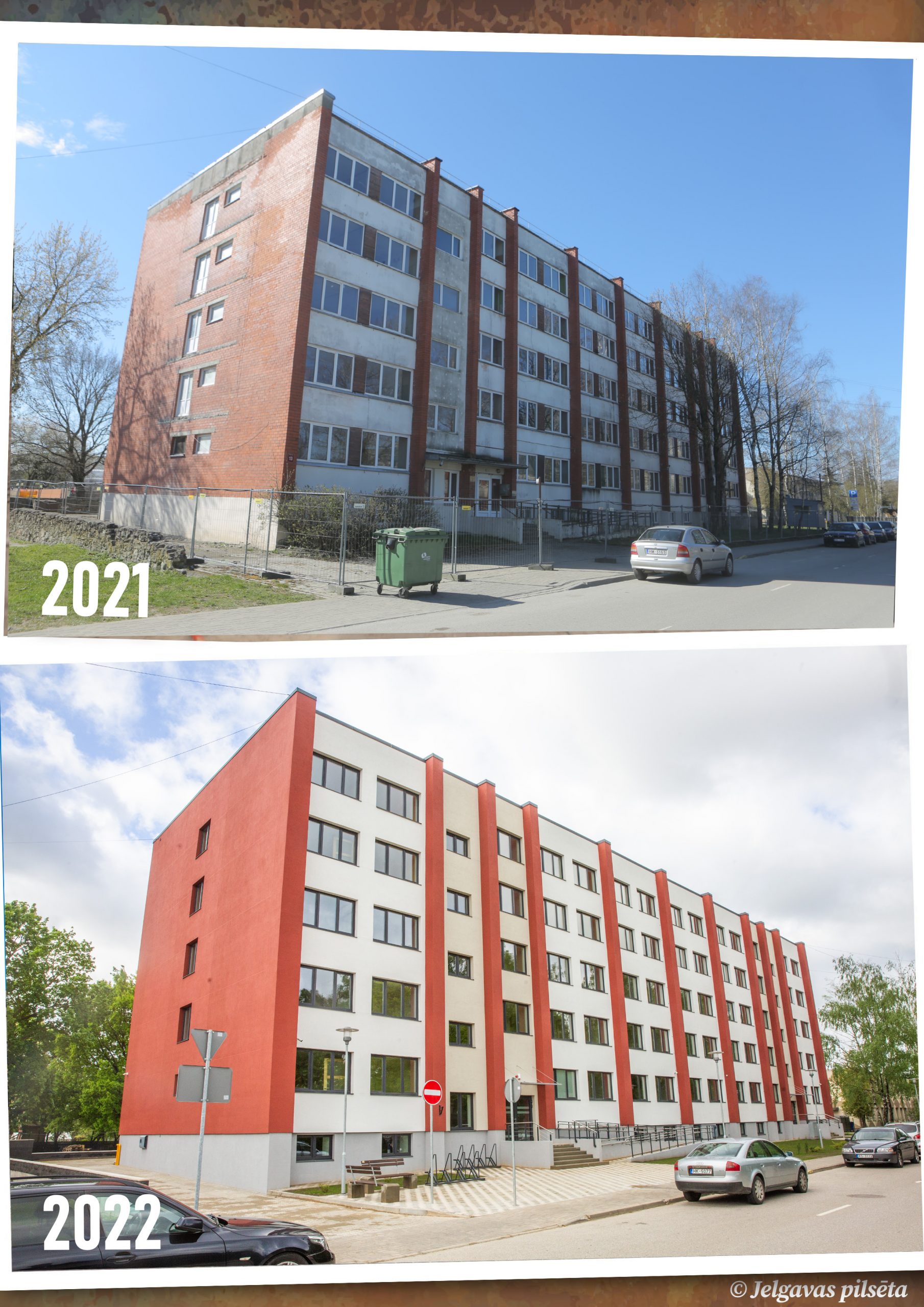
After the reconstruction, units of the Jelgava Social Affairs Administration have started operating in the building at 13 Stacijas Street. It now houses the “Atbalsts” day centre, the Social and Medical Care Centre, and the Social Services Centre for Children. The Health Care and Promotion Department has also begun work in the new premises. Additionally, the municipality has signed rental agreements and rented out one- and two-room apartments to families from Jelgava who had been waiting in line for municipal assistance in resolving their housing issues.
.jpg)
Construction work has been carried out around Būriņu Road and Sniega Street with the aim of reducing flood risk in the territory of Jelgava City by implementing comprehensive measures to restore the flow of the Svēte River and reduce the flood threat in the surrounding areas.
In an area that was previously overgrown with bushes, untidy, and wet – specifically in the floodplain meadows of Svēte between Sniega Street, Būriņu Road, Vītolu Road, and Miezītes Road—a recreational zone almost 3365 square metres in size has been created. This zone features a network of wooden boardwalks for walks, stretching over 1.6 kilometres, with the boardwalks connected by three gravel paths. The smaller boardwalk area, 562 metres long, is located between Miezītes and Vītolu Roads, encircling Miezītes Pond, which has become home to two swans that delight residents during their walks. The longest wooden boardwalk path, 1103 metres long, is situated between Būriņi Road and Sniega Street. To ensure accessibility even during flood times, the boardwalks are built at a height of 1.5–2 metres. For pedestrian safety, the wooden boardwalks are equipped with railings that have special mesh installed. In several places along the path, platforms have been created where people can pass each other or simply stop to observe nature.
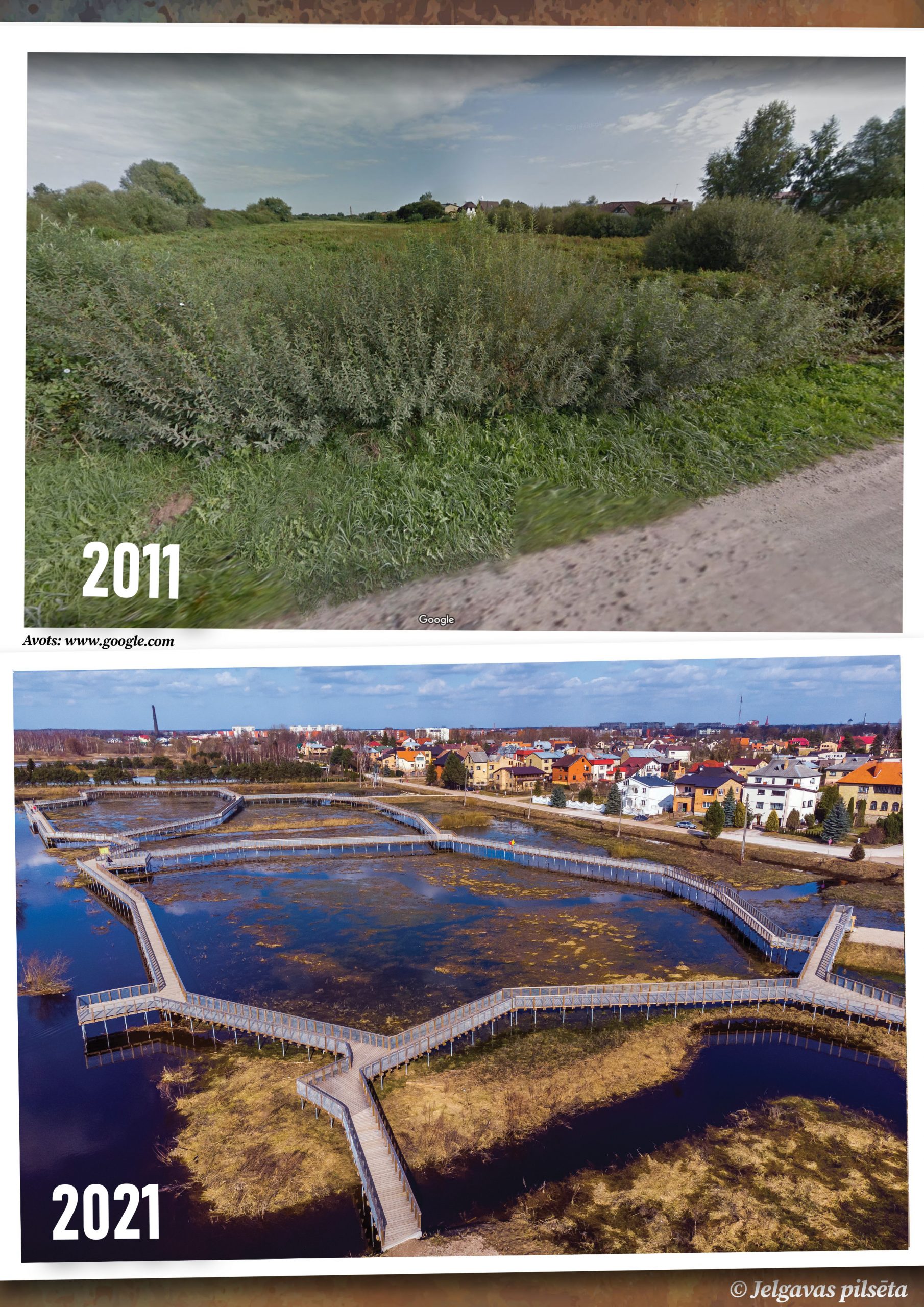
Additionally, to promote flora diversity, a meander or wetland area of 1.2 hectares has been established in the floodplain meadows, where various plants have been planted, such as fragrant sweet flag, common reed, and osier. These will only be visible in the summer when the floodplain meadows are expected to be dry. The new recreation area has already become a popular walking spot for both local residents and other city dwellers who enjoy getting closer to nature.

In 2019, the roof construction of the Pasta Island open-air concert hall was completed and the concert hall was put into commission. Continuing the unified concept of the unique pedestrian bridge in the Baltics, which connects the city center with Pasta Island, the open-air concert hall was named “Mītava”.
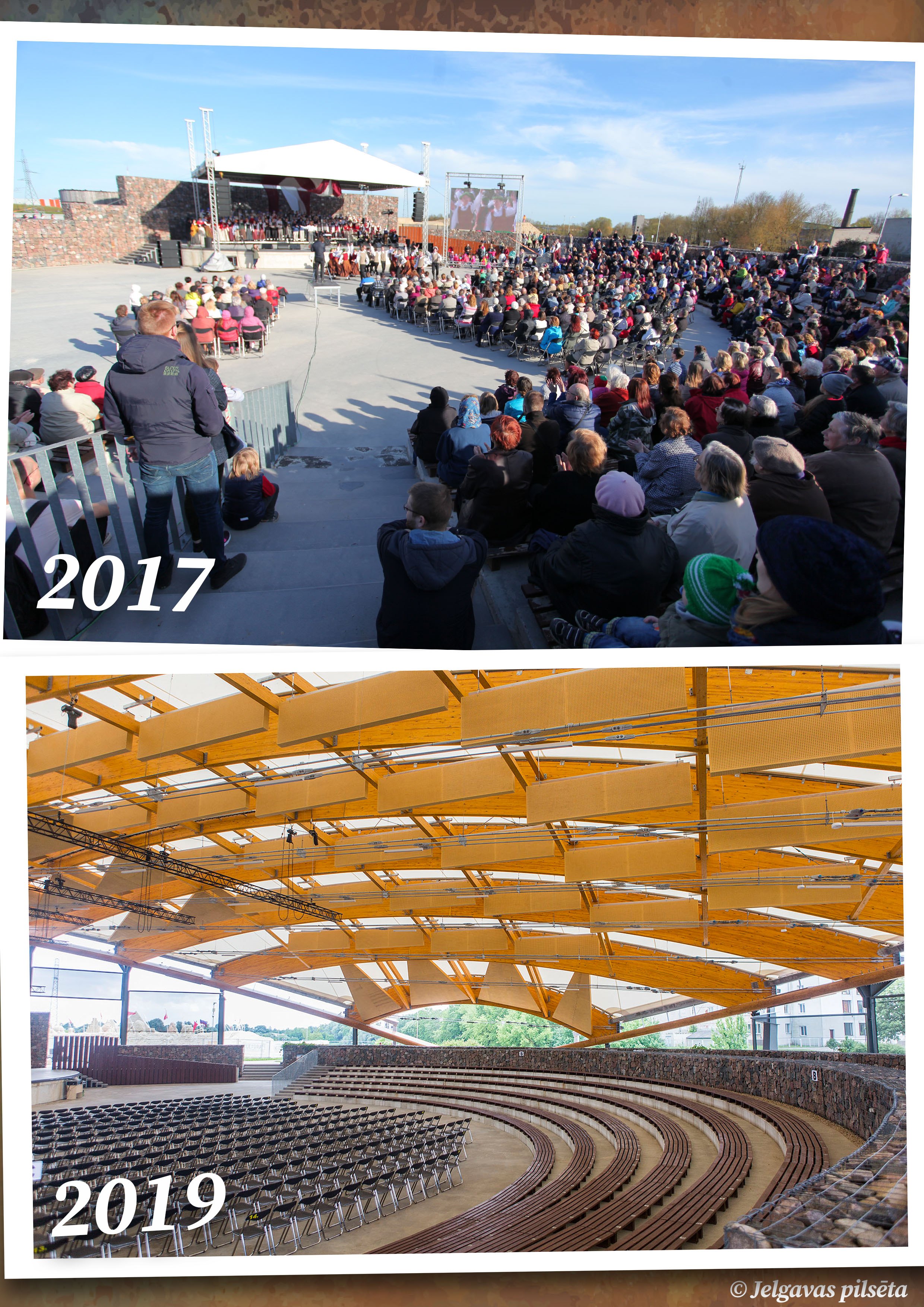
As new as the bridge is the new roof and construction of the concert hall. The shape of the roof resembles a shell that was washed up on the banks of the Lielupe. The roof structure of the concert hall has been created using innovative large-sized bent glued wood technologies, and it is the largest building of its kind in the Baltics so far, considering that the largest span is about 60 meters long, and it is also a new record in Latvian construction history. The beams have a span of 20-30 meters and are the original work of the architects, which further enhances the aesthetics of the environment of the Pasta Island.
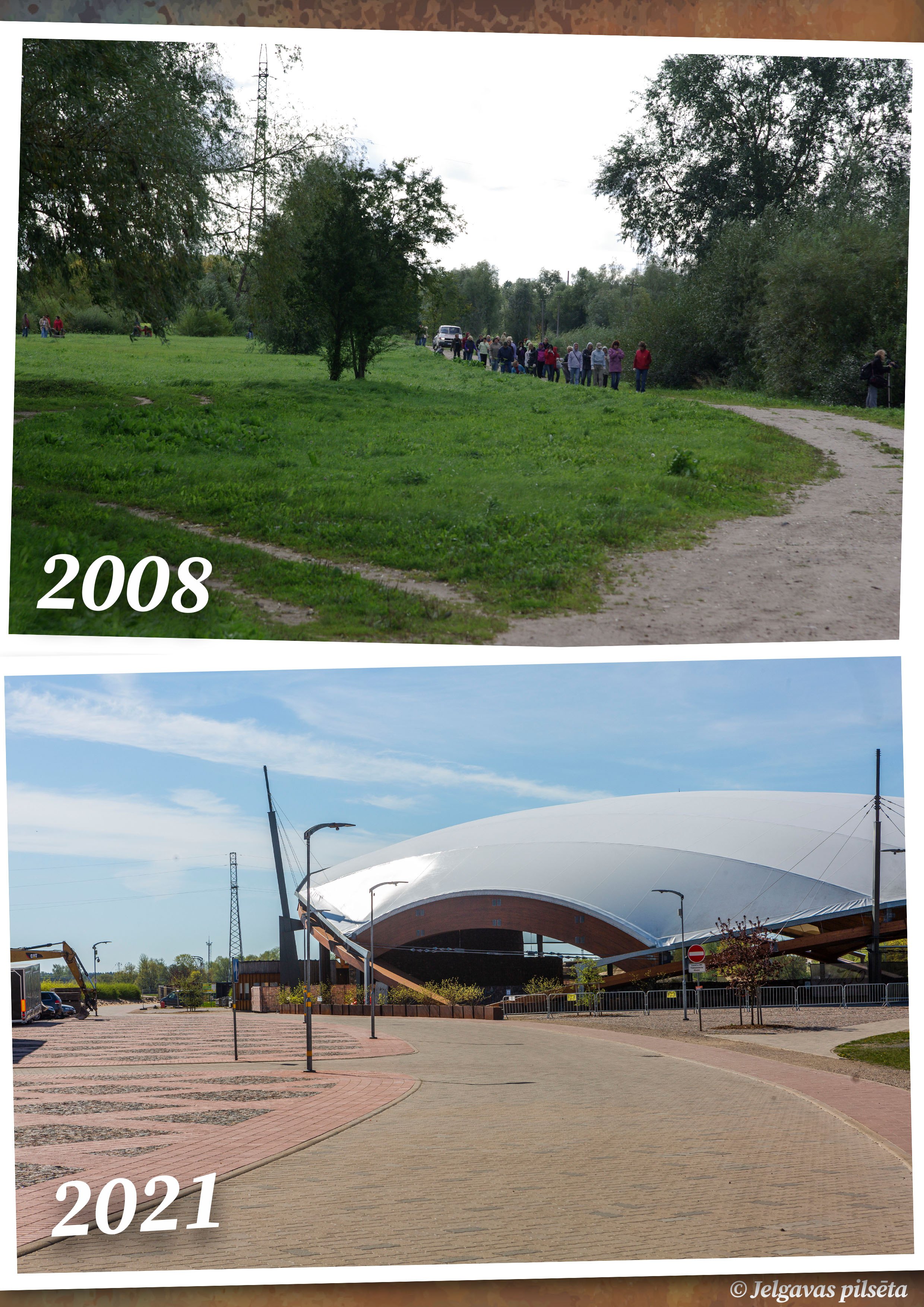
A roof solution developed by an Italian textile architecture company has been chosen for the roof covering – the highest quality membrane with higher strength, tensile and tear properties, providing a self-cleaning surface of the covering, protection against mold, increased fire reaction class. It should be noted that windbreak curtains have also been installed around the perimeter of the stage, protecting them from the winds on Pasta Island.
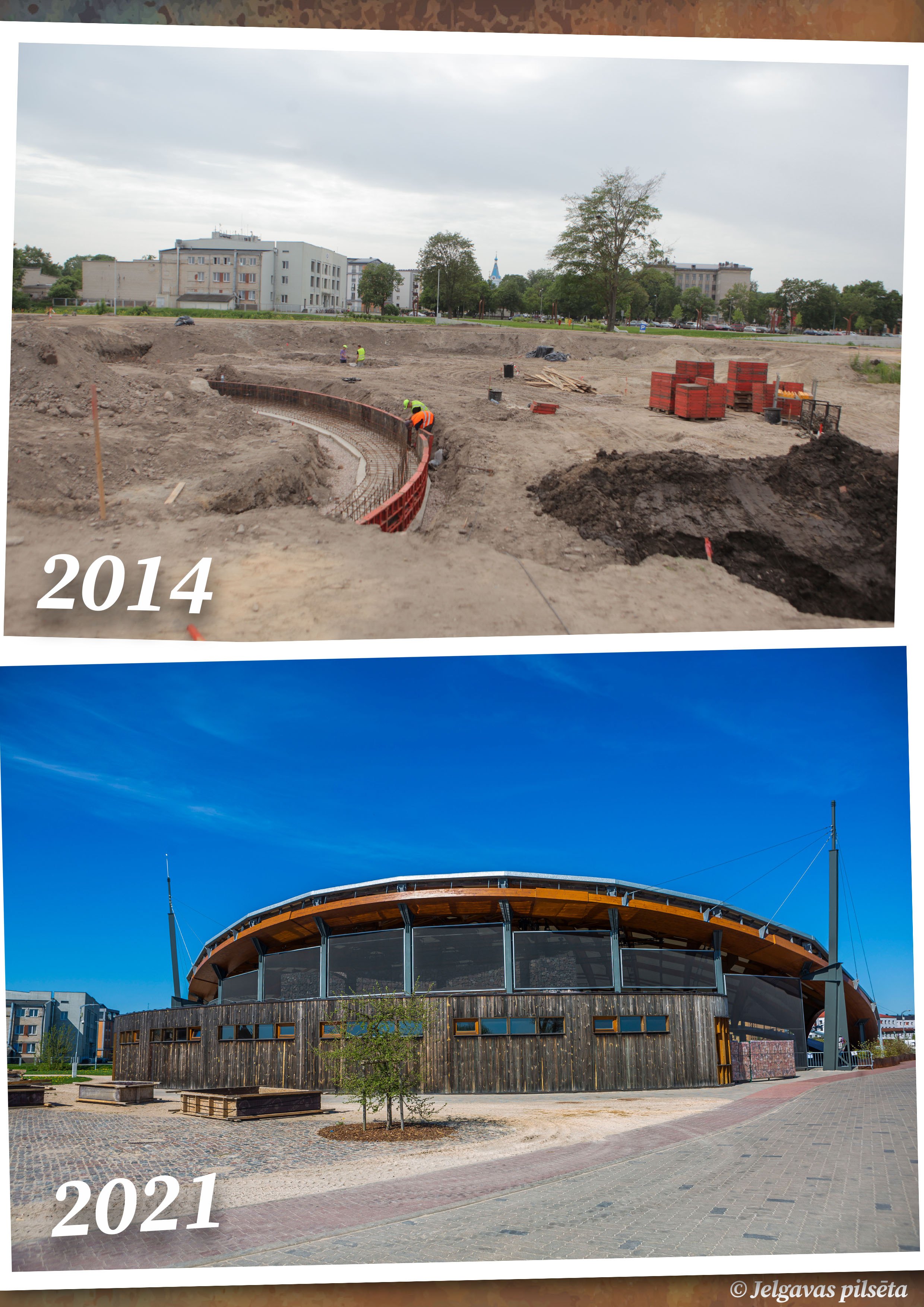
In 2020, the open-air concert hall “Mītava” won the 1st place in the competition “Latvian Construction Annual Award 2019” in the nomination “Wooden Construction”. This year, on March 24, 2021, the winners of the Latvian Events Forum Excellence Award, including the open-air concert hall “Mītava”, were announced online at the award ceremony, receiving the award in two nominations – “2020 Outstanding Event in Zemgale” and “2020 the most Excellent Venue for Events”.

The building of the Gedert Elias Jelgava History and Art Museum, known by the historical name “Academia Petrina”, was built in 1775 on the initiative of the last Duke of Courland and Semigalia Peter Biron on the site of the former ducal city castle. The building once housed the first university in the territory of Latvia, where the first presidents of both Lithuania and Latvia studied.
In 2006, all windows of the G.Elias Jelgava History and Art Museum were replaced, a total of 92, as well as the museum facade was restored and the internal heating system was reconstructed with the aim not only to save energy, but also to improve the visual appearance of the building, which is important both for the successful storage of the museum’s collection and for creating a favorable environment for its visitors and staff.
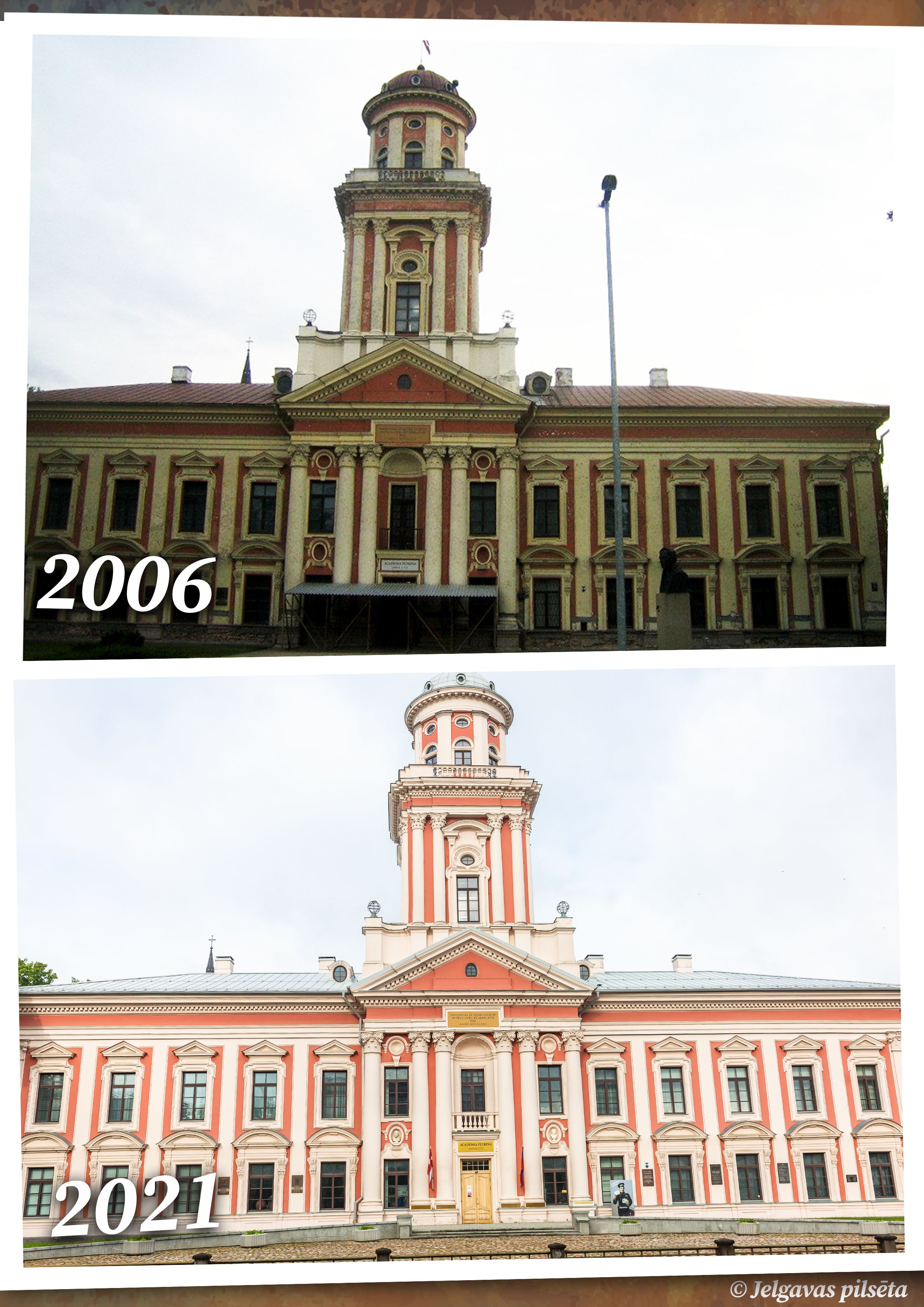
In 2009, the improvement of the surroundings of the G.Elias Jelgava History and Art Museum was started – the old pedestrian paths were dismantled, a new pavement was laid, the territory was greened, a parking lot for museum visitors was created, as well as a museum facade, street, park and yard lighting network.
In 2017, the Third Atmoda memorial site “Freedom Road” was unveiled in the square of the Gedert Elias Jelgava History and Art Museum, the central object of which is a fragment of the monument to the liberators of Jelgava “Lāšplēsis and the Black Knight” by sculptor Kārlis Jansons in 1932. A fragment of the monument was cleaned and placed on a granite slab, while cobblestone paths were built in the territory of the square, benches were installed and new greenery was created.
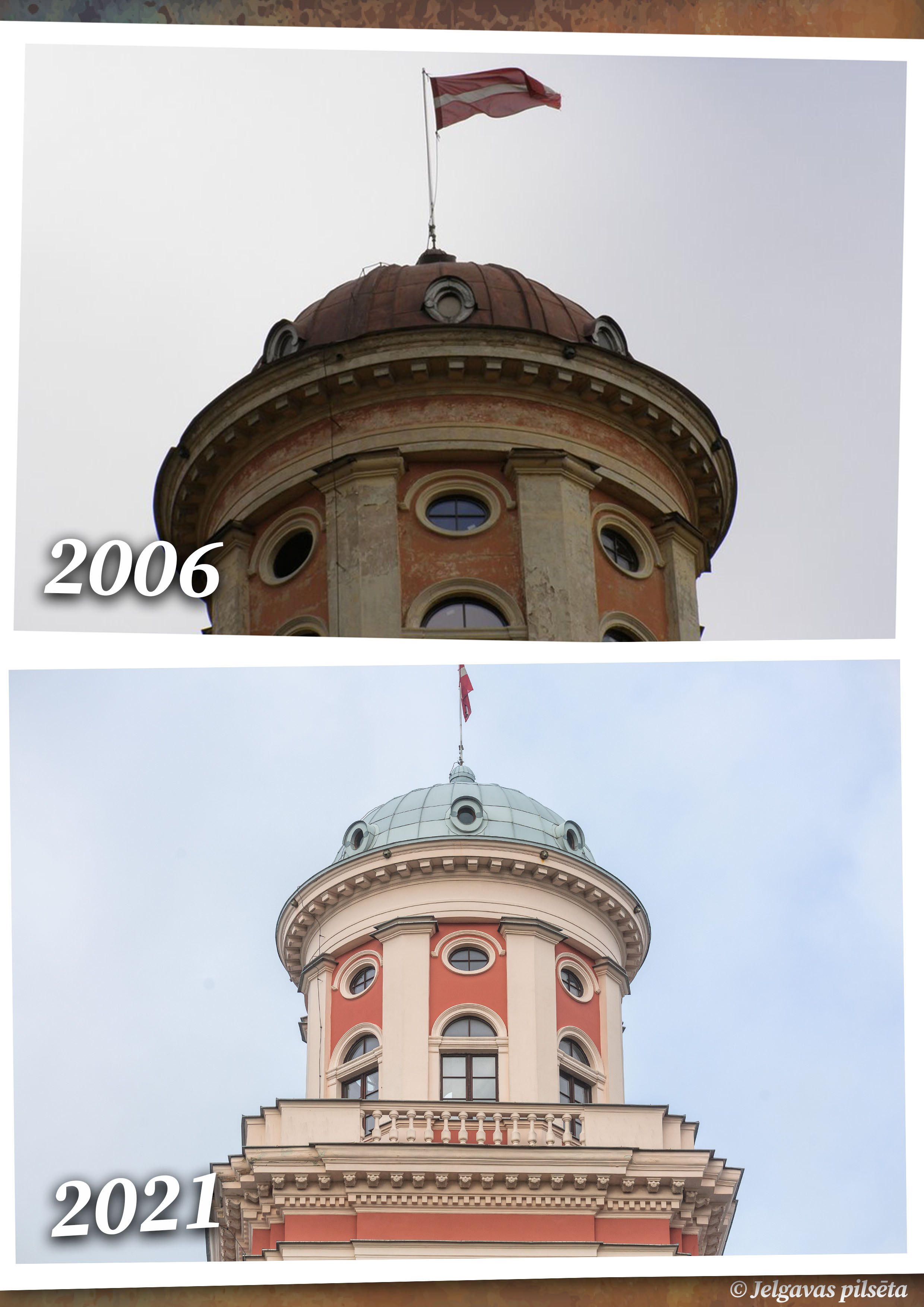
In 2018, the roof of the museum building was replaced – the obsolete tin roof was replaced with a galvanized tin roof, which visually corresponds to the historical one. In addition, the attic was insulated, thus reducing heat loss.
This year, in order to improve the accessibility of the building environment, an elevator to the second floor will be built in G. Elias Jelgava History and Art Museum.
Since the middle of the 20th century, the museum has been a continuation of the traditions and heritage custodian of the Kurzeme Provincial Museum, the second oldest museum in Latvia, destroyed in the Second World War, which has been proud of the outstanding Latvian painter G. Elias for more than 40 years.

In 2020, the almost two-year-long construction works on Neretas, Prohorova and Garozas streets were completed, arranging the degraded territory in the Depo district. New infrastructure has been built there, creating an industrial zone to increase business potential in this part of the city.
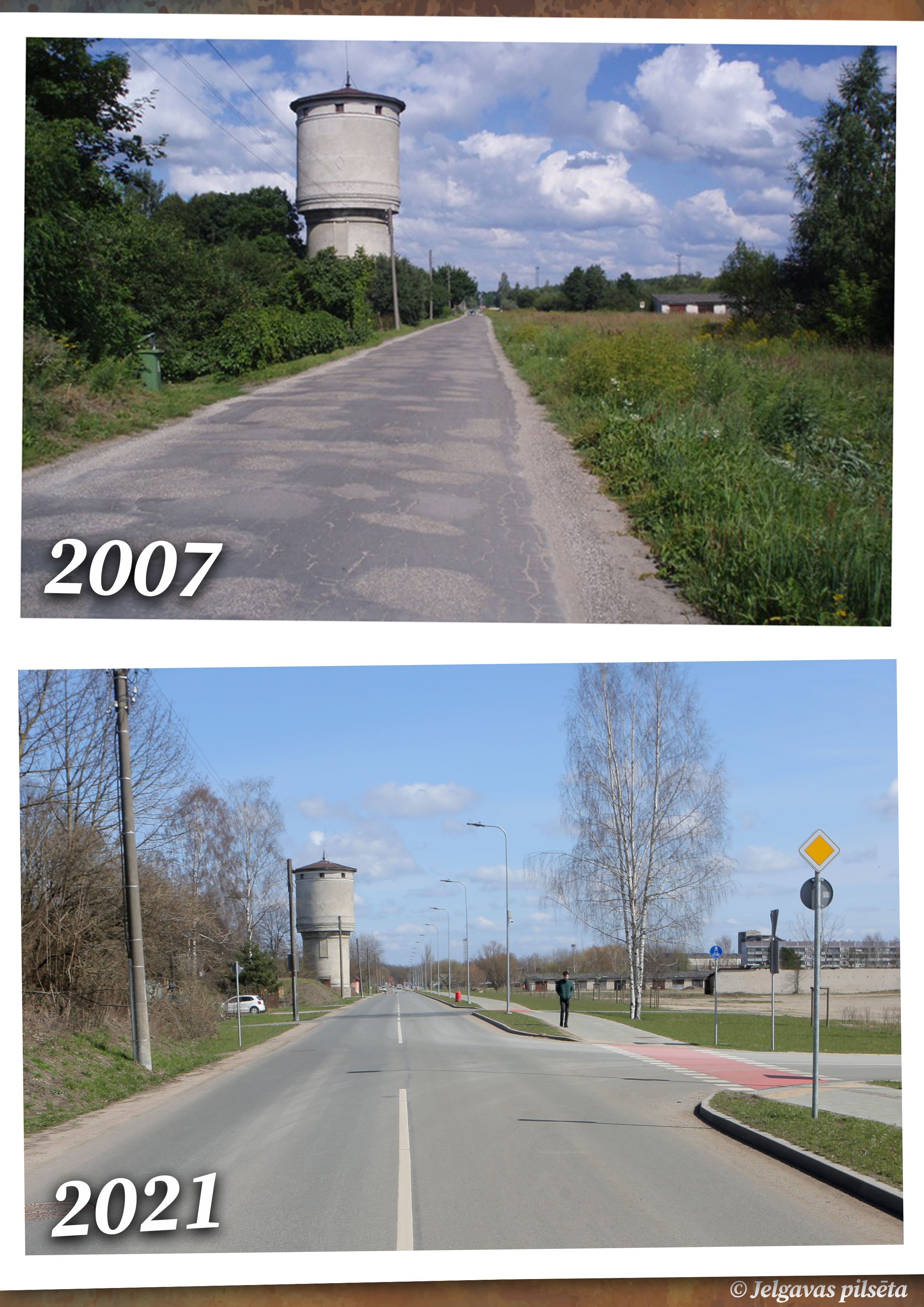
During the construction works, communications were changed, the street surface was renewed, increasing the load-bearing capacity of the carriageway, thinking about the safety of the residents, lighting was modernized and video surveillance cameras were installed, bus stops were arranged.
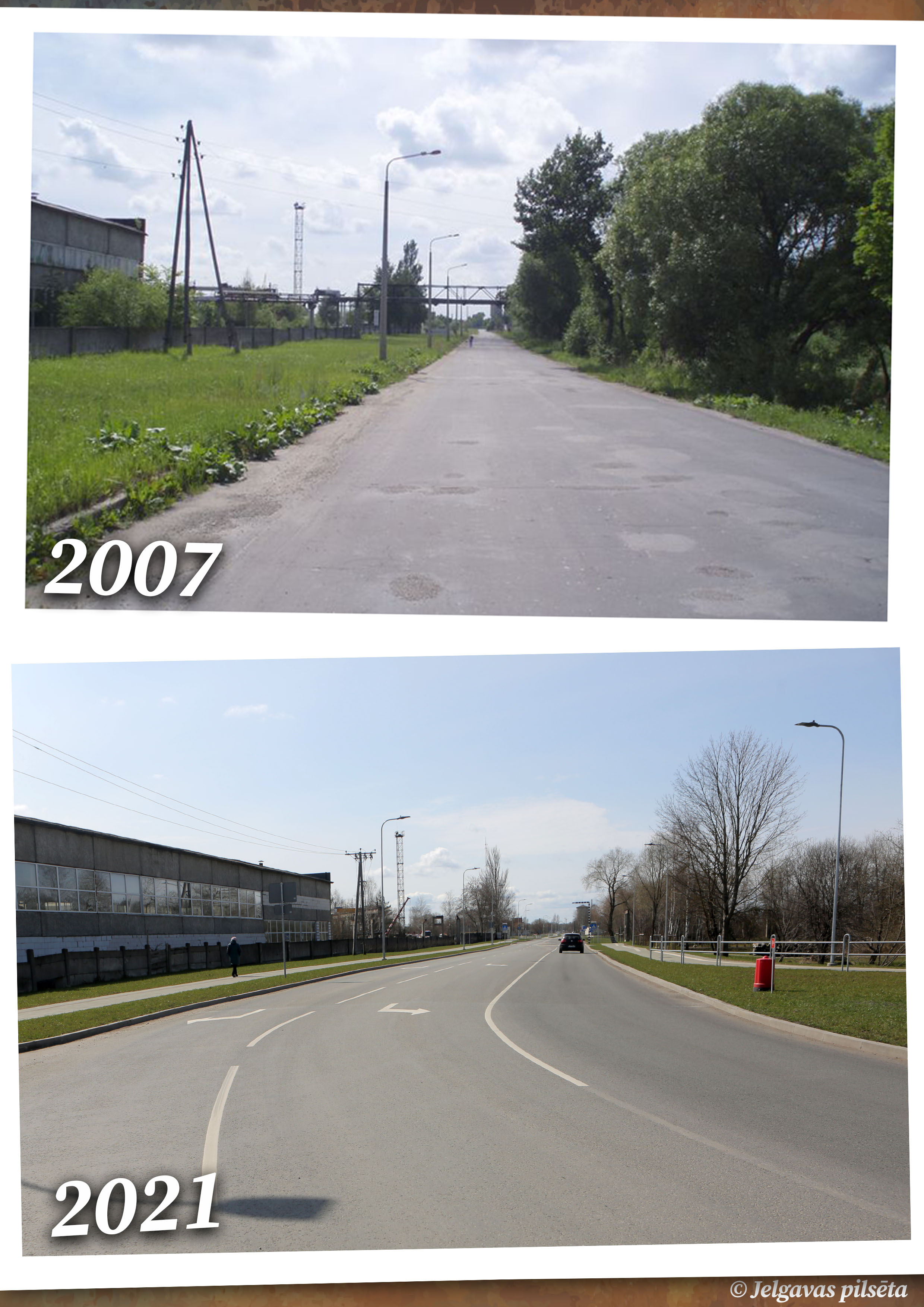
In order to draw the attention of drivers to pedestrians and cyclists, a special red pavement has been installed at the entrances to Prohorova Street. There are also recreation areas on the sidewalks with bicycle stands, benches and waste bins.
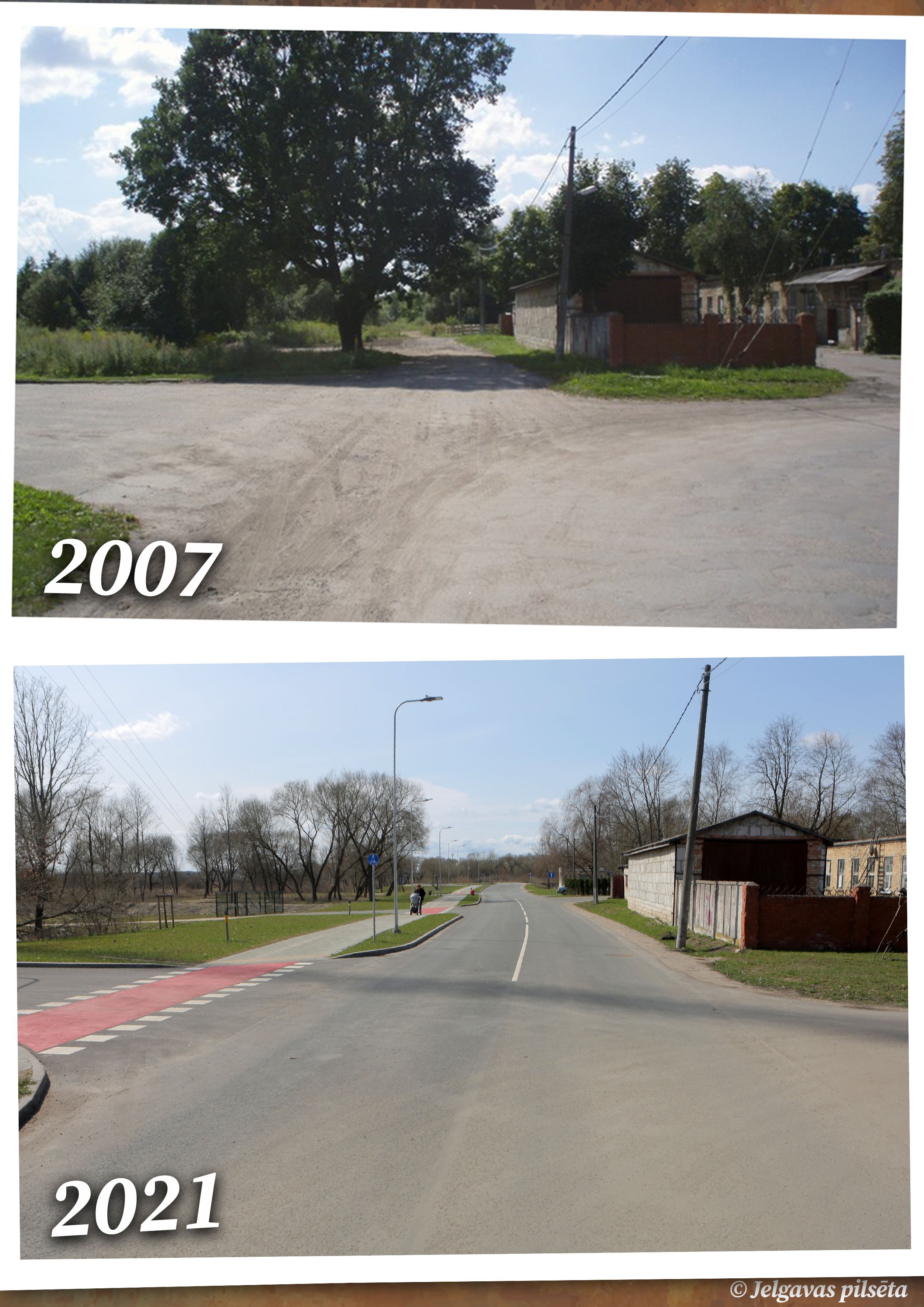
Bearing in mind safety near the railway, lockable labyrinths of protective barriers have been created at Prohorova Street at railway crossings, which slow down the movement of pedestrians and cyclists.

With the aim of making Pasta Island a multifunctional place for recreation, culture and social activities, creating Lielupe and Driksa as a product of tourism and active recreation and promoting the development of a modern and attractive living environment in the center of Jelgava, in 2012 the improvement of Pasta Island was started.
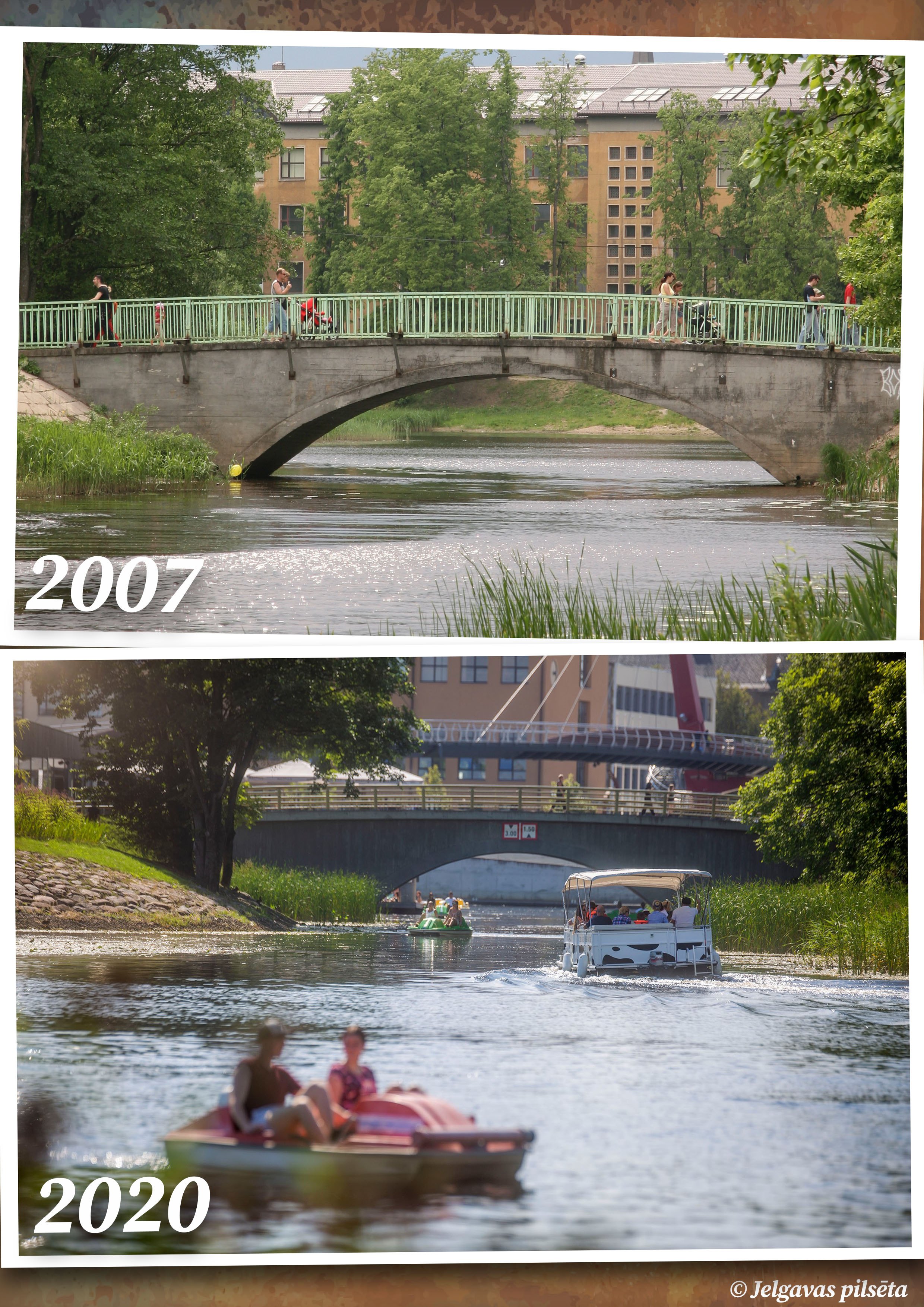
Pasta Island is a nine-hectare unique urban object in the center of Jelgava, which is part of the ensemble not only with the reconstructed Jānis Čakste boulevard, sculpture fountain “Jelgava student”, Mītava bridge and the landscaped Lielupe beach, but also with the Holy Trinity Church tower and Jelgava castle. The infrastructure of the Pasta Island has been supplemented later, and now the island has become a popular place for leisure, entertainment and active recreation for Jelgava residents and city guests.
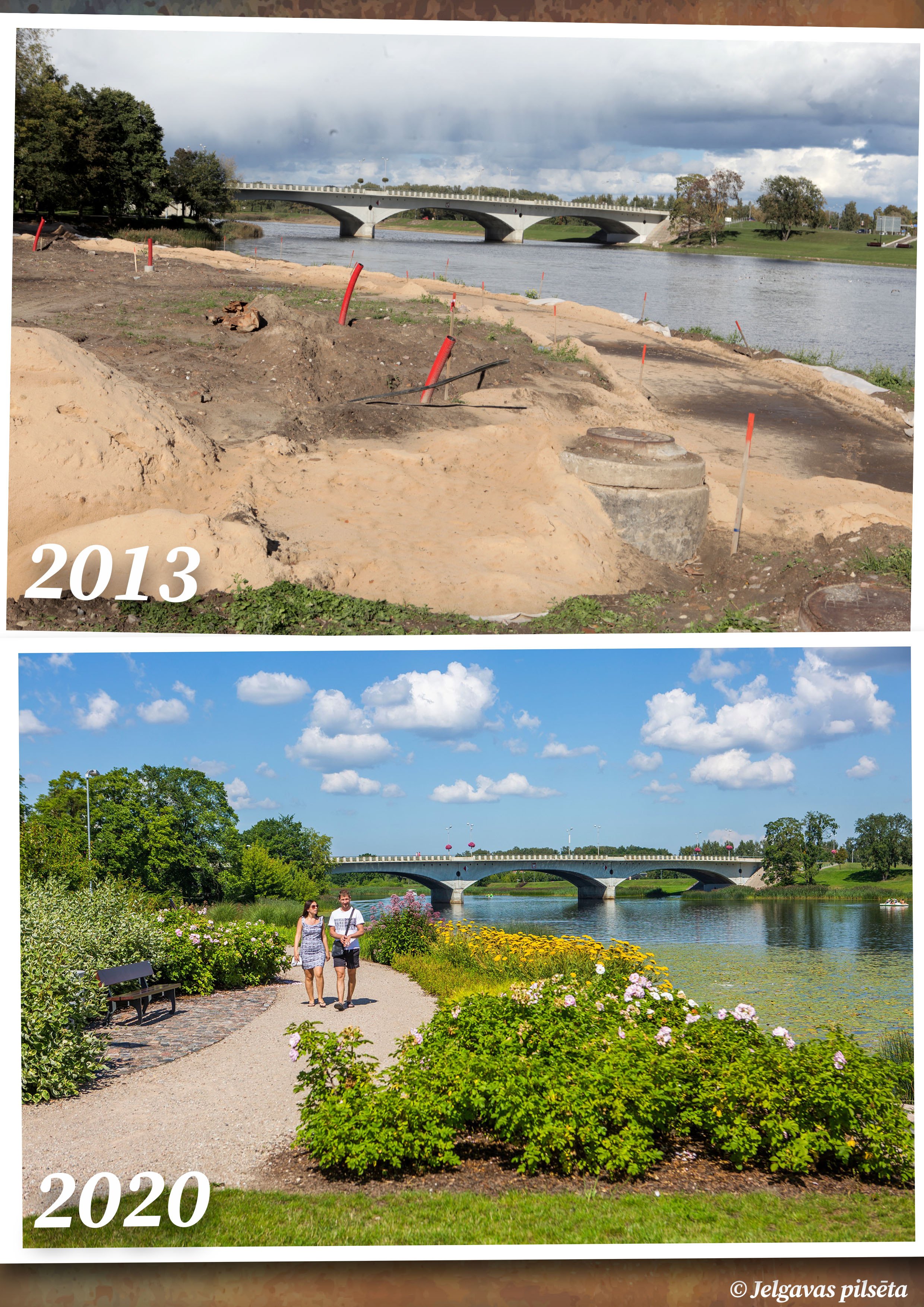
The island has well-maintained recreation areas with 2.8 kilometers of pedestrian and bicycle paths, nature trails, benches, lighting, beach volleyball and outdoor gyms, children’s playgrounds, event areas, as well as an open-air concert hall “Mītava”, a covered public skating rink and sand sculpture park, where the International Sand Sculpture Festival traditionally takes place. There is also a well-maintained swimming area on the bank of the Lielupe river on Pasta Island.
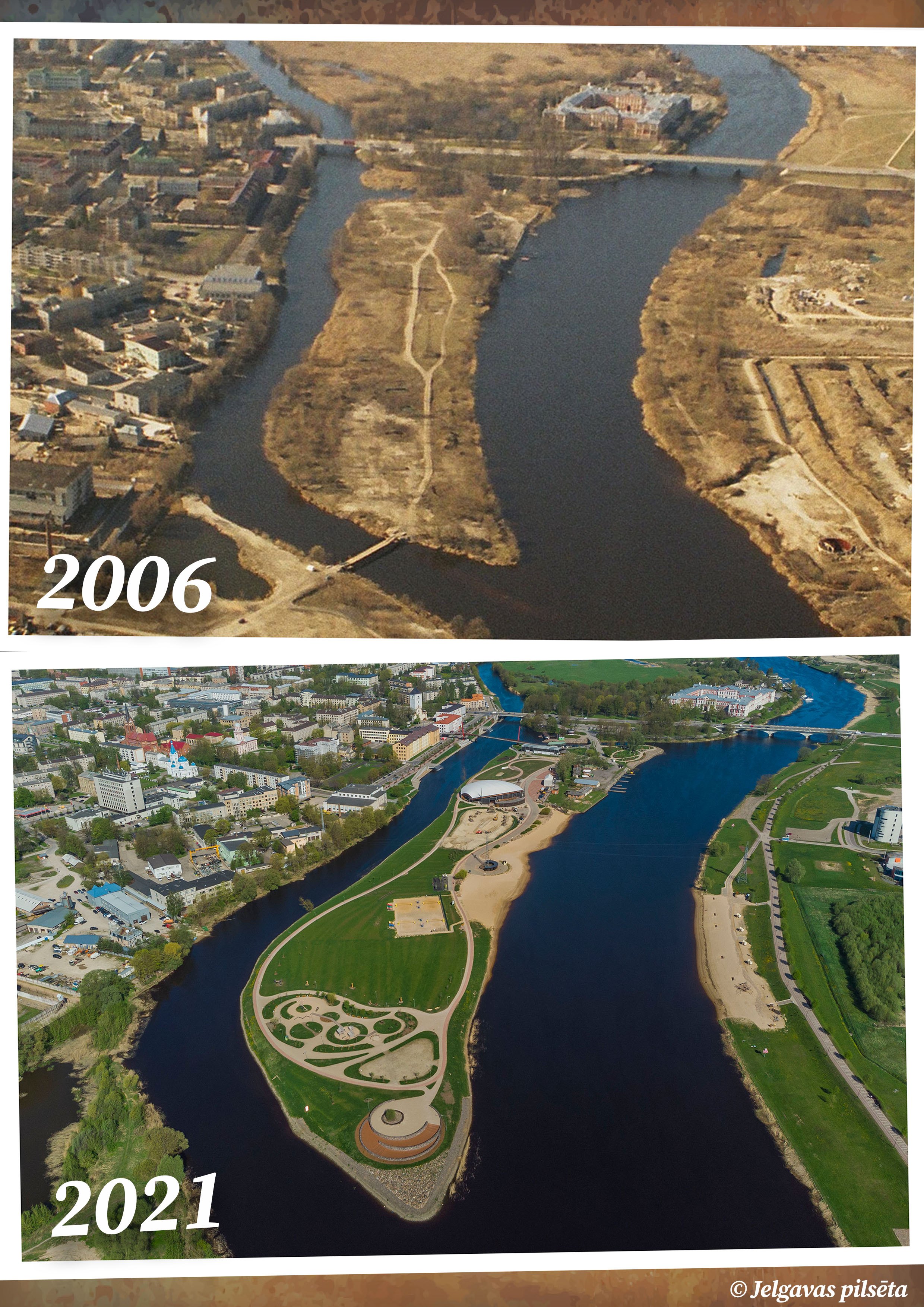
To protect the island from the threat of floods, 120,000 cubic meters of soil have been buried there. With 2,000 cubic meters of boulders and wire meshes – gabions – the shores of the island are secured, thus preventing their leaching.
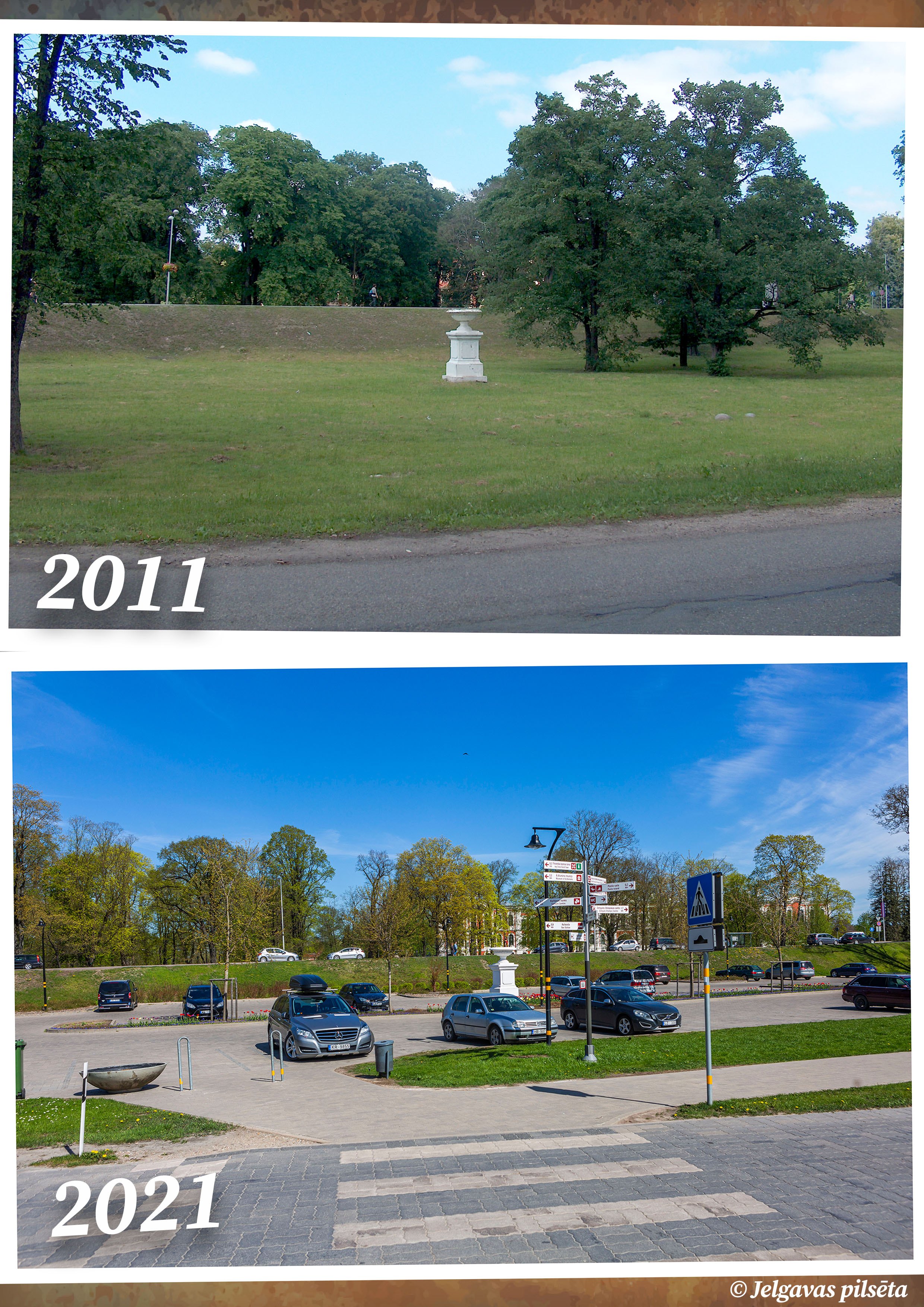
In 2015, the facilities of the Pata Island were recognized as the best in the nomination “Public Outdoor Space” of the competition “Latvian Construction Annual Award 2014”. In turn, in 2019, Pasta Island won the second place in the nomination “Sustainable public outdoor space” in the competition “Sustainability in architecture, construction, design 2019”.
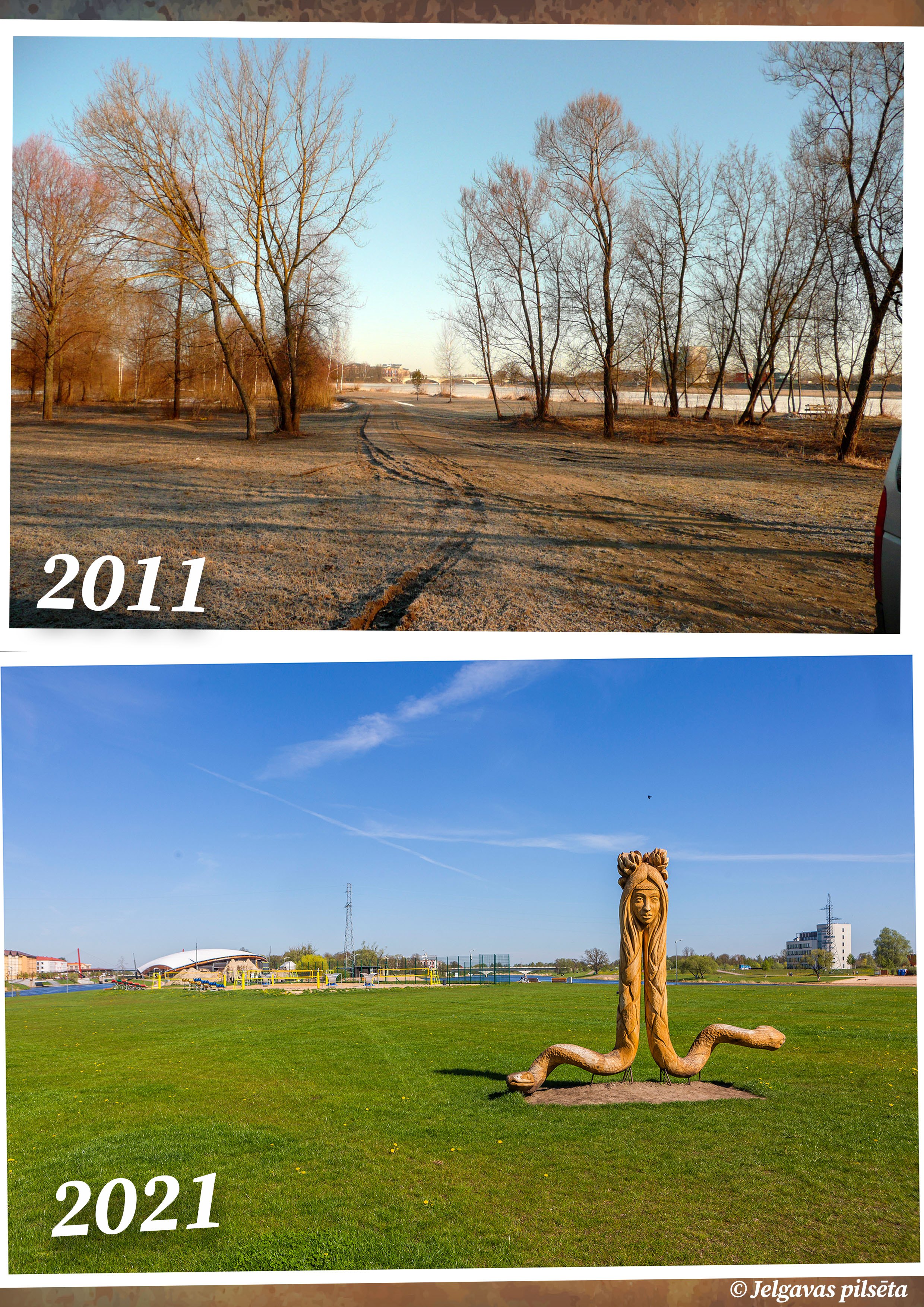
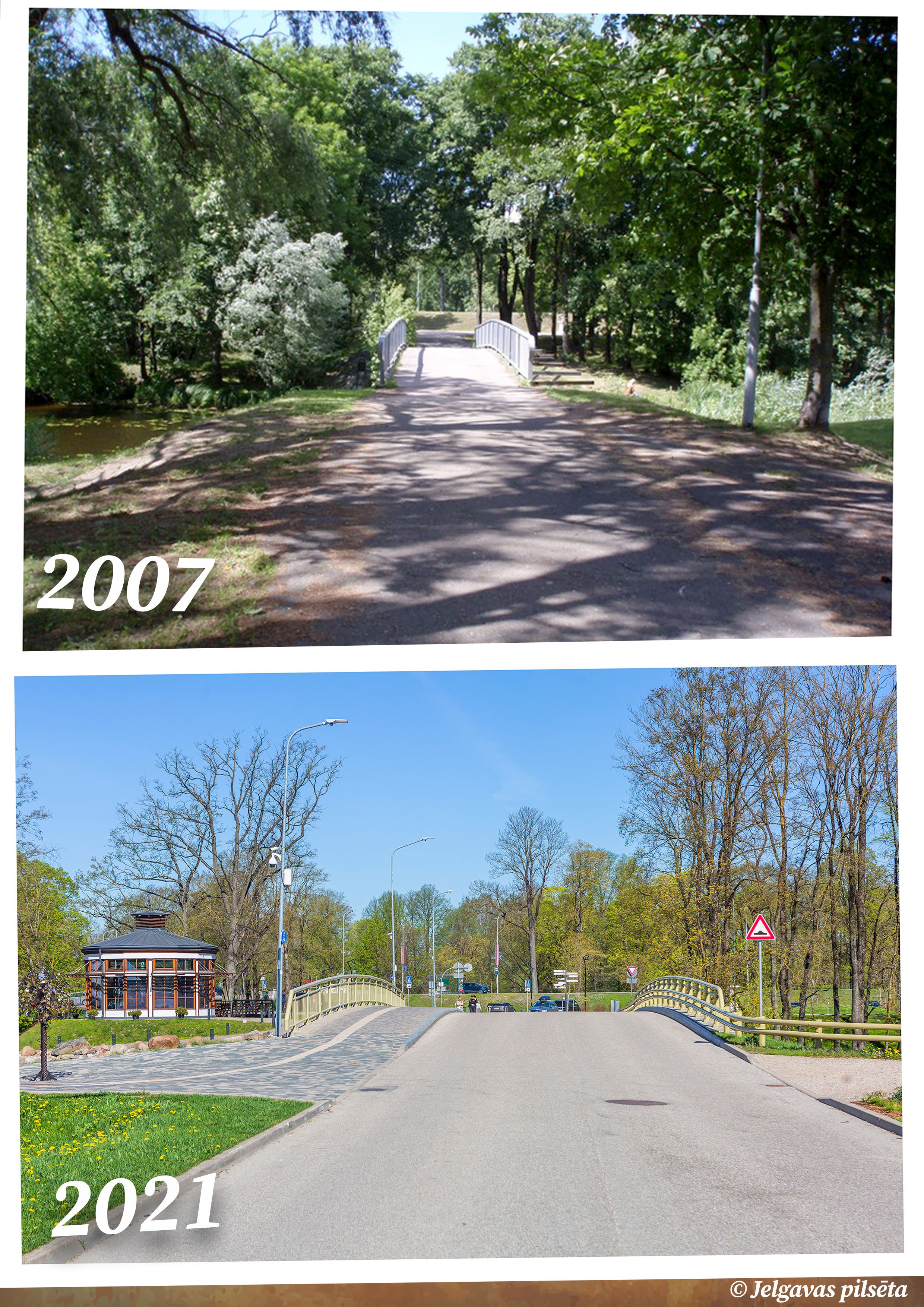
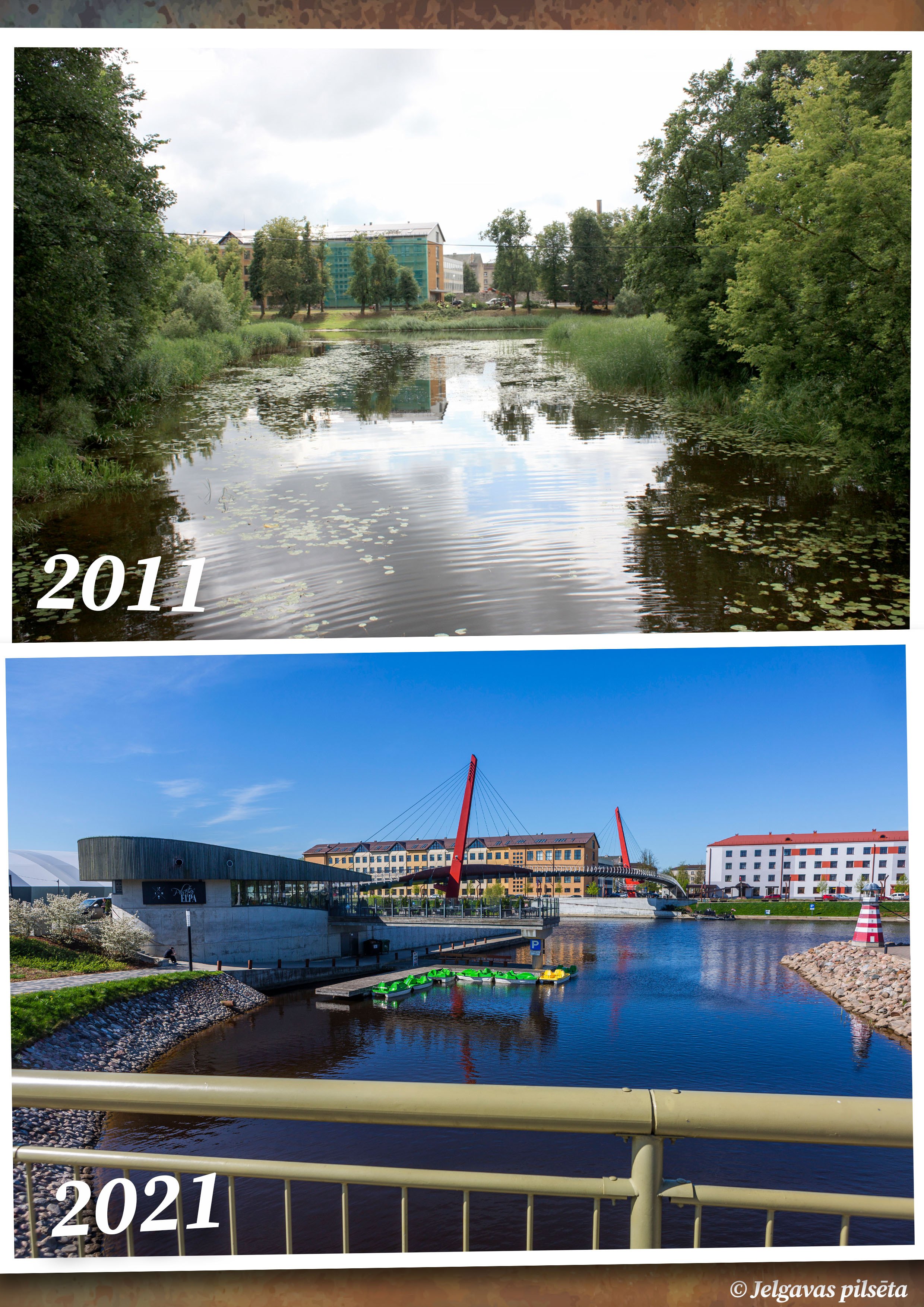
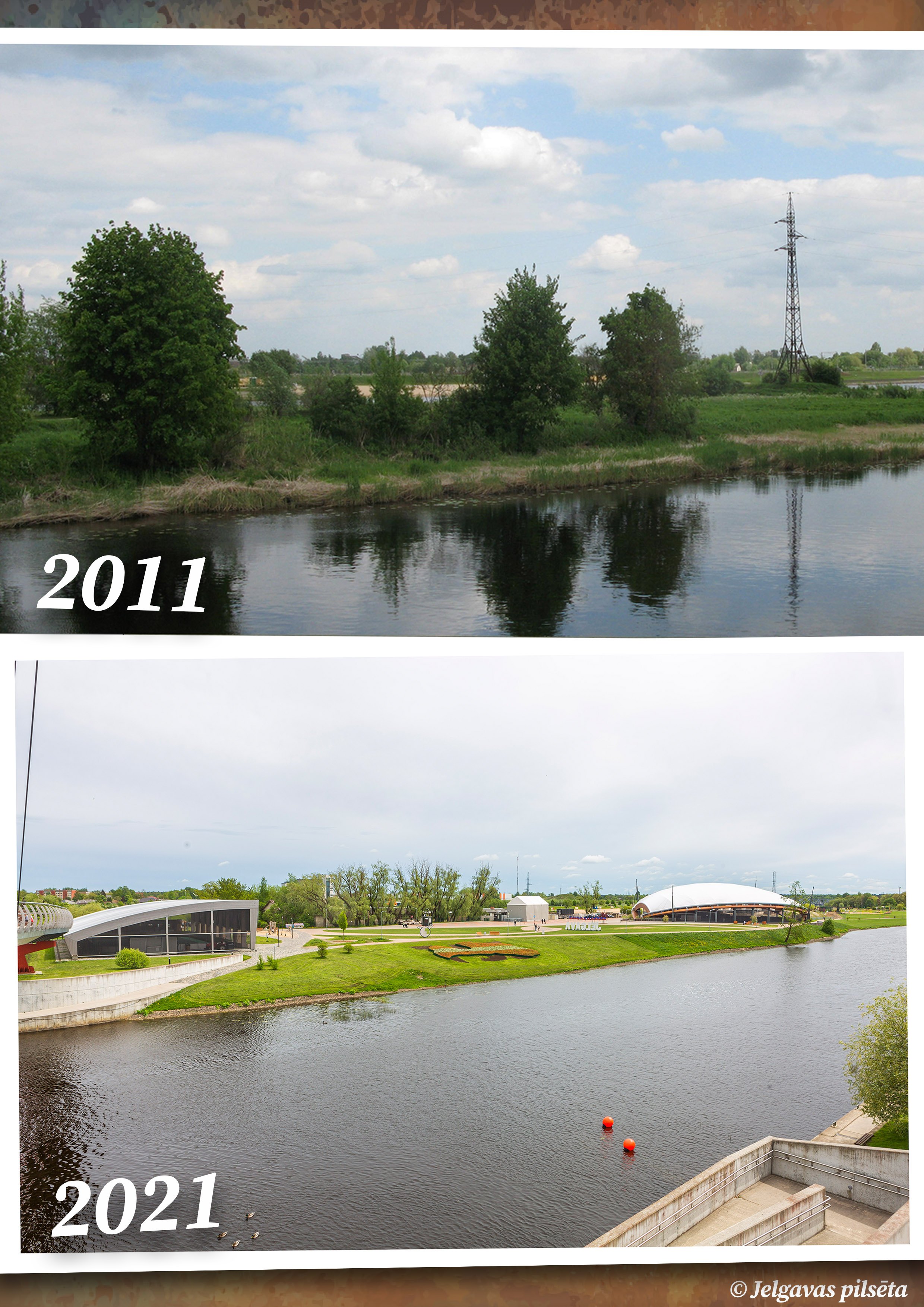
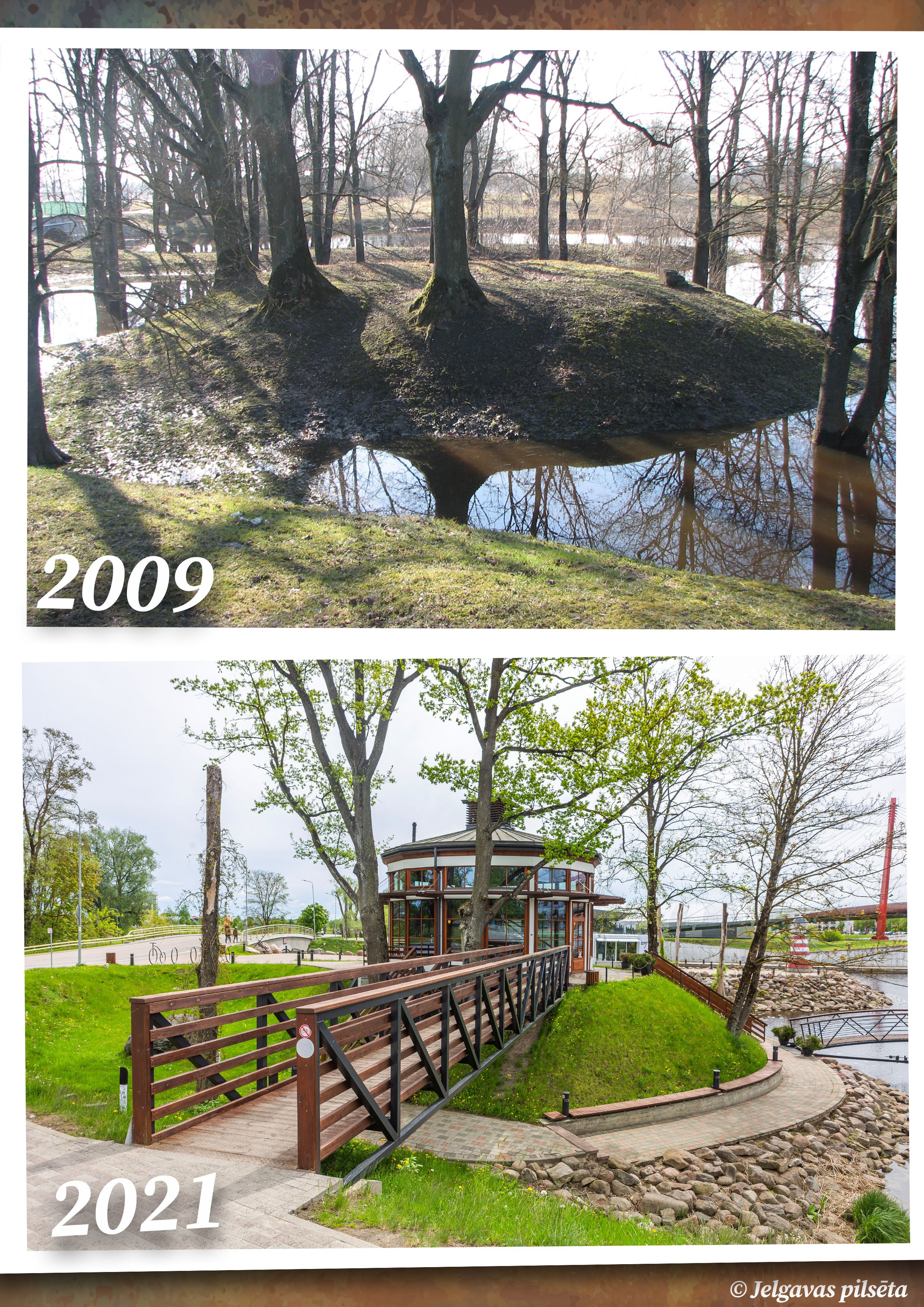

In 2011, the insulation of the building at 9 Pulkveža Oskara Kalpaka Street was started. The building houses the Jelgava City Municipal Institution “Jelgava Social Affairs Department”, “Jelgava City Orphan’s Court”, a social dwelling House, group apartments and a night shelter.
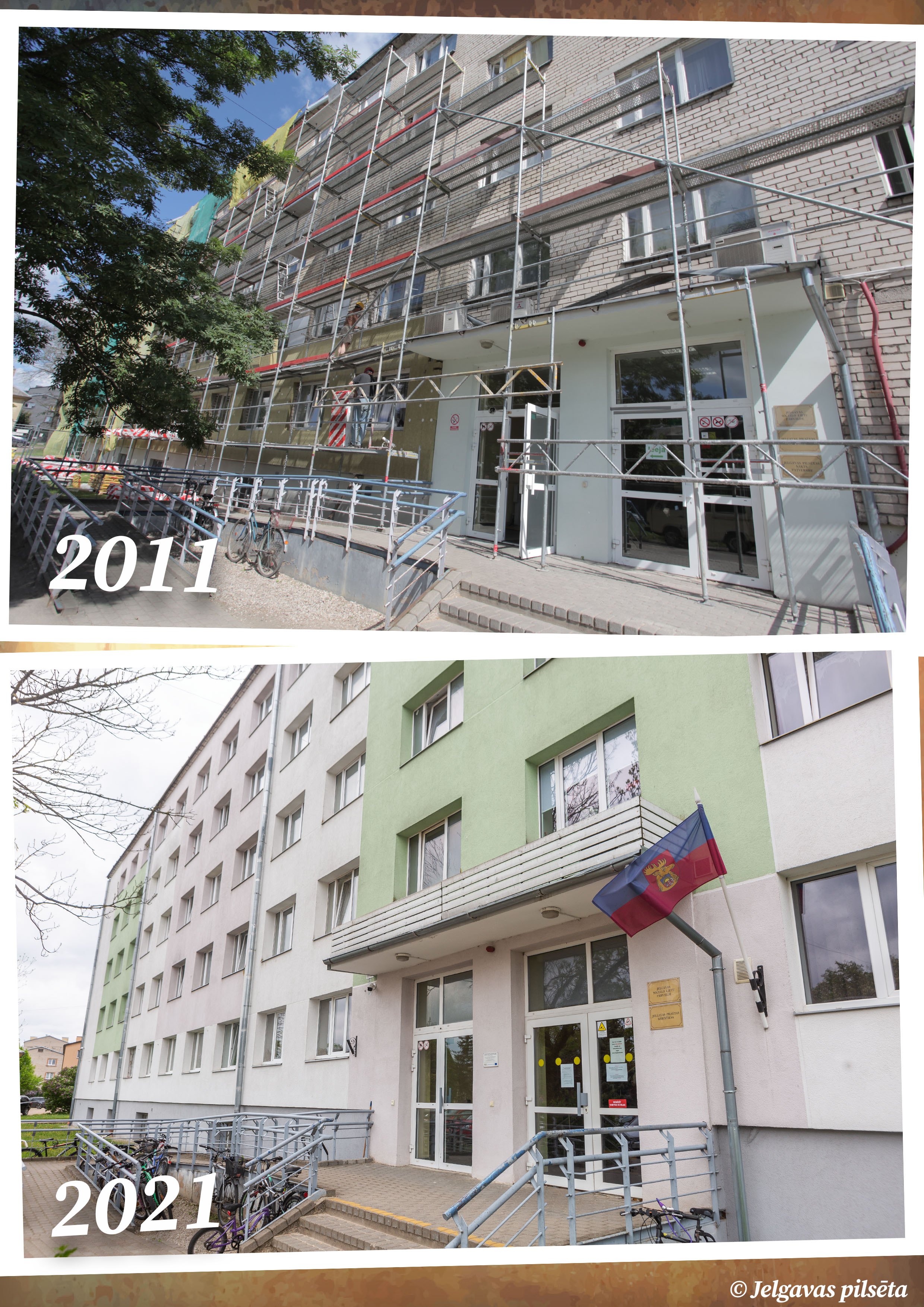
During the works, the windows of the apartments, staircases and basement were replaced, the attic cover, the outer walls of the plinth and basement, the facade of the building were insulated with appropriate materials, as well as the electrical installation and ventilation system were renovated.

In 2012, the territory was improved, including the construction of a parking lot for 57 cars. Due to the limited parking time in the parking lot, there are two video cameras at each of the two entrances to the lot, which record the number of both incoming and outgoing vehicles. This allows you to control the parking time.
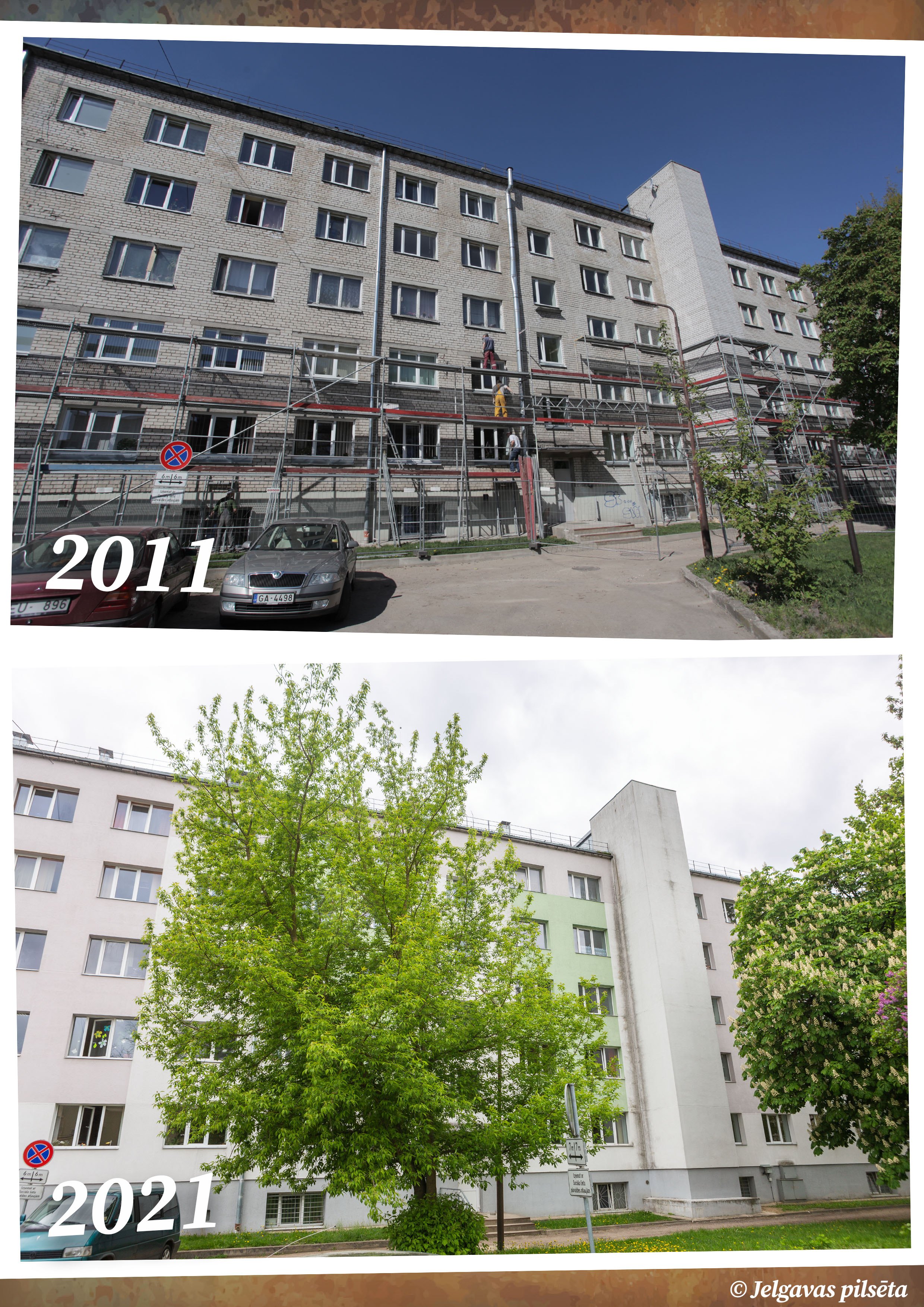

In 2010, the reconstruction of the intersections of Rūpniecības and Filozofu streets and Atmodas and Dambja streets was completed.
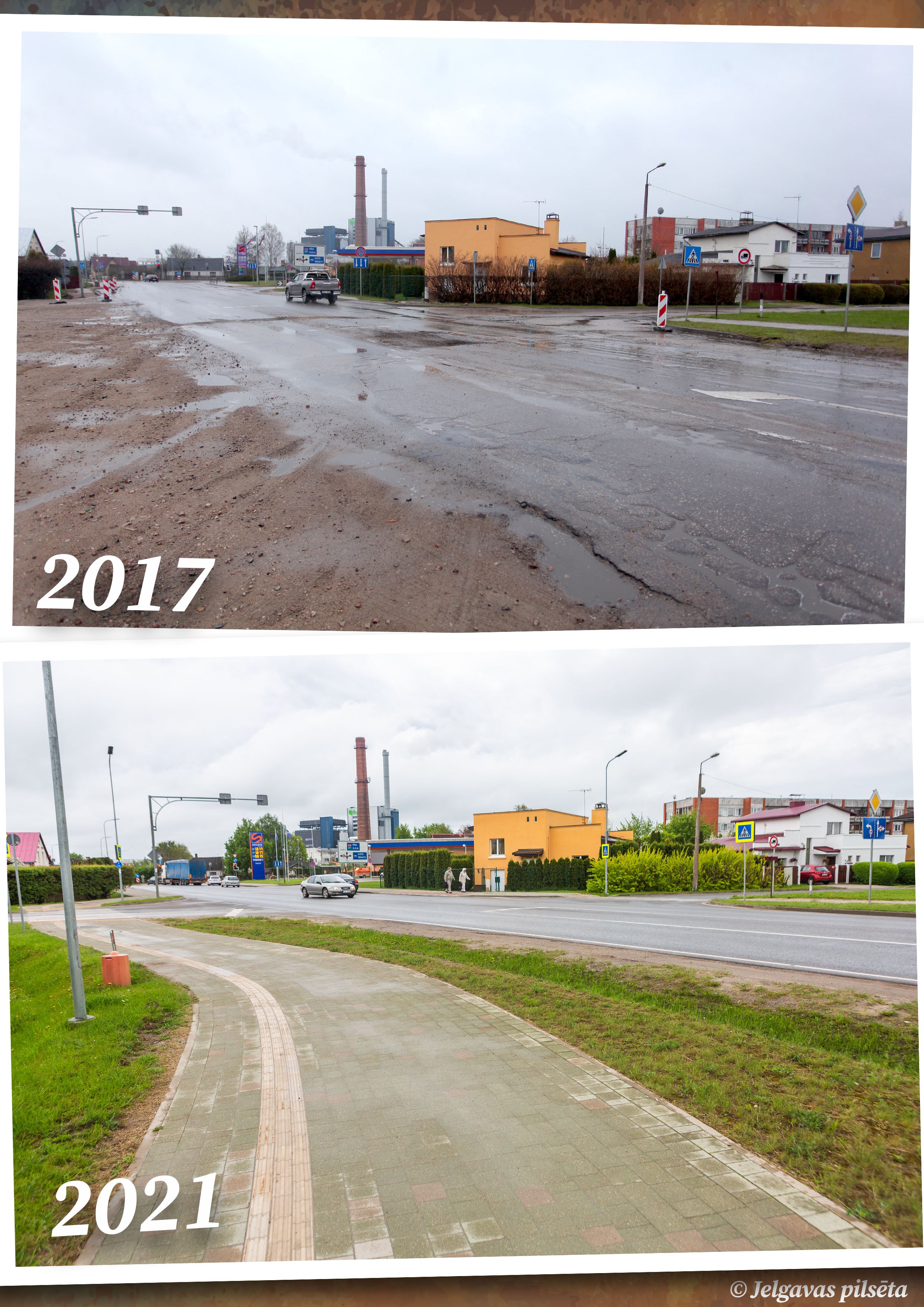
During the works, traffic lights were built, pedestrian traffic lights were additionally equipped with sound signals, pedestrian green light call buttons and infrared traffic motion detection cameras.
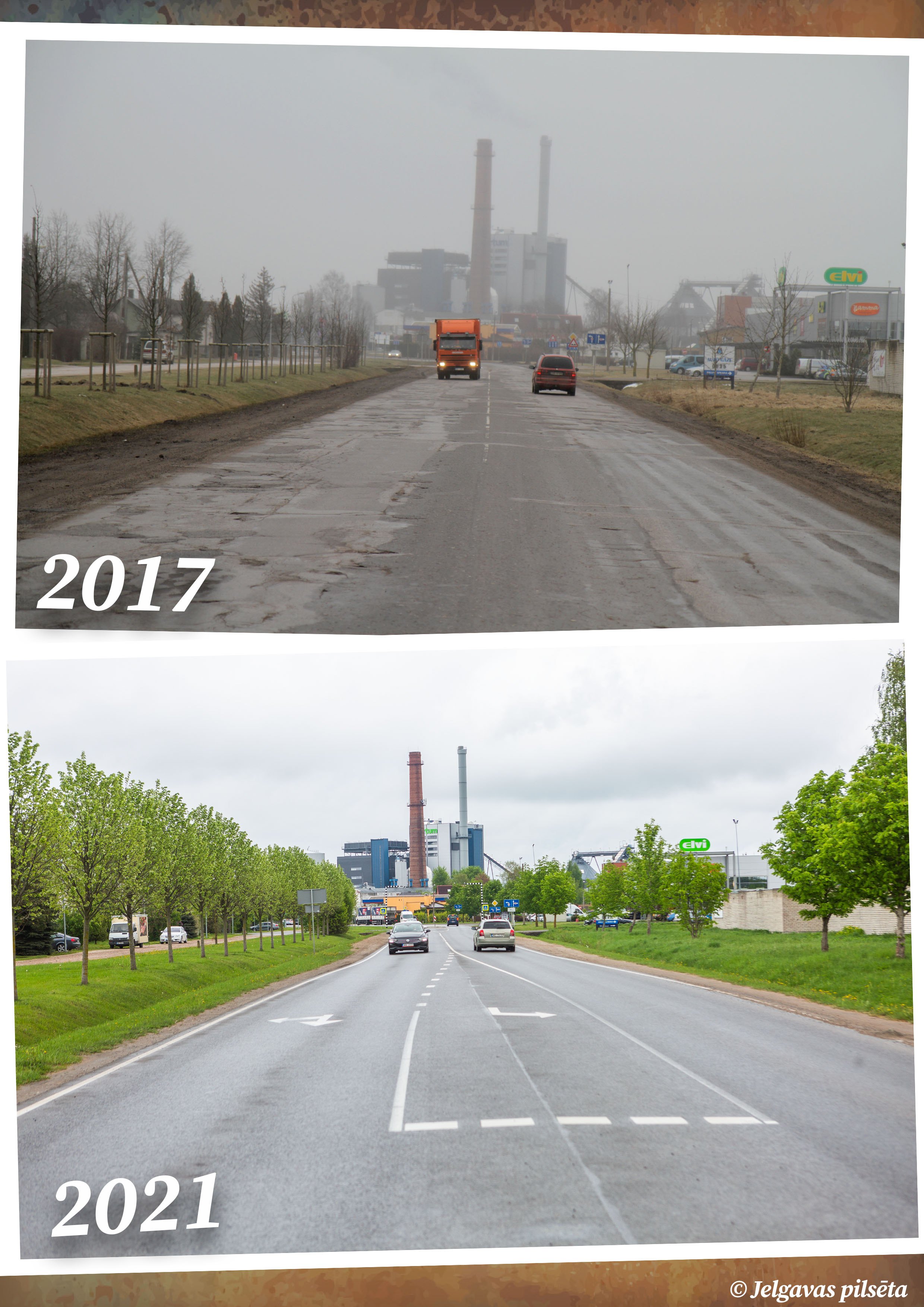
The street lighting has also been reconstructed, a sidewalk for pedestrians and cyclists has been built between the intersections and the road surface has been restored, pedestrian barriers have been installed, gullies and culverts have been built and bus stops have been reconstructed.
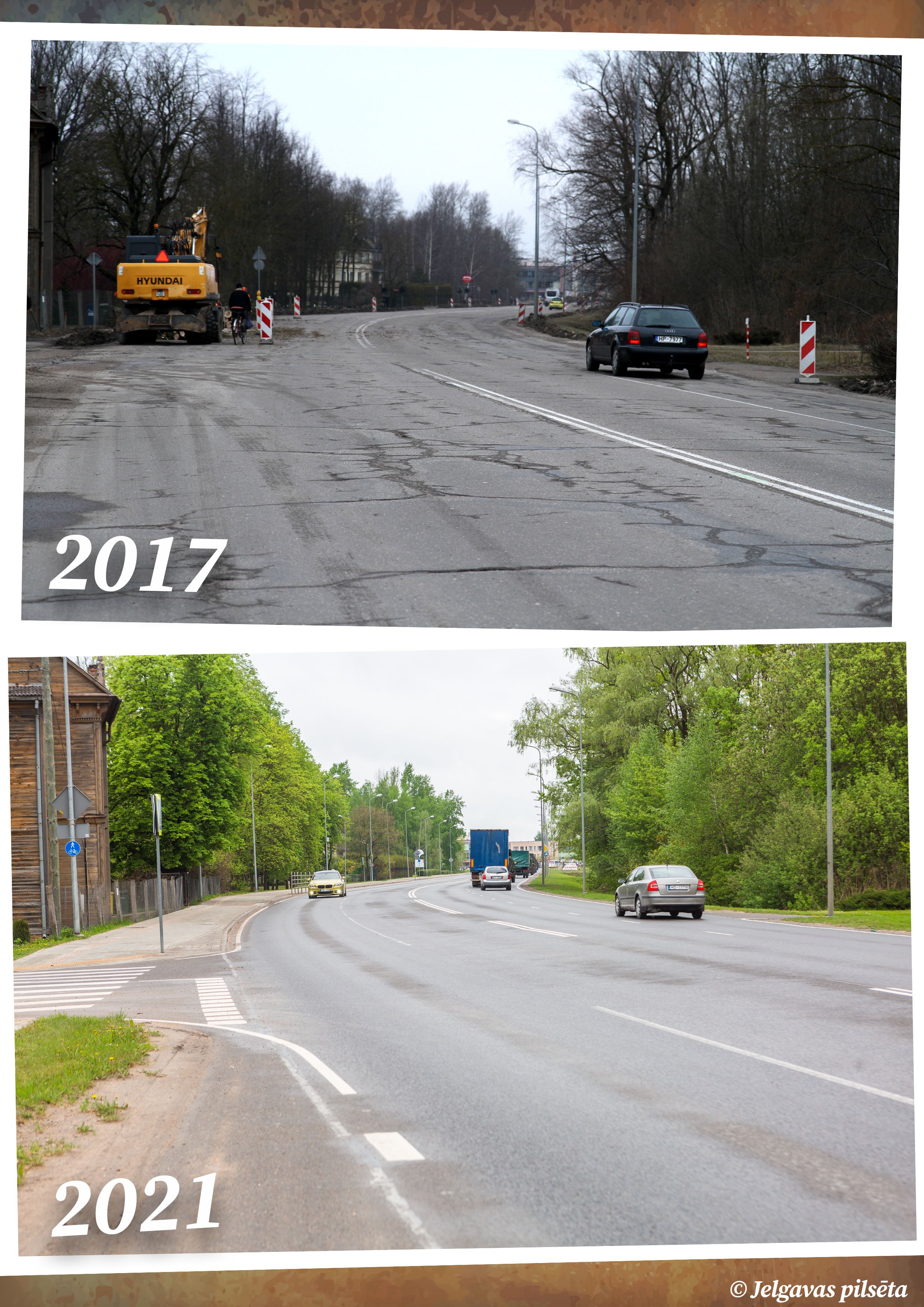
In 2017, in the section of Atmodas Street from Dobeles highway to Dambja Street and in the section of Rupniecibas Street from Dambja Street to Tērvetes Street, the street infrastructure was improved – the road surface was restored, a pedestrian sidewalk was created in the section of Atmodas Street from Dobele Highway to Dambja Street. In the intersection of Atmodas and Asteru Street a regulated pedestrian crossing has been created, but opposite the store “Elvi” – an unregulated pedestrian crossing.
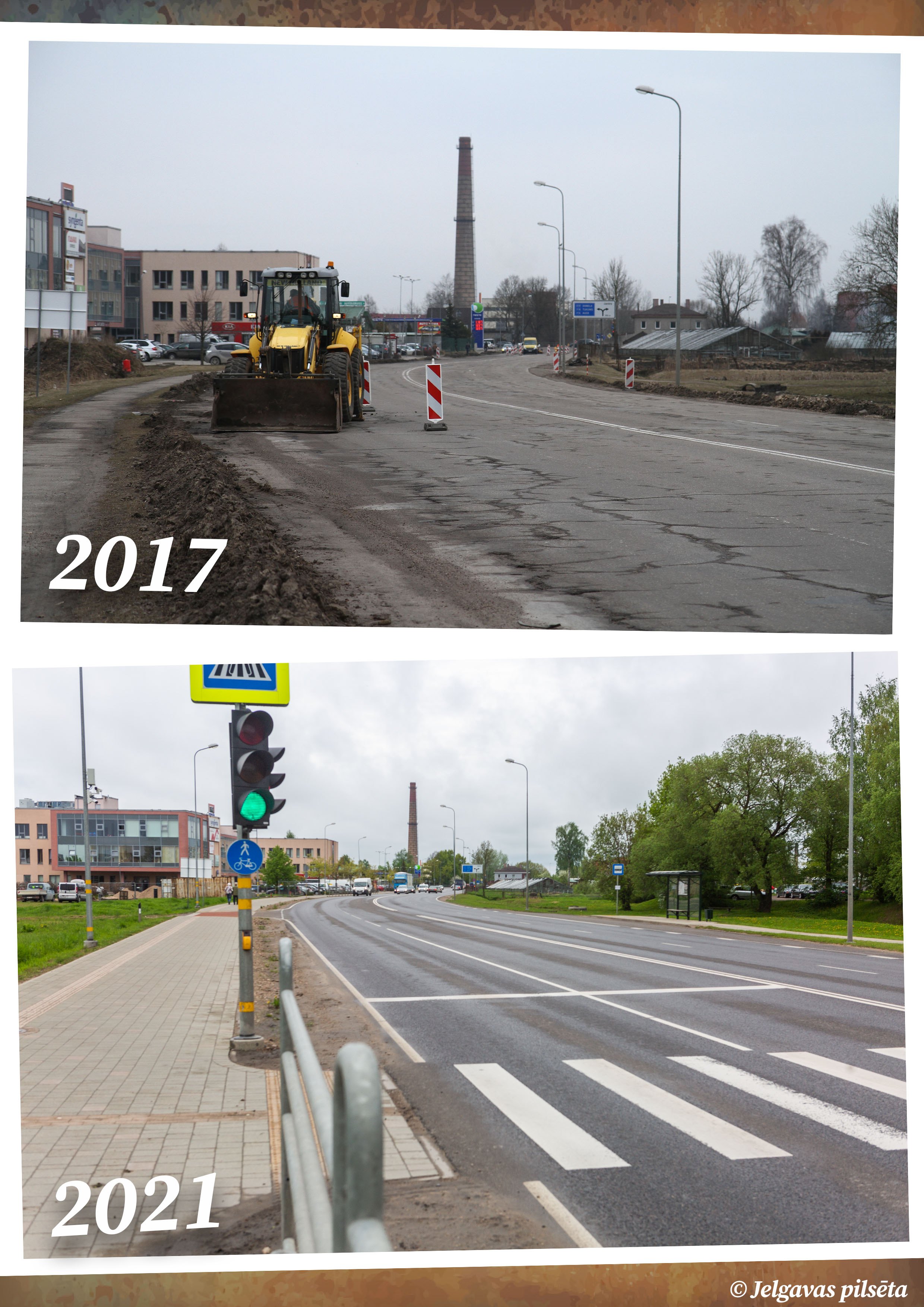
In the section of Rūpniecības Street from Vīgriežu to Filozofu Street, street lighting has been reconstructed along the parallel gravel road. At the same time, rainwater sewerage and other underground communications have been arranged, as well as the rainwater sewage pumping station has been renovated.
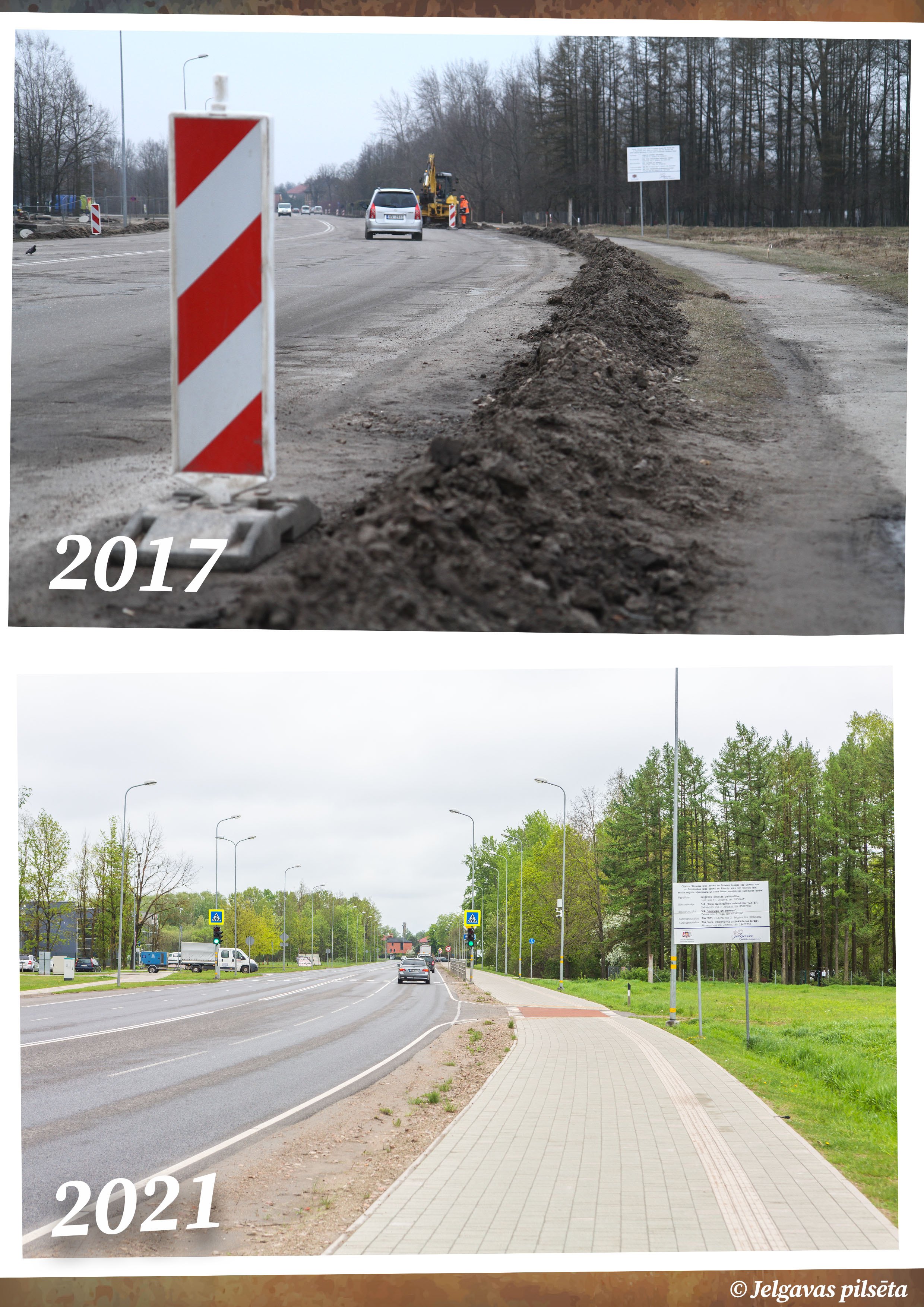

The construction project of the Zemgale Olympic Center was started in 2007, and in 2008 a foundation stone with a message for the future was laid on the construction site of the multifunctional sports complex.
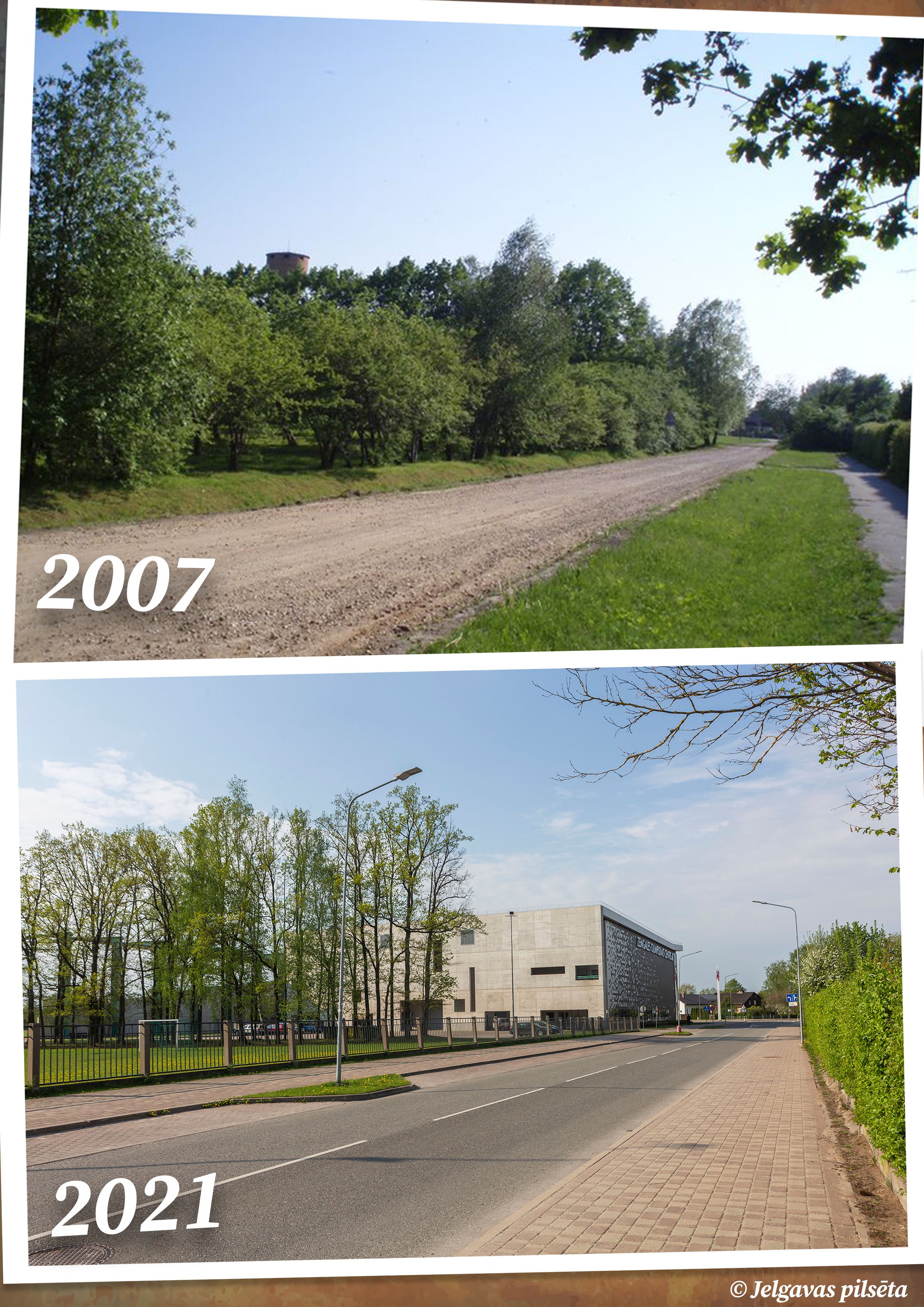
In 2010, the Zemgale Olympic Center was opened with a friendly match between the 2010 Latvian Cup winner Jelgava football club “Jelgava” and the English Premier League football club “Blackpool”.
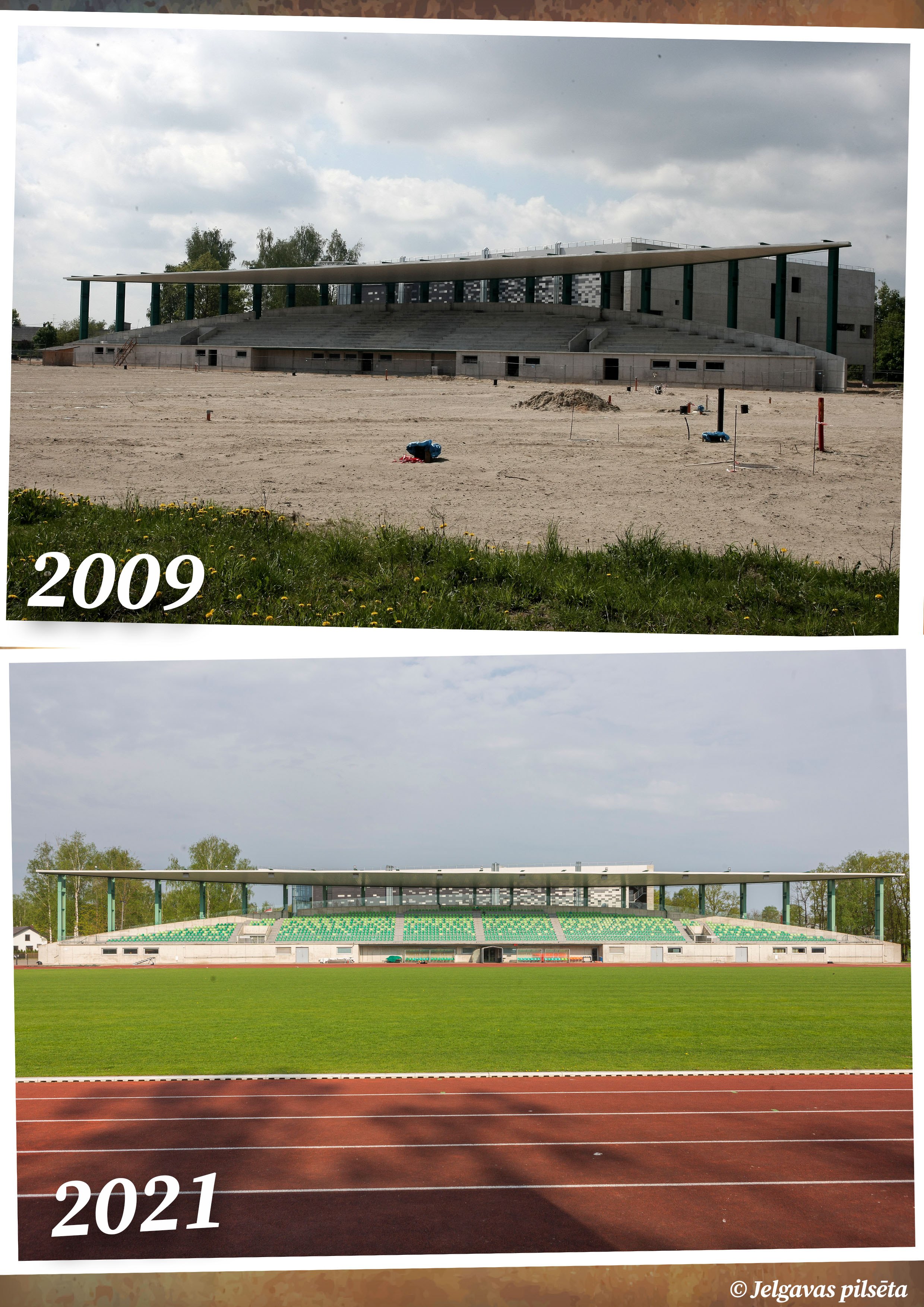
The area of Zemgale Olympic Center is 61,520 square meters. It has an International Athletics Federation (IAF) compliant athletics stadium with athletic track and sectors for various sports, FIFA-compliant two football pitches – natural and artificial – and an open sports field. The stadium stands with 1,500 seats. In turn, the multifunctional sports hall houses a two-part transformable gym with 2,500 seats, which meets the requirements of the International Basketball Federation (FIBA).
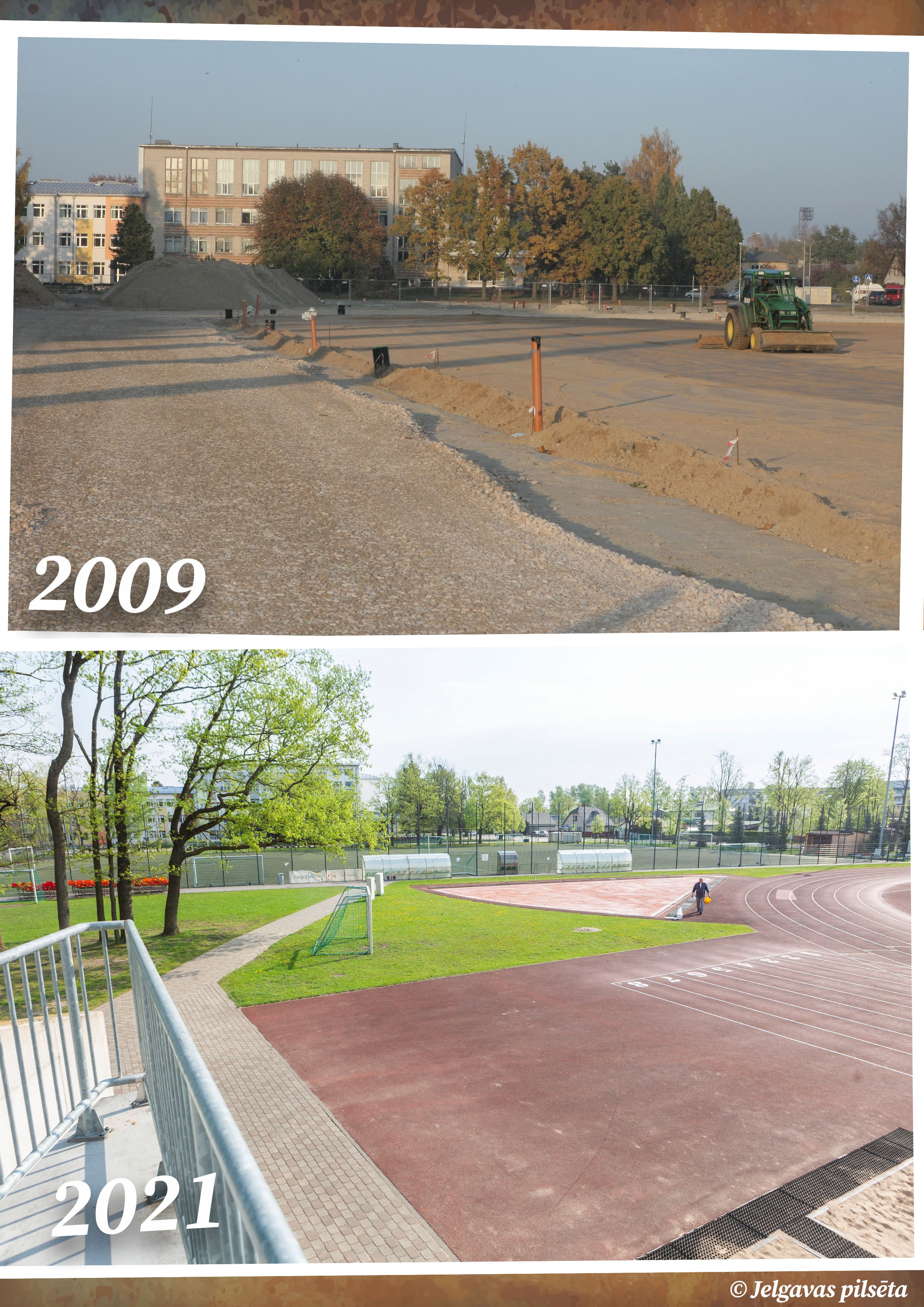
In the course of the project, a modern BMX track has also been built, where international competitions can take place.
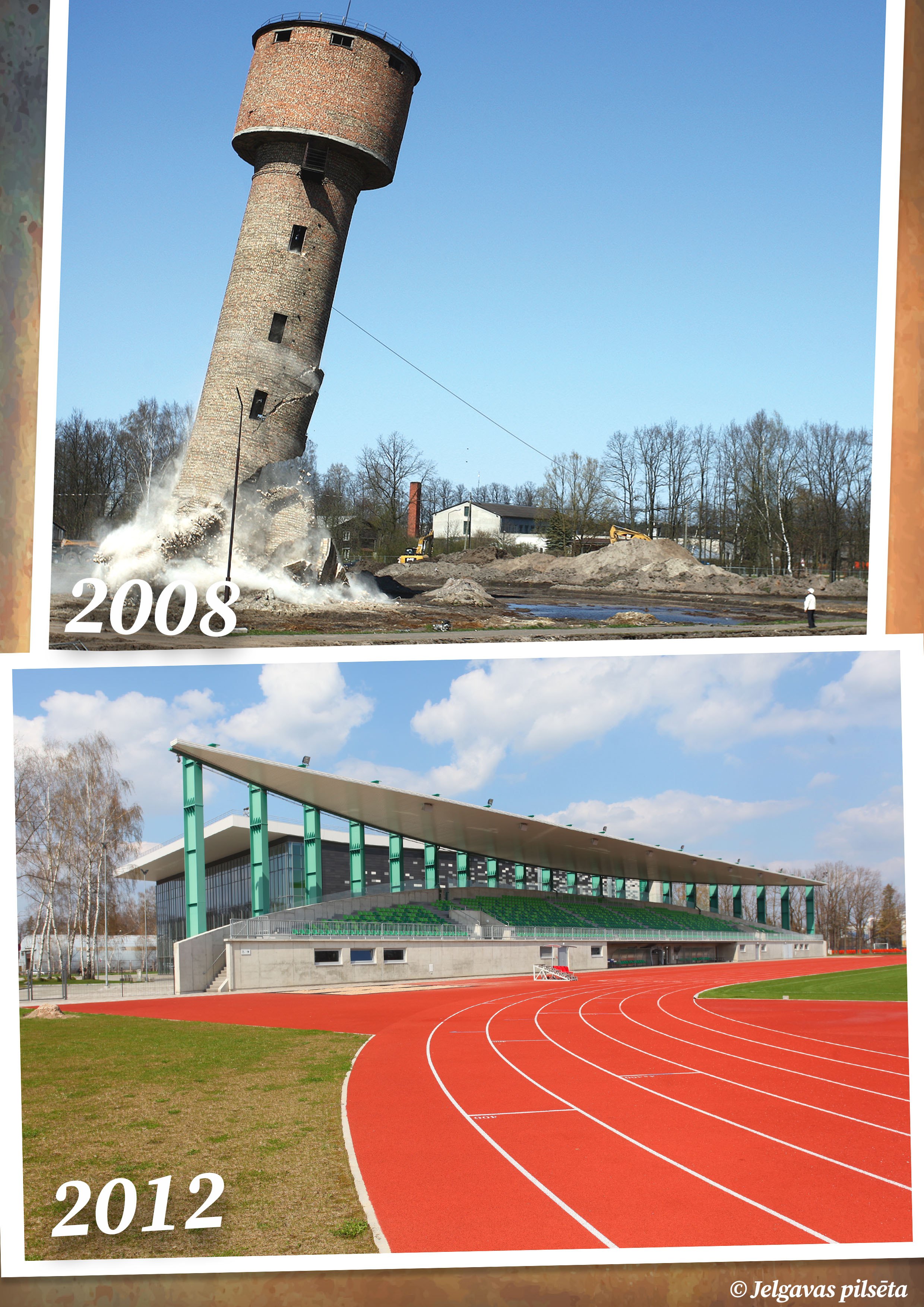
The motto of Zemgale Olympic Center: “Ready! Ready! Go!”

In 2018, the improvement of Pilssala was started, including the construction of a wooden observation tower, the creation of a 2,900-meter-long health trail, the improvement of the recreation area at the foot of the tower, the main road from the entrance gate to the observation tower and fencing to prevent wild horses.
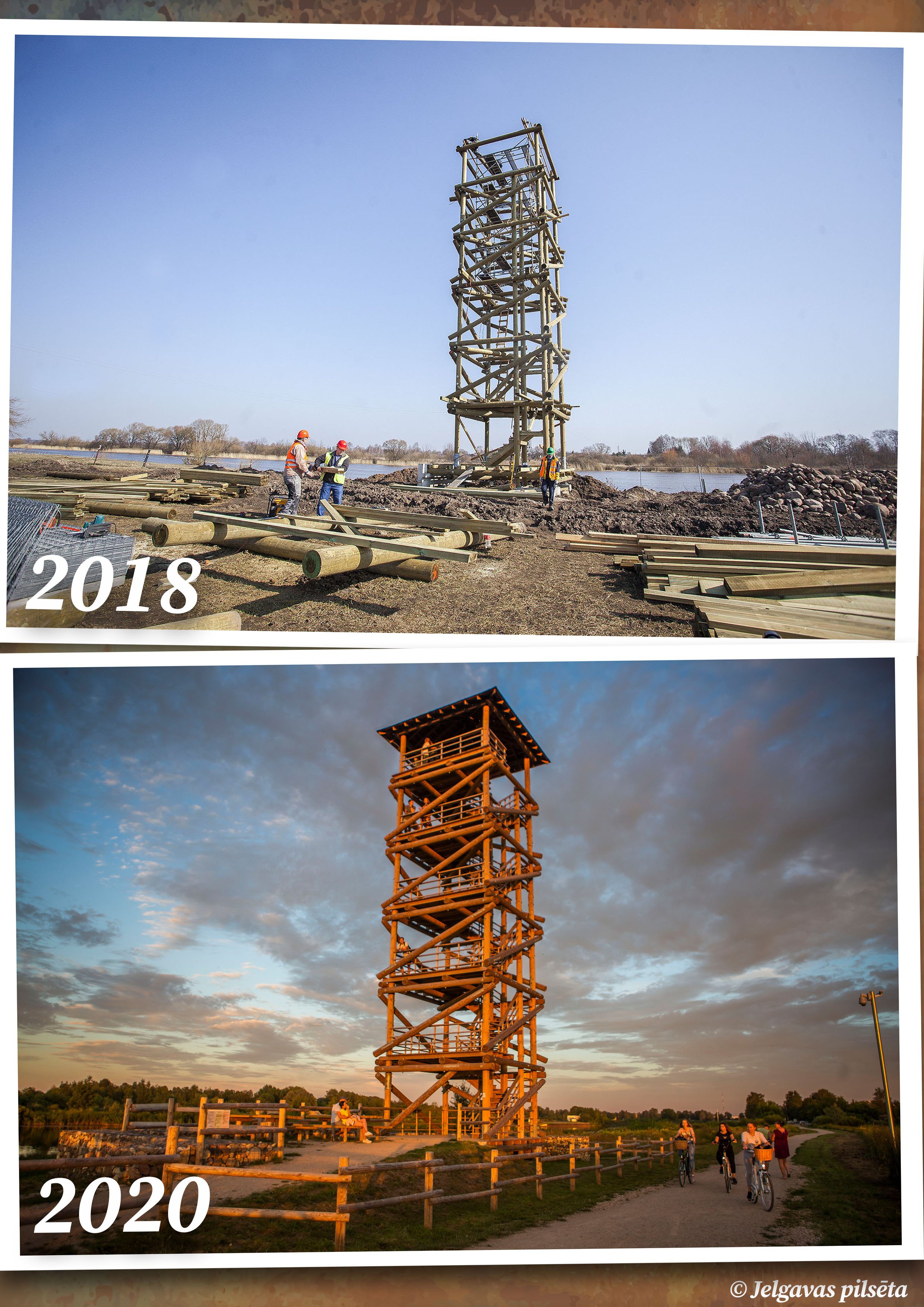
The Pilssala fence gate is equipped with an automatic visitor tracking system that records how many people have visited the island. The wooden observation tower is 19.2 meters or six floors high, and a wooden staircase leads to the upper observation area. The base of the tower measures 4.9 x 4.9 meters and is the same width throughout. Taking into account the risk of flooding in Pilssala, the tower was built on an elevation. People with reduced mobility can also enter the first level of the tower.
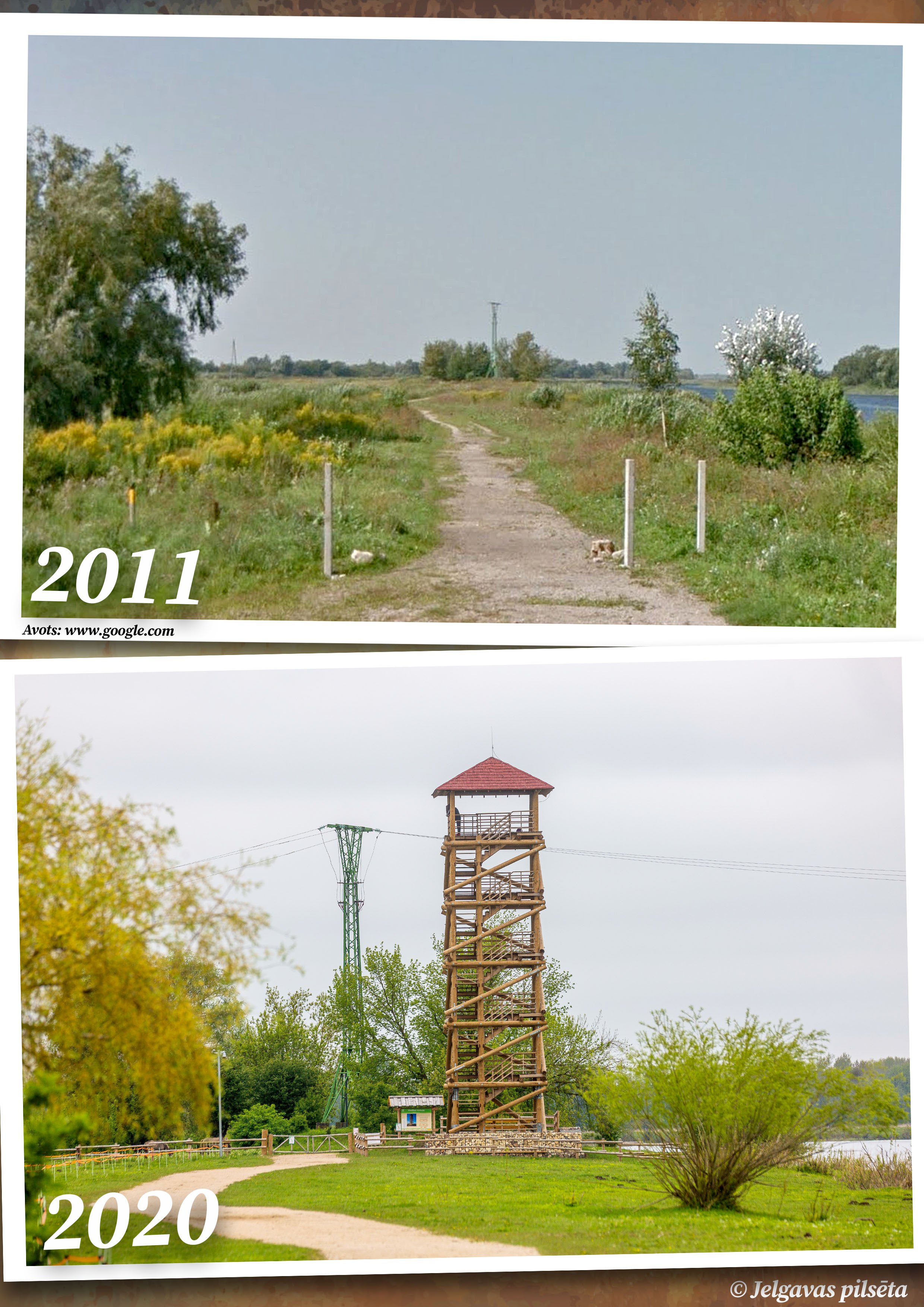
There is also a landscaped area near the observation tower, installing a fenced picnic area with tables, benches, waste bins.

In order to improve the safety of pedestrians and drivers, to ensure more efficient transport movement in the direction of Riga and Dobele, as well as to improve the condition of access roads, in 2009 the reconstruction of the Dobele highway was started.
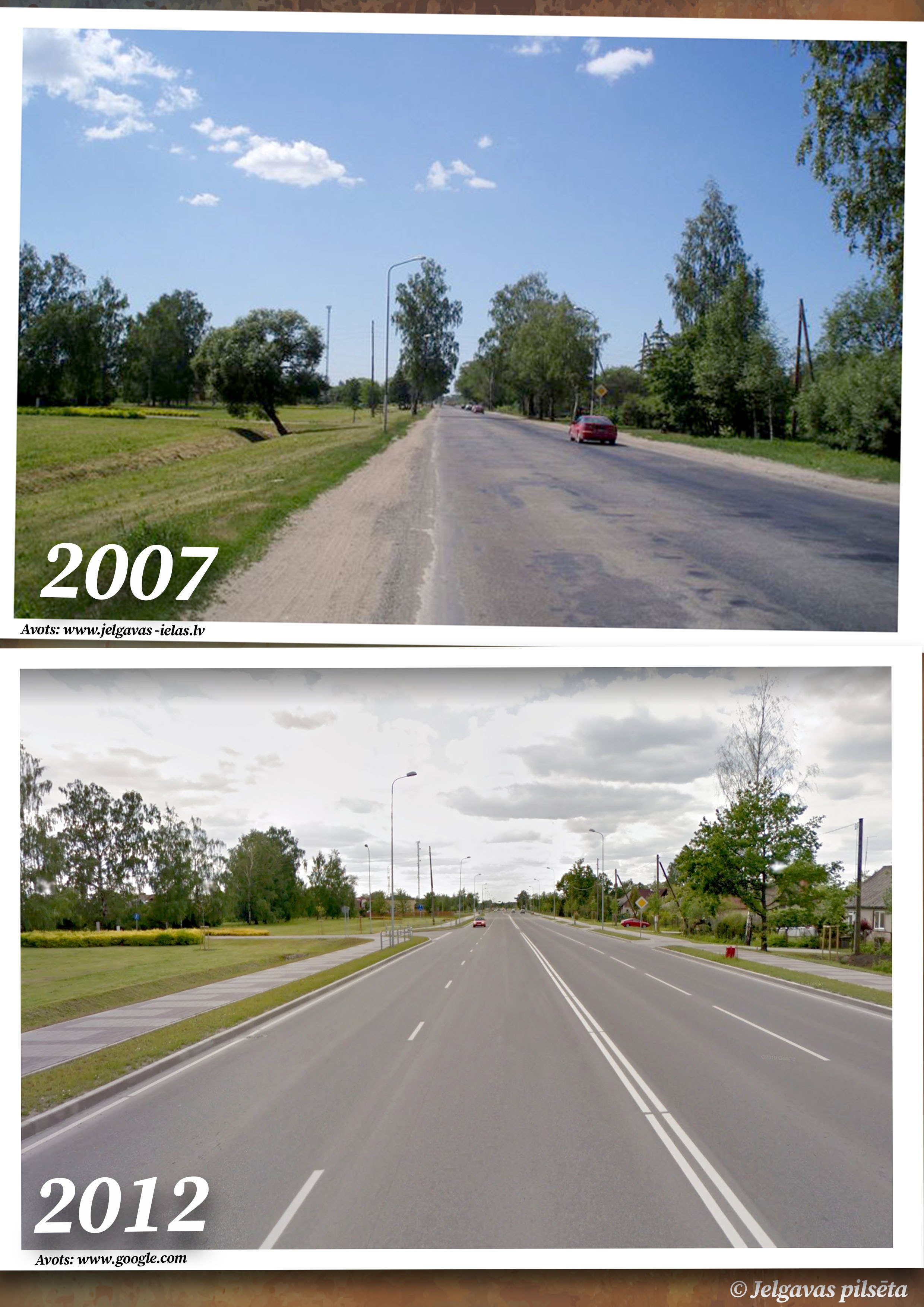
During the reconstruction, the section of the Dobele highway from Atmodas Street to the intersection of Satiksmes Street was completely reconstructed – four lanes, pedestrian sidewalks and bicycle lanes were built, as well as access roads were arranged.
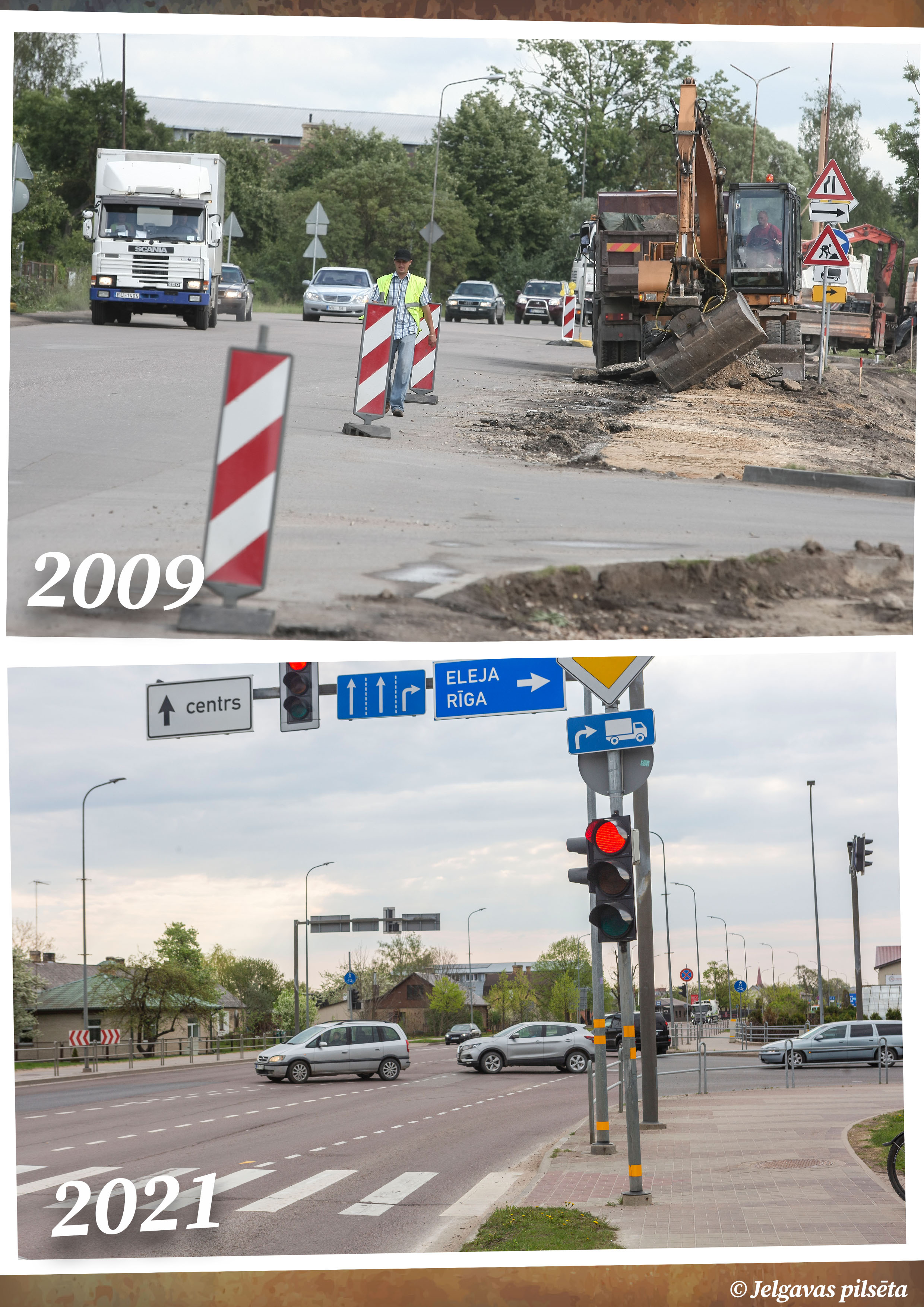
External lighting has also been reconstructed, utilities have been reconstructed and built, and new public transport stops have been installed.
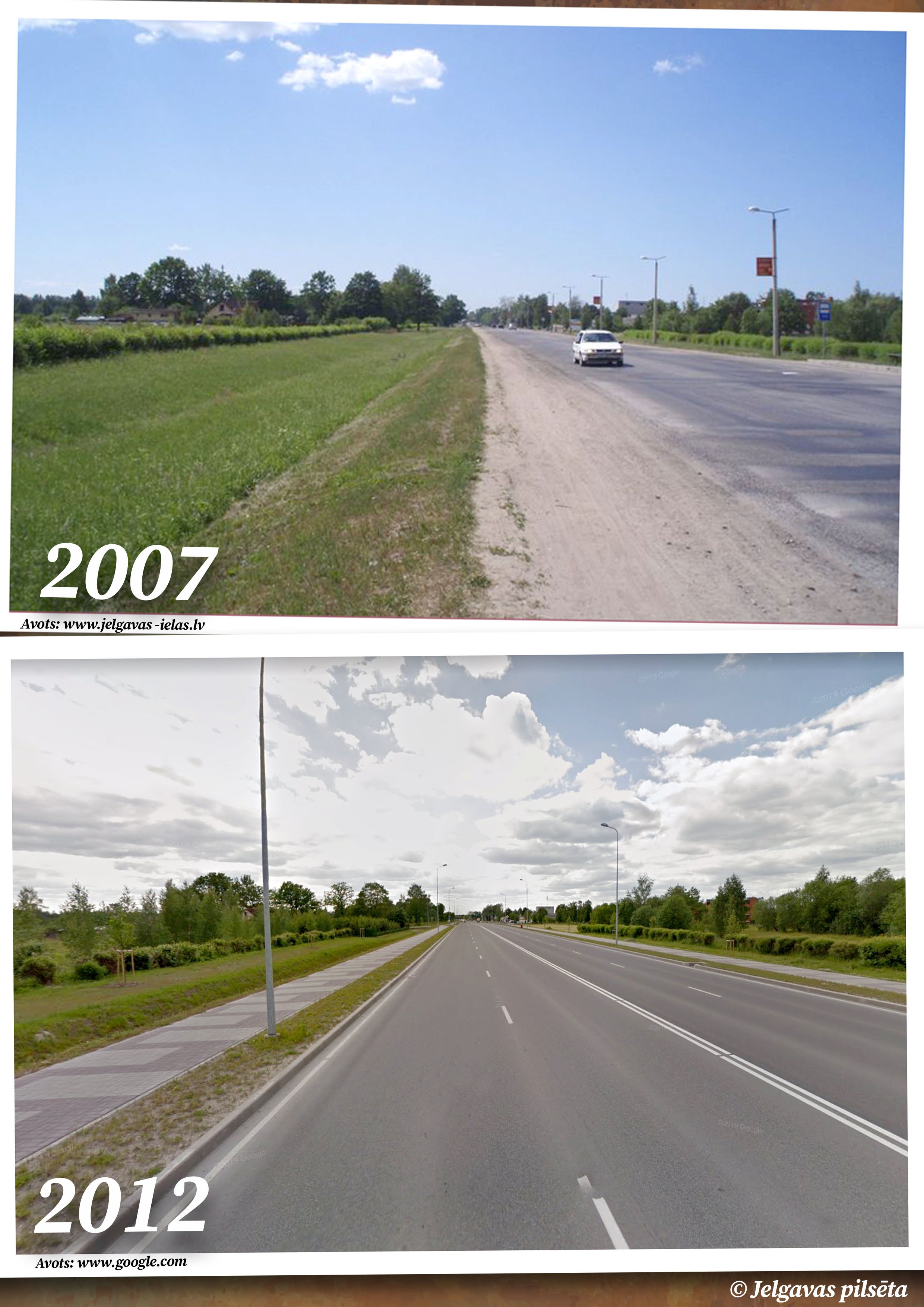

Within the framework of the reconstruction of Jānis Čakste boulevard, a pedestrian bridge over Driksa, which is unique for the Baltics – Mītava Bridge, was opened in 2012, and its name was chosen by the residents of the city on the website Jelgava.lv.
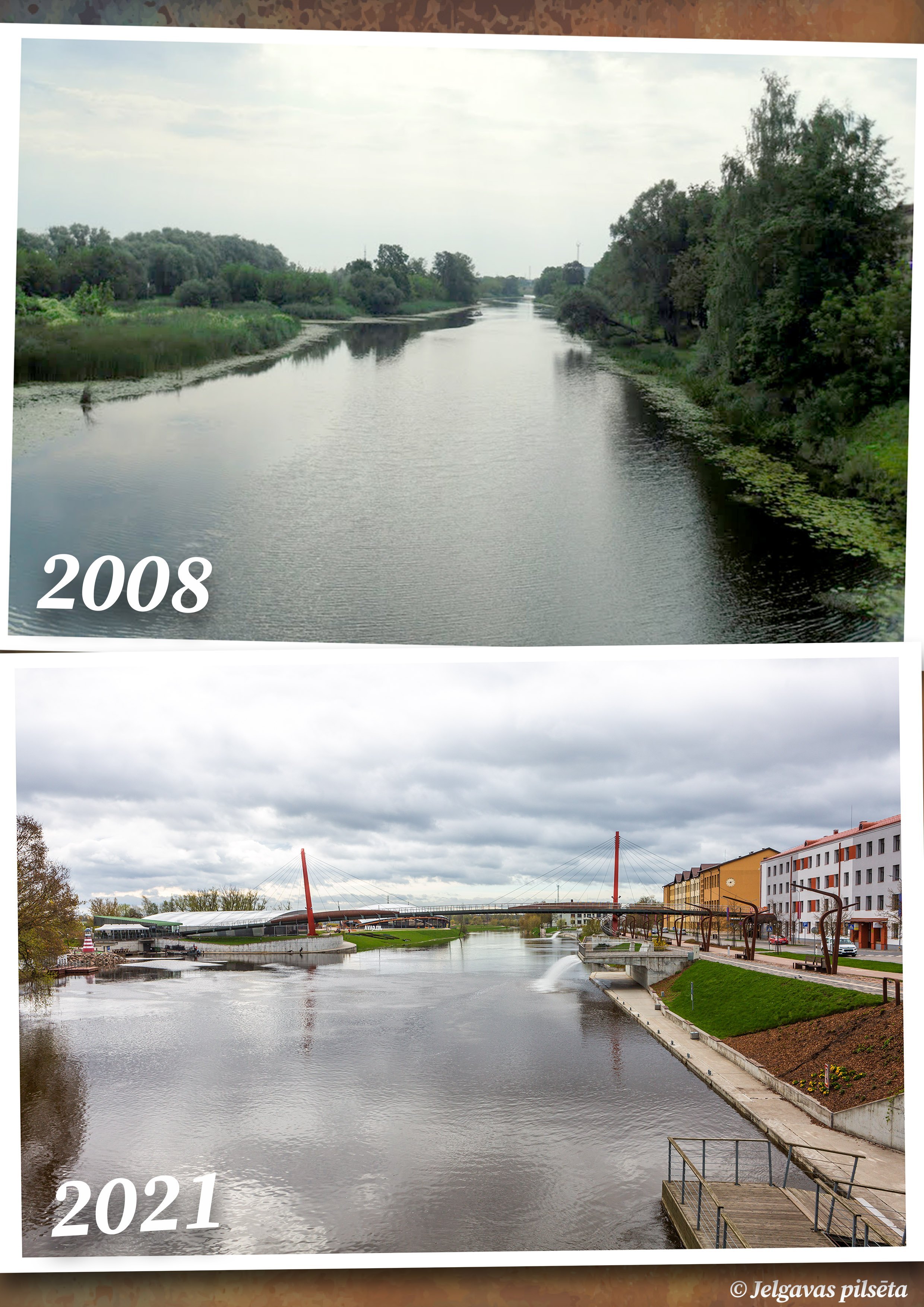
The Mītava bridge connects the city centre with Pasta (Post) Island. The steel bridge is installed in 28 cables and curved in two axes, which is a technically complex construction. The span of the bridge is 152 meters with a concrete extension on the city side, but the width is 3.5 meters. The bridge has two 22 and 24 meter high pylons. It consists of 3850 steel elements, the span structure is made of seven blocks 19-24 meters long. A boat dock has been built by the bridge.
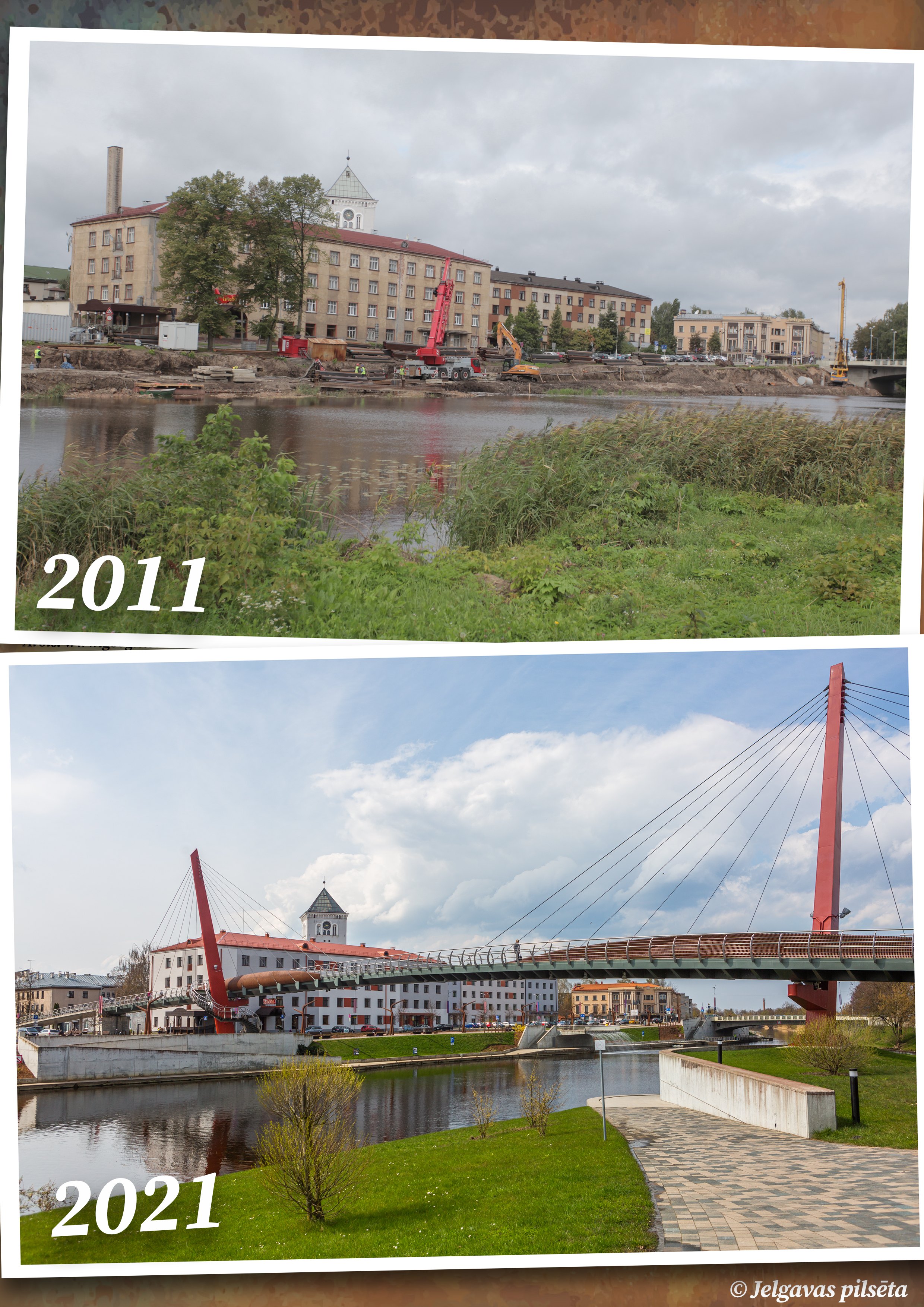
The Mītava Bridge and Jāņa Čakstes Boulevard won the 1st place in the competition “Best Building of the Year in Latvia 2012” in the nomination “Engineering Building” in 2013. In the vote for the most beautiful bridge in Latvia, readers of the tourism portal Travelnews.lv ranked Mītava Bridge as the 2nd best of 2013.

The construction of the Jelgava Paula Bendrupa Primary School (former Jelgava Primary Boarding School No. 2) gym began in 2015. It took place over a year, following the requirements of a low energy building (around 14.5 kWh / m2 per year).
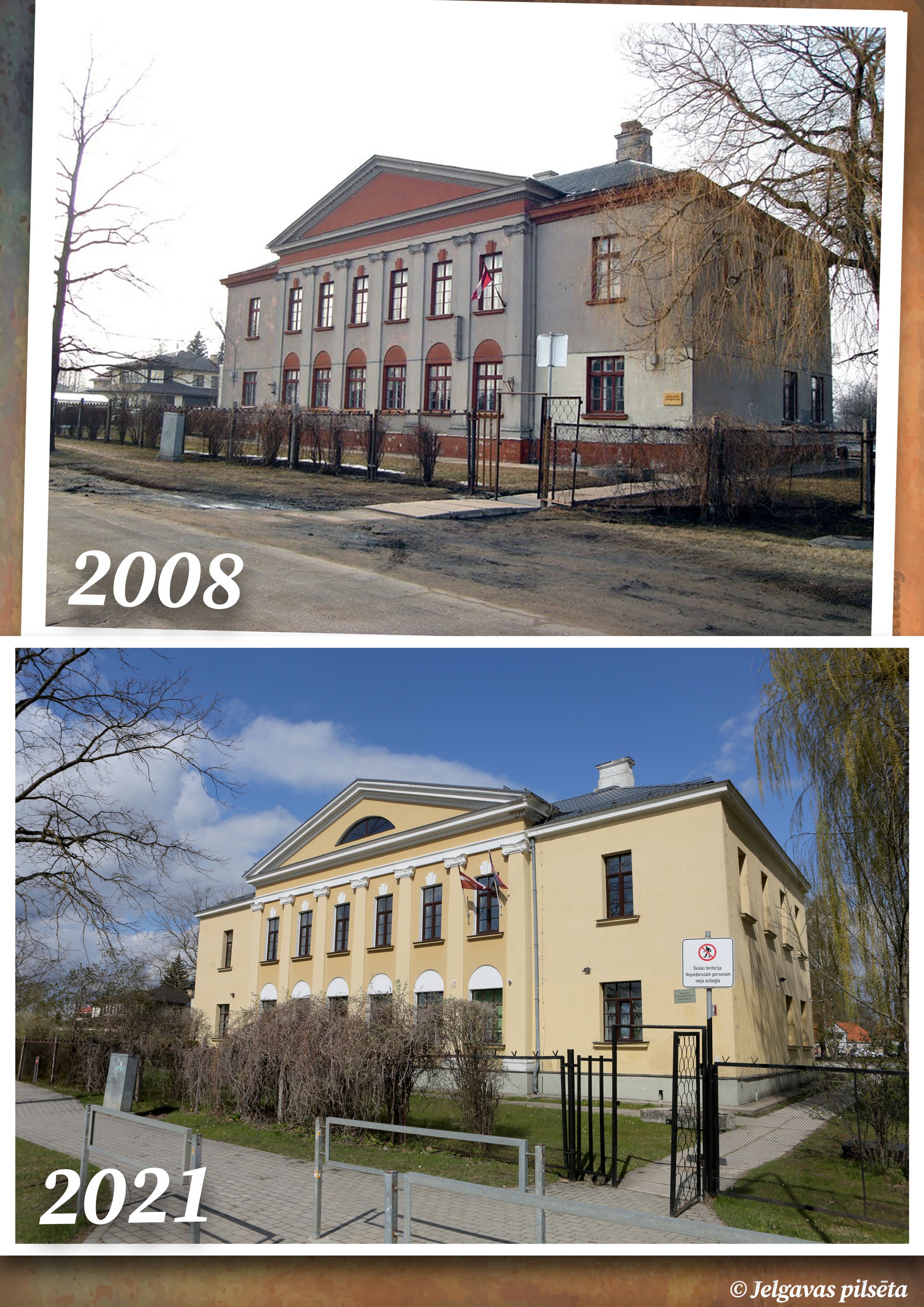
The area of the new sports building is 1,200 square meters. It has a gym (600 square meters) and several auxiliary rooms: showers, changing rooms, facilities, technical rooms, including a heating unit, medical room, teachers’ room, sensory room, speech therapist’s room, both regular and medical gym and a salt room. There is a landscaped area near the building and a parking lot for 30 cars.
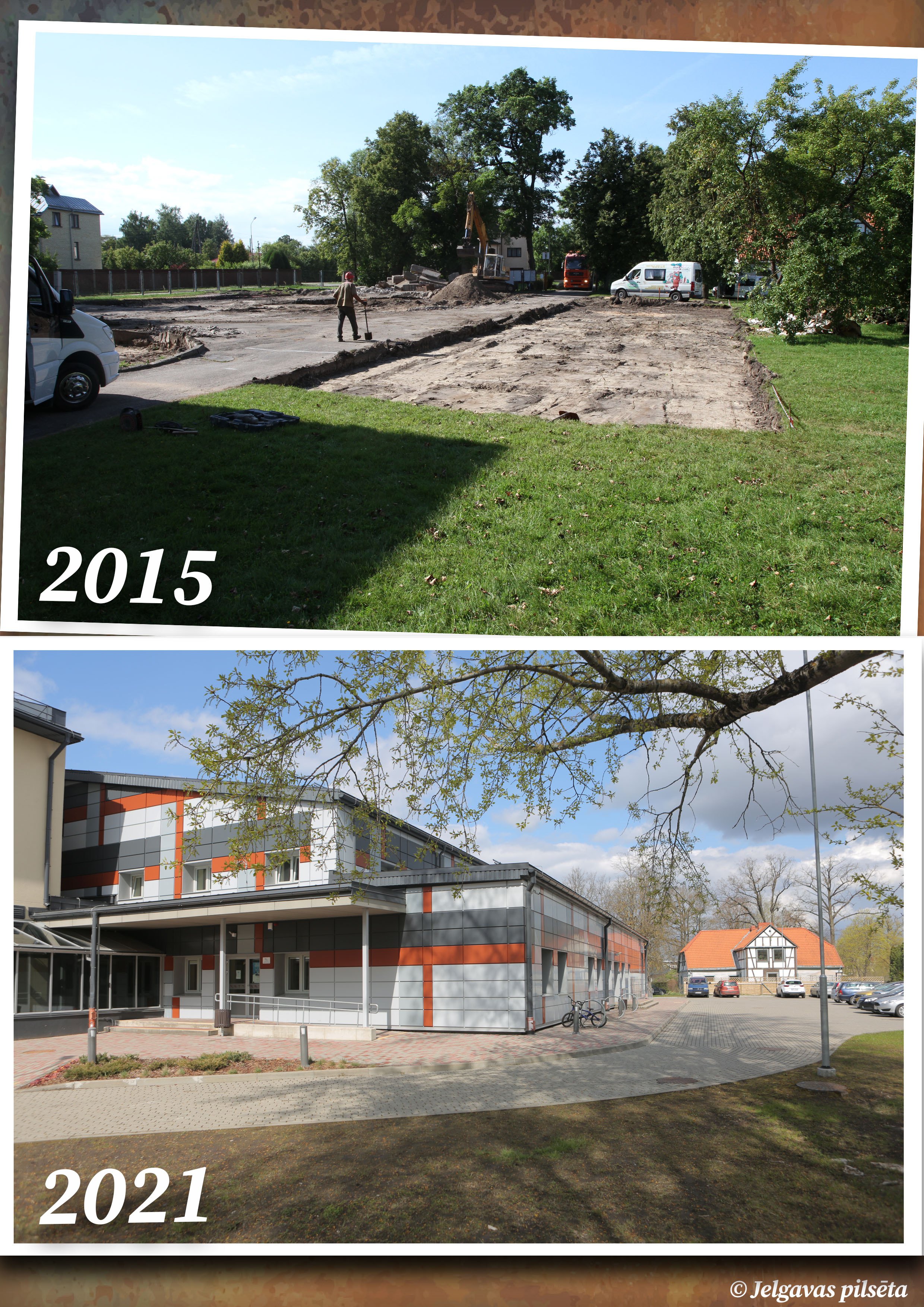
As the three-storey building of Jelgava Paula Bendrupa Primary School, located next to the gym, has not undergone any changes since its construction, in 2018 a number of construction works took place there. In order to improve energy efficiency and reduce heat consumption, the building’s foundations, facade and attic were insulated, the roof was rebuilt and insulated, the dining room was renovated, new household classes were created, as well as the building’s fire safety solutions were improved. For the convenience of students, a glass gallery has been created at the school, which connects the school building with the gym. The passage also has an entrance adapted for people with disabilities.
Jelgava Secondary Boarding Primary School got its current name – Jelgava Paula Bendrupa Primary School on July 1, 2019. It is named after Pauls Bendrups, a bearer of Order of the Three Stars. He is one of the founders of this school, which at that time was the Jelgava School for the Deaf. Under the leadership of P.Bendrups, it became one of the most exemplary special schools in the Baltics.

Lielā Street is a city main street stretching 1298 meters in length. With the aim to create a modern and high-quality underground and surface infrastructure in the centre of Jelgava, thus ensuring high-quality accessibility of the city centre and efficient permeability of traffic flow and creating an attractive living environment, the reconstruction in several stages began in 2012.
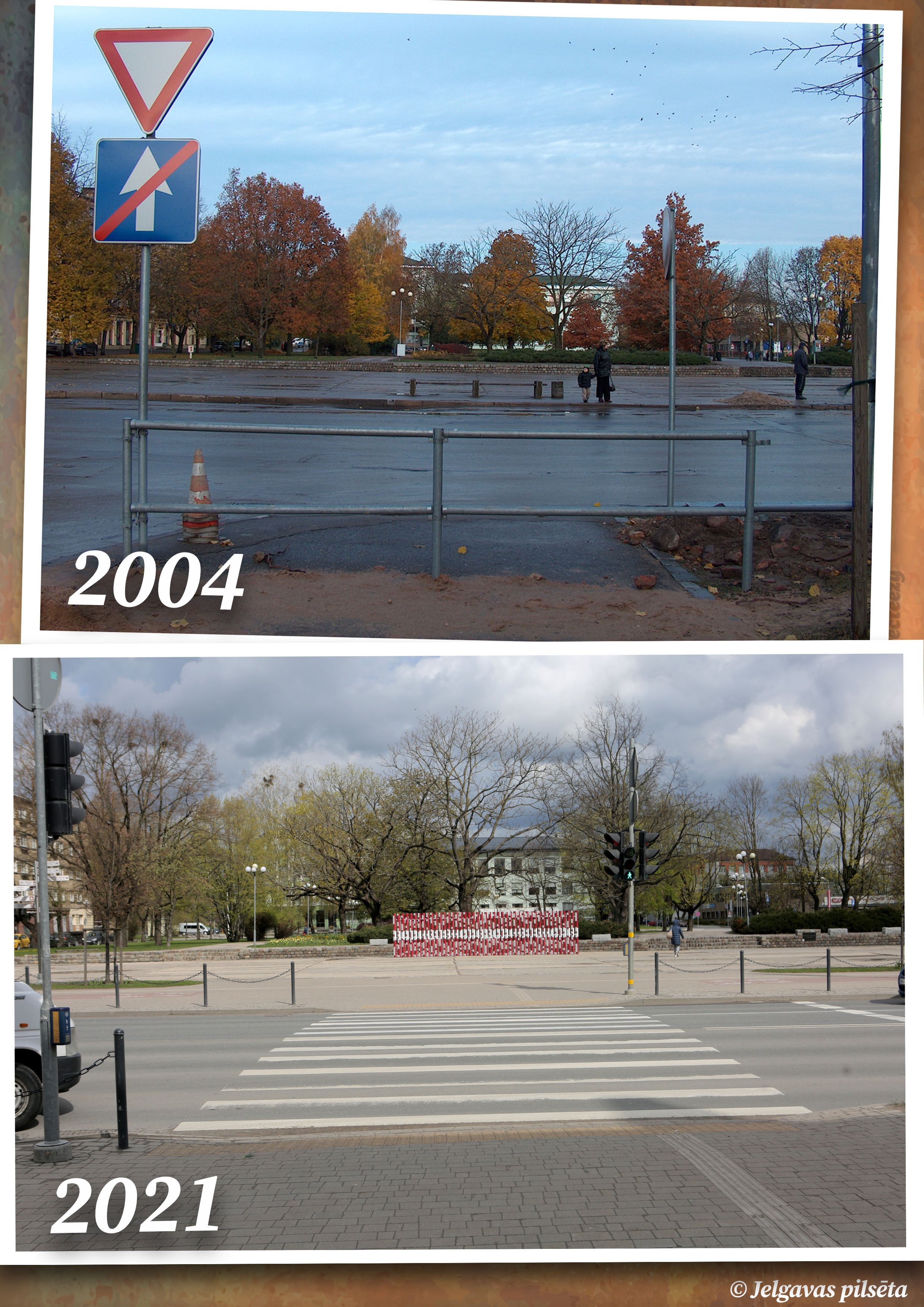
During the reconstruction of Lielā Street, four lanes have been preserved, extensions for bus stops and parking lots for temporary parking have been created on the sides of the carriageway, a bicycle lane and sidewalks have been built, street lighting has been reconstructed, water supply, three rainwater pumping stations and the street have been improved.
The operation of traffic lights on Lielā Street was modernized, ensuring their inclusion in the smart traffic management system established in the city. The aim of the system is to speed up the car flow and make it easier for pedestrians to move – the traffic light modes switch automatically in accordance with the car flow at each intersection.
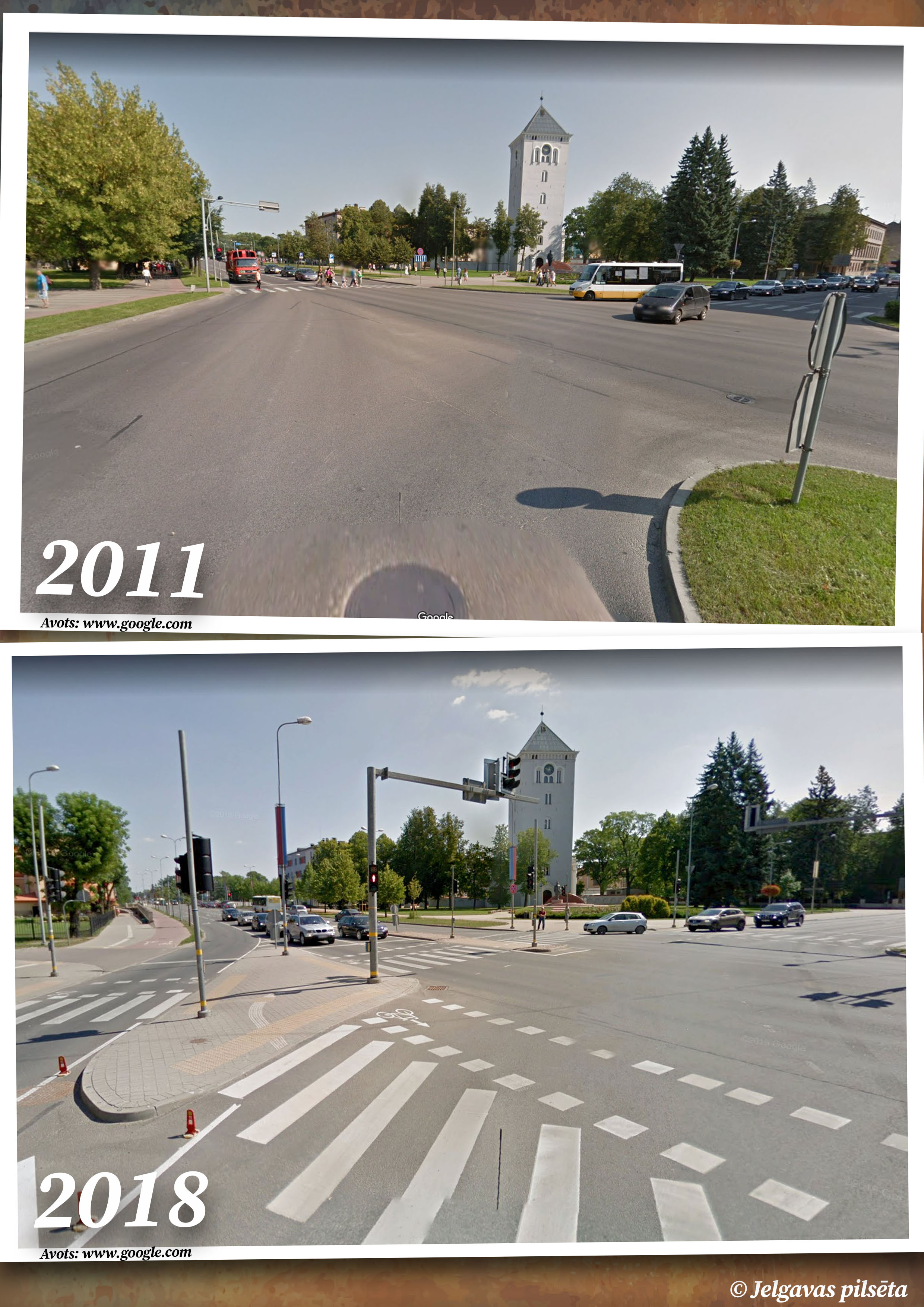
During the construction of Lielā Street, the most historically significant items found in the excavations – an ancient cash register, a 19th century house column, fragments of dishes, parts of metal tools and other items – were handed over to the specialists at Jelgava History and Art Museum of Ģederts Eliass. After scientific research, the most valuable and interesting finds were added to the museum’s exposition.
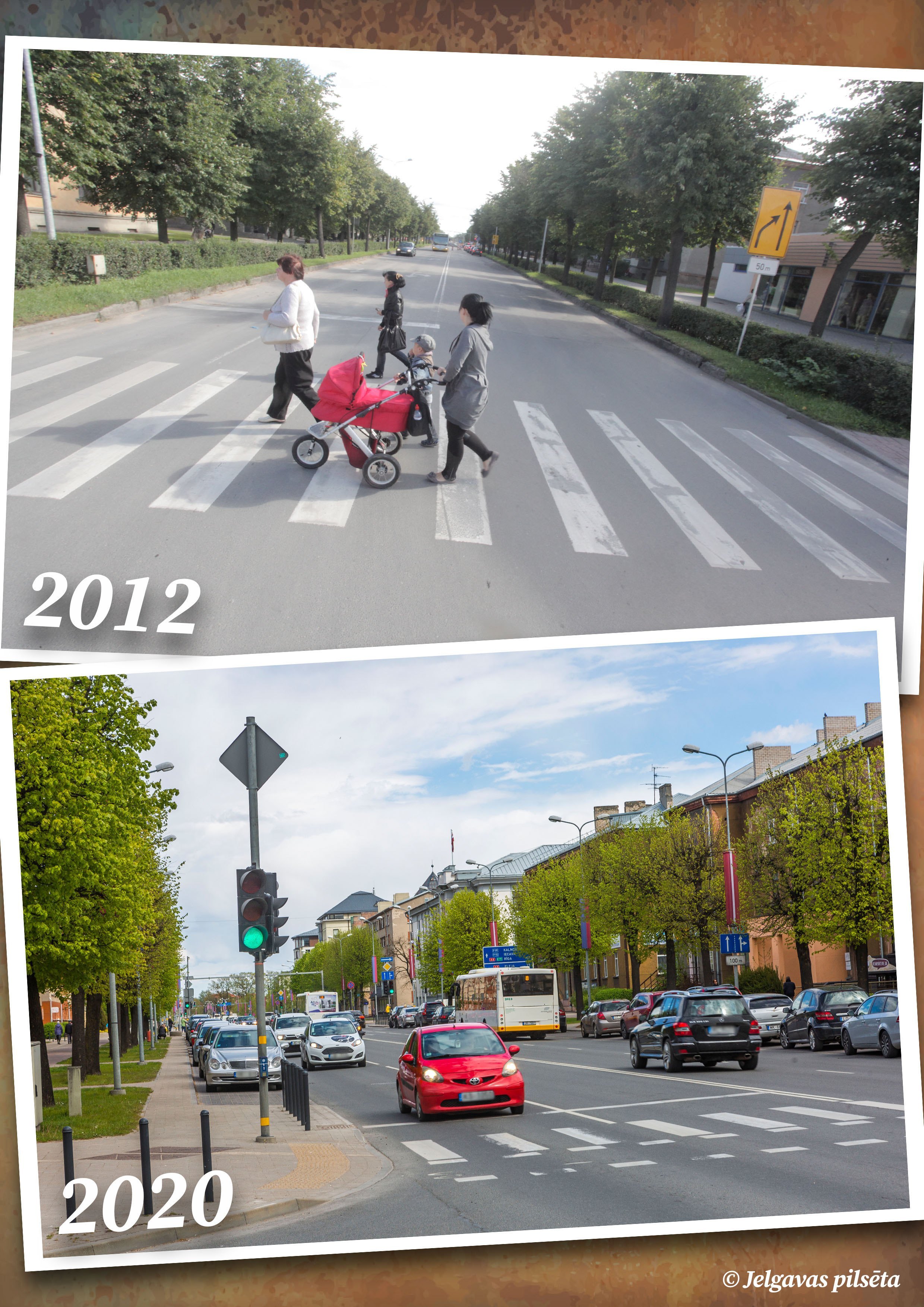
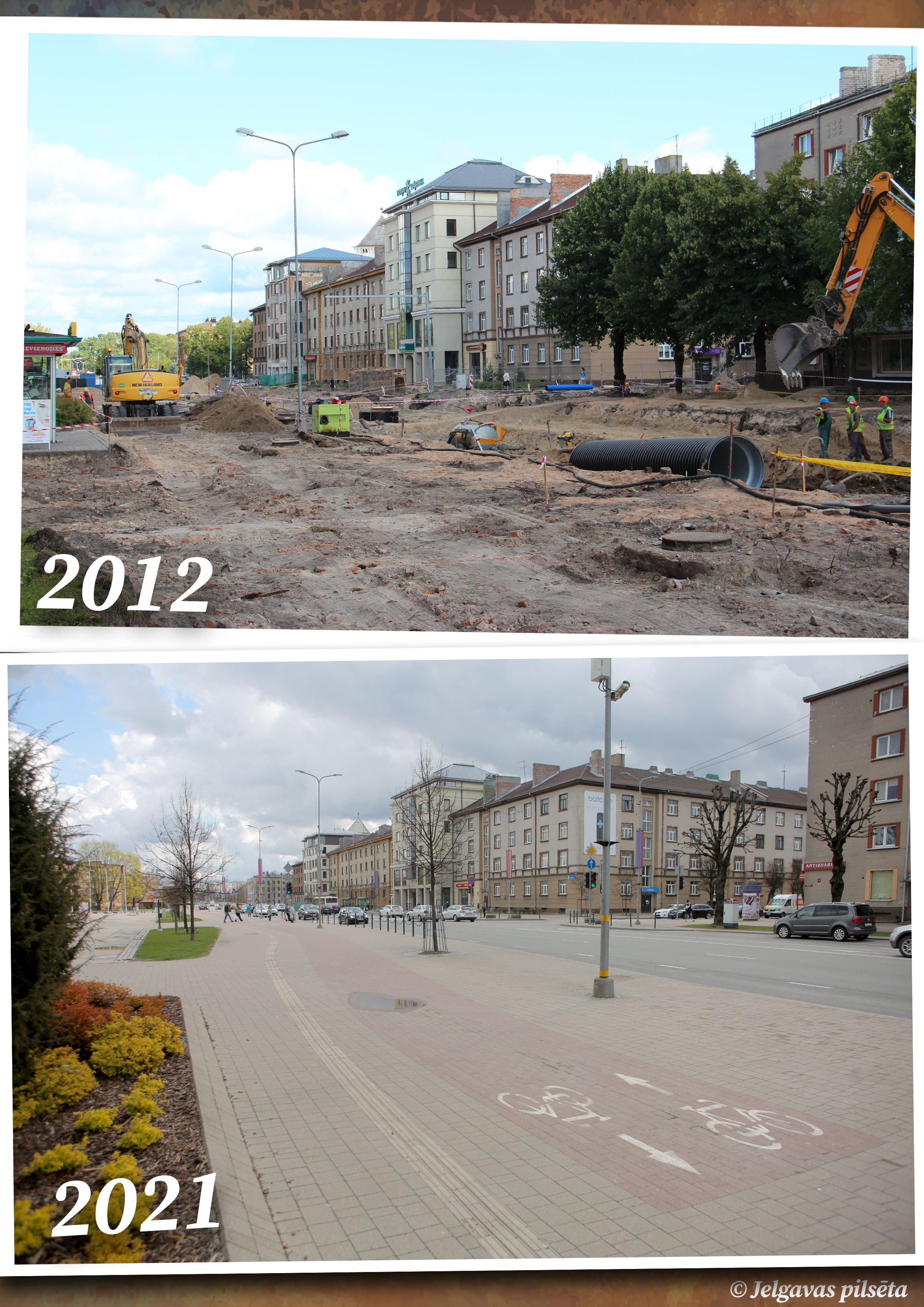
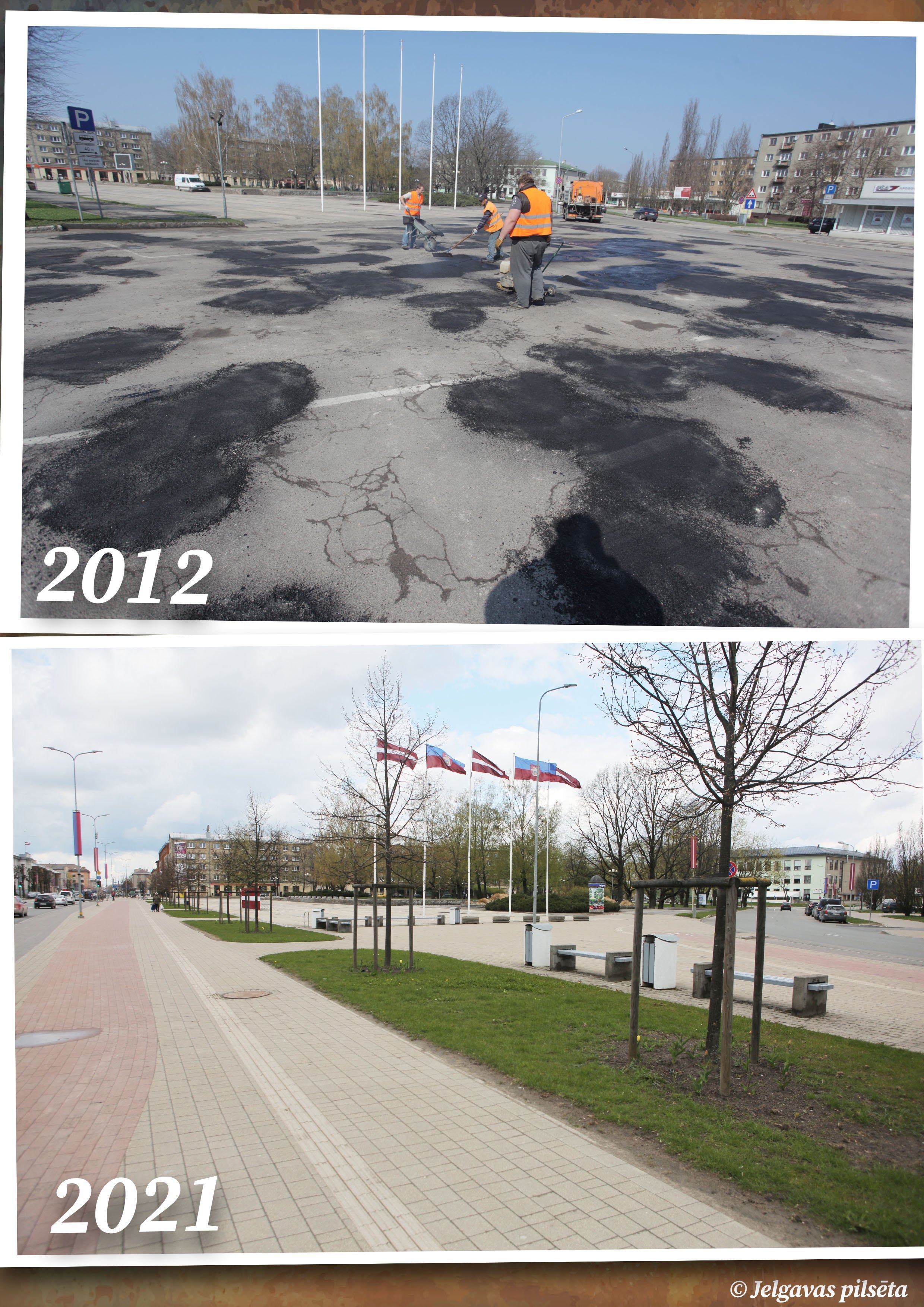

The first phase of reconstruction of Jānis Čakste boulevard began in 2011. The boulevard underwent significant changes, and a year later both the reconstructed section of the street from Raina Street to Lielā Street and the new pedestrian bridge were opened. A two-level promenade, observation decks and a unique pedestrian suspension bridge – the Mītava Bridge – were built along river Driksa.
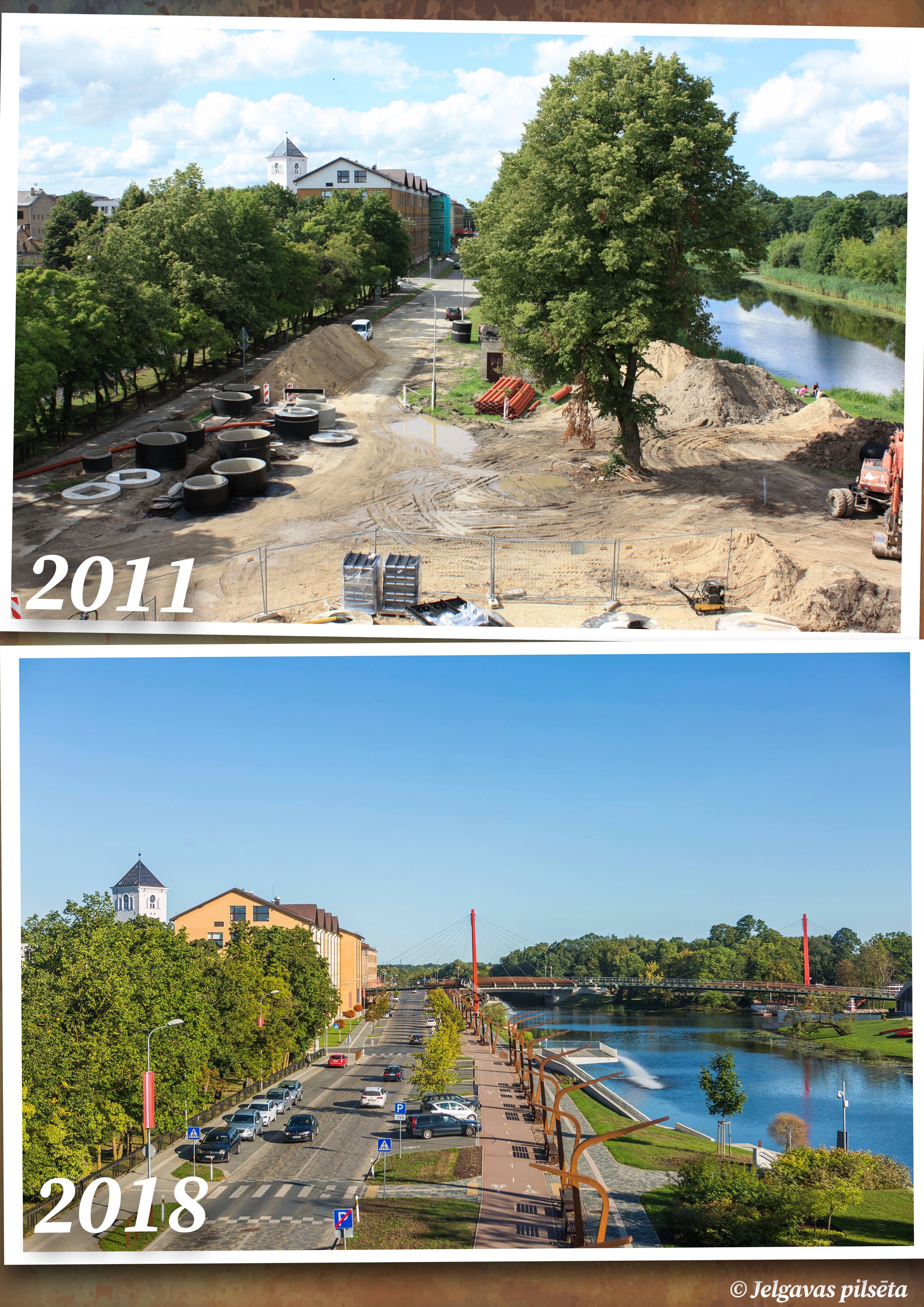
During the construction works, the carriageway and sidewalks of Jānis Čakste boulevard were reconstructed, parking lots for temporary parking were built along the edges of the carriageway, pedestrian crossings and a promenade with a bicycle path along Driksa, shore fortifications and a pedestrian recreation area were built. A pontoon bridge was built under the Driksa bridge, and the existing bridge to the Pasta (Post) Island was reconstructed across the canal.
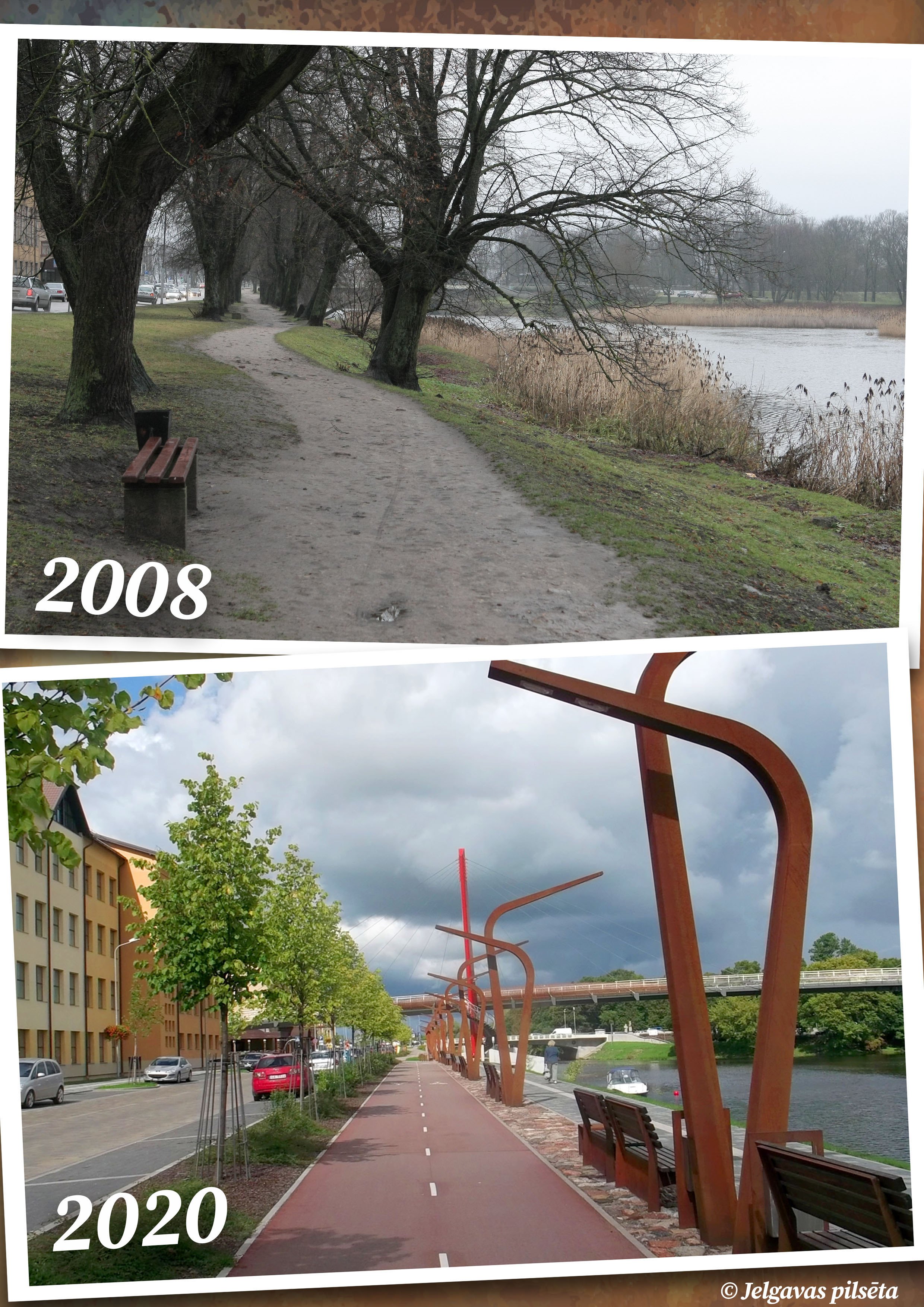
The second phase of reconstruction of Jānis Čakste boulevard began in 2013 with the aim to reconstruct the existing street carriageway from Lielā Street along the hotel and pedestrian road, to build a parking lot on the side of the carriageway, as well as to build rainwater and sewerage sections, communication sewerage and to improve the adjacent territory.
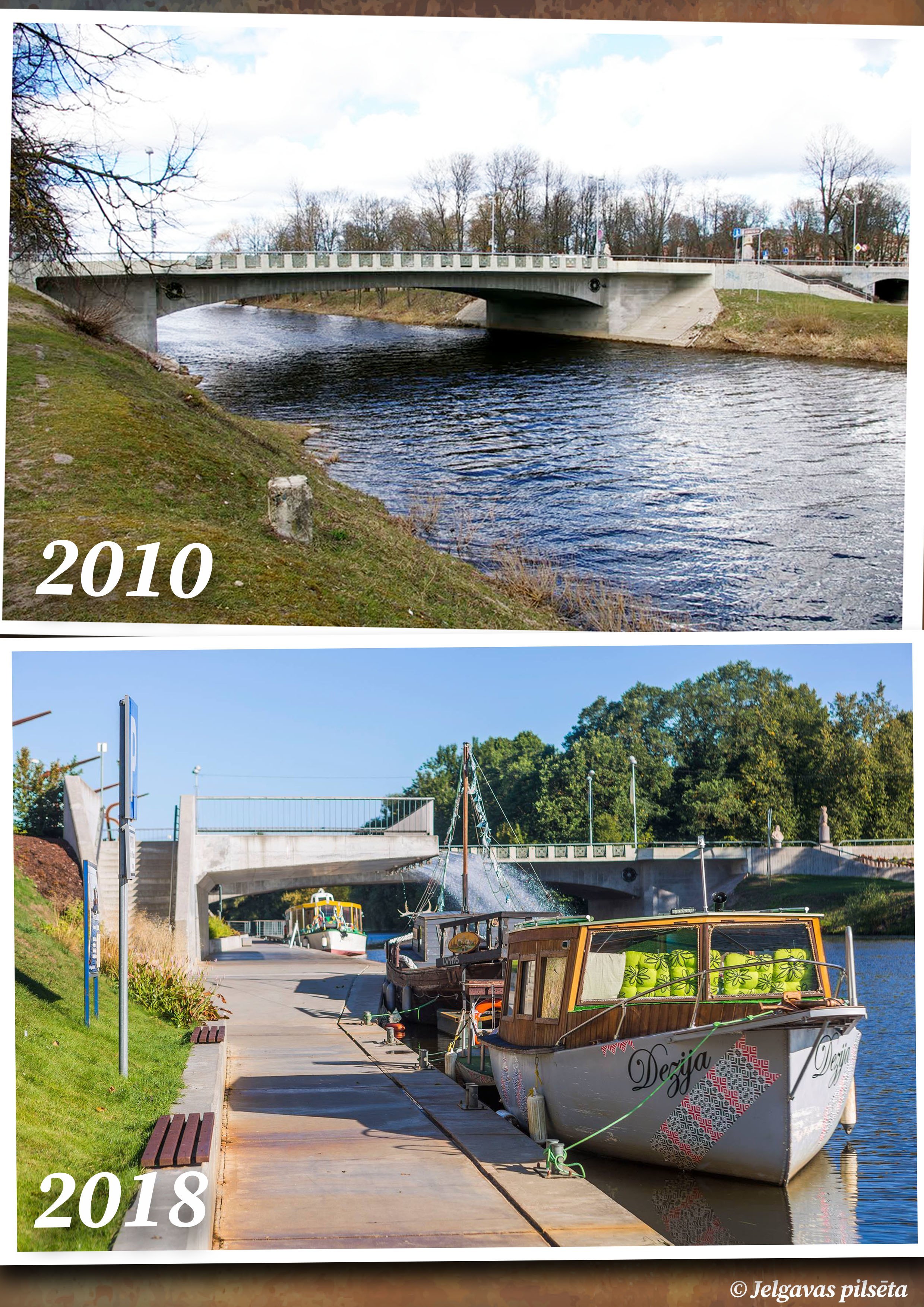
Jānis Čakste Boulevard received a letter of commendation for compliance with sustainability criteria in a public outdoor facility in the competition “The most sustainable building and project 2014 in Latvia”.
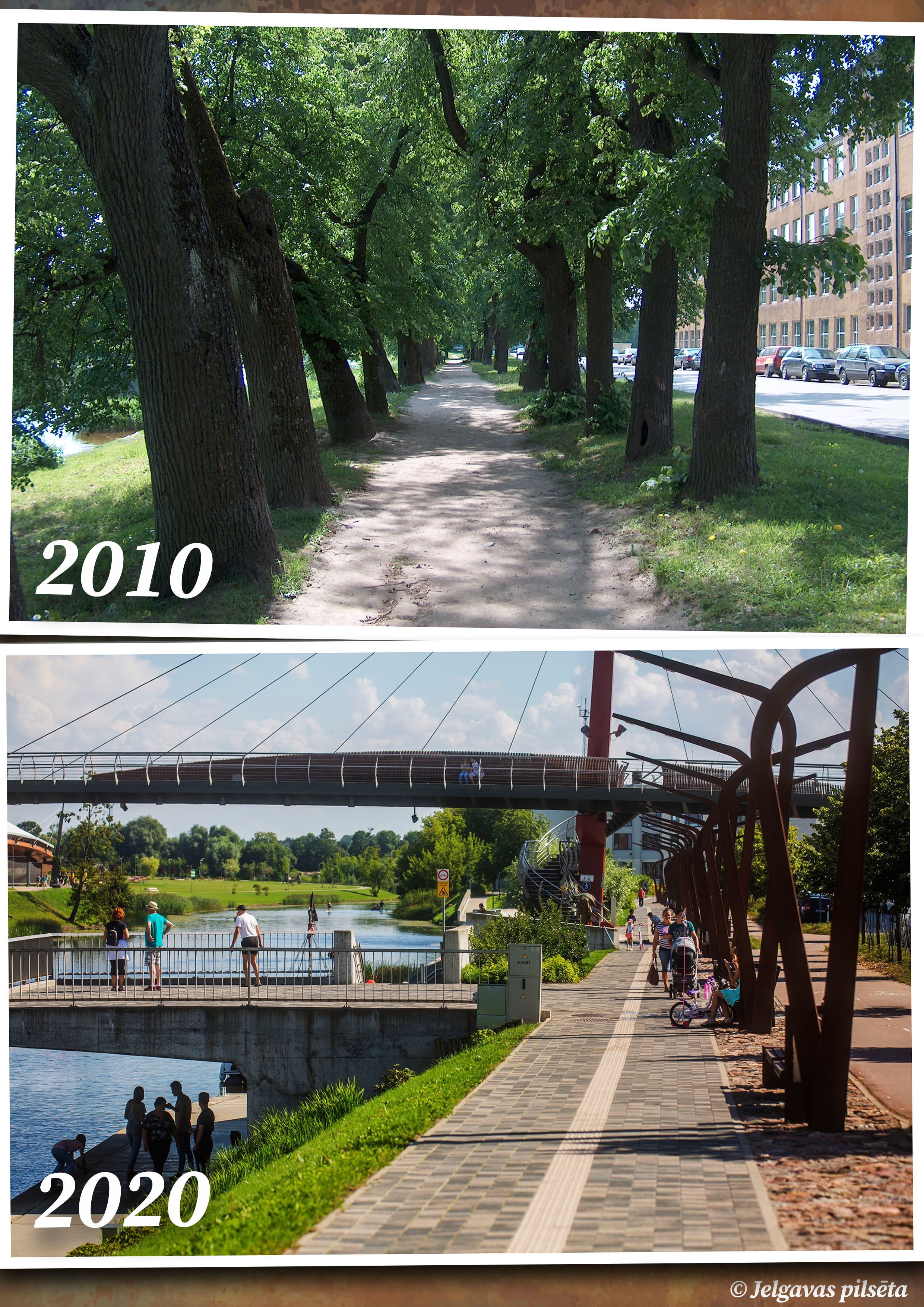

Construction works on the sports field near Jelgava Primary School No. 4 began in 2018 with the aim of improving a multifunctional sports complex with an area of more than 1.3 hectares. Its improvement was completed in 2019 – an artificial football field, a running track, several sports playgrounds, outdoor exercise machines were installed, as well as a building with changing rooms and storage equipment was built, the territory was fenced and landscaped. In turn, taking care of security, video surveillance cameras have been installed.
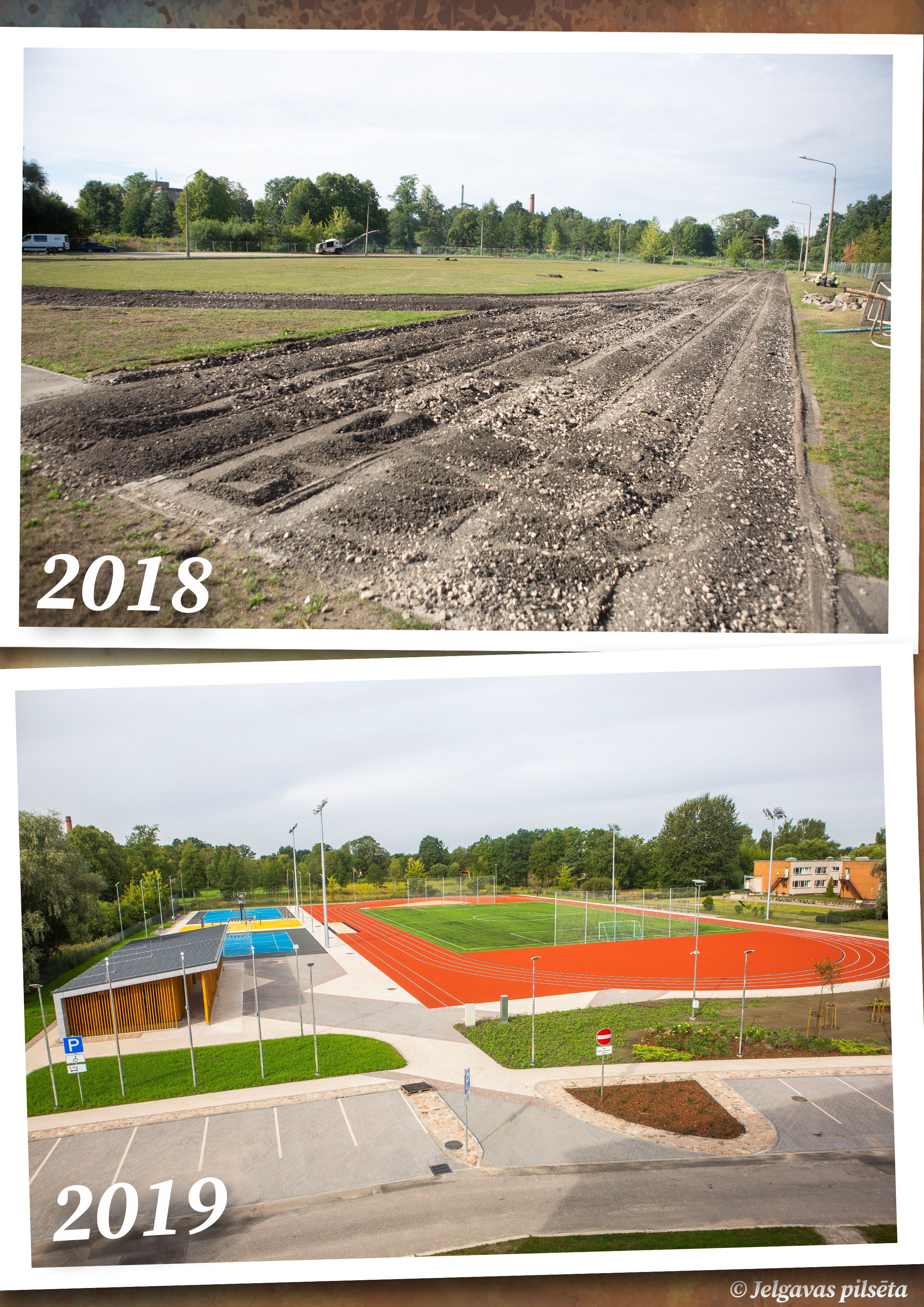
In the center of the sports field there is a 40×60 meter football field with an artificial surface and spectator stands with 60 seats. For athletics, a 270-meter-long four-lane running track has been built, as well as a long jump sector and a ball-throwing sector.
There is also a basketball court and a multifunctional playground for volleyball, handball and mini-football. There is also an outdoor exercise area with seven different exercise machines.
The improved sports infrastructure is used daily for sports classes and in training by students of Jelgava Vocational High School, Jelgava Primary School No. 4, Jelgava Technical School and city sports schools. The stadium is also open to the public for sports activities.

Construction works on the Loka highway from Kalnciems road to the city’s administrative border began in 2018, but two years later, in November 2020, a 4.7-kilometer-long transit street was opened with a symbolic journey. Reconstruction of the Loka highway is an important step in the further development of the city, building the planned northern bypass, which will be formed by Loka highway, the perspective northern crossing over the Lielupe and Driksa, as well as Atmodas Street.
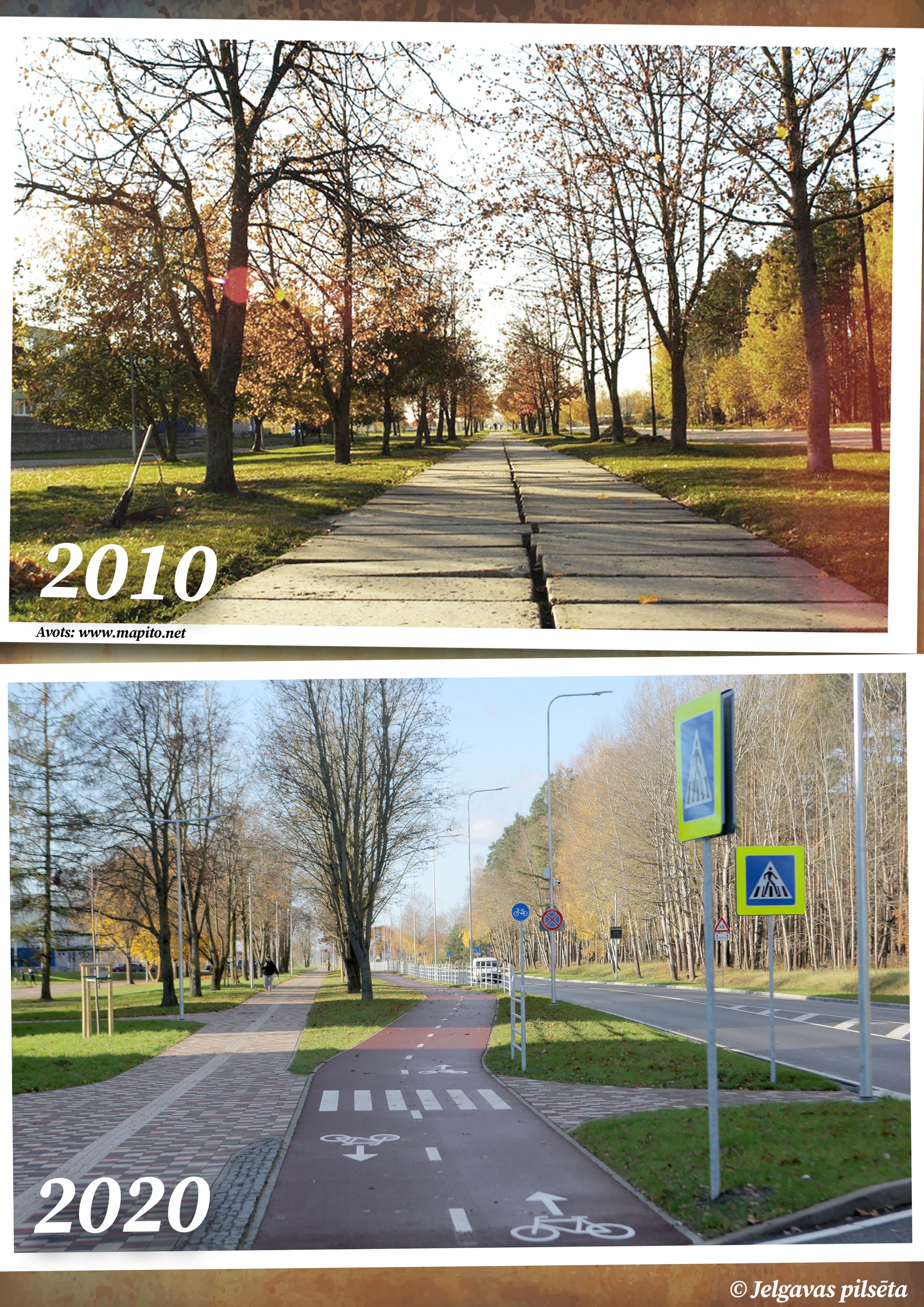
A carriageway has been paved on the Loka highway and, in order to facilitate the flow of traffic, four roundabouts have been built at the intersections with Bērzu Road, Aviācijas Street, Rubeņu Road and Langervaldes Street.
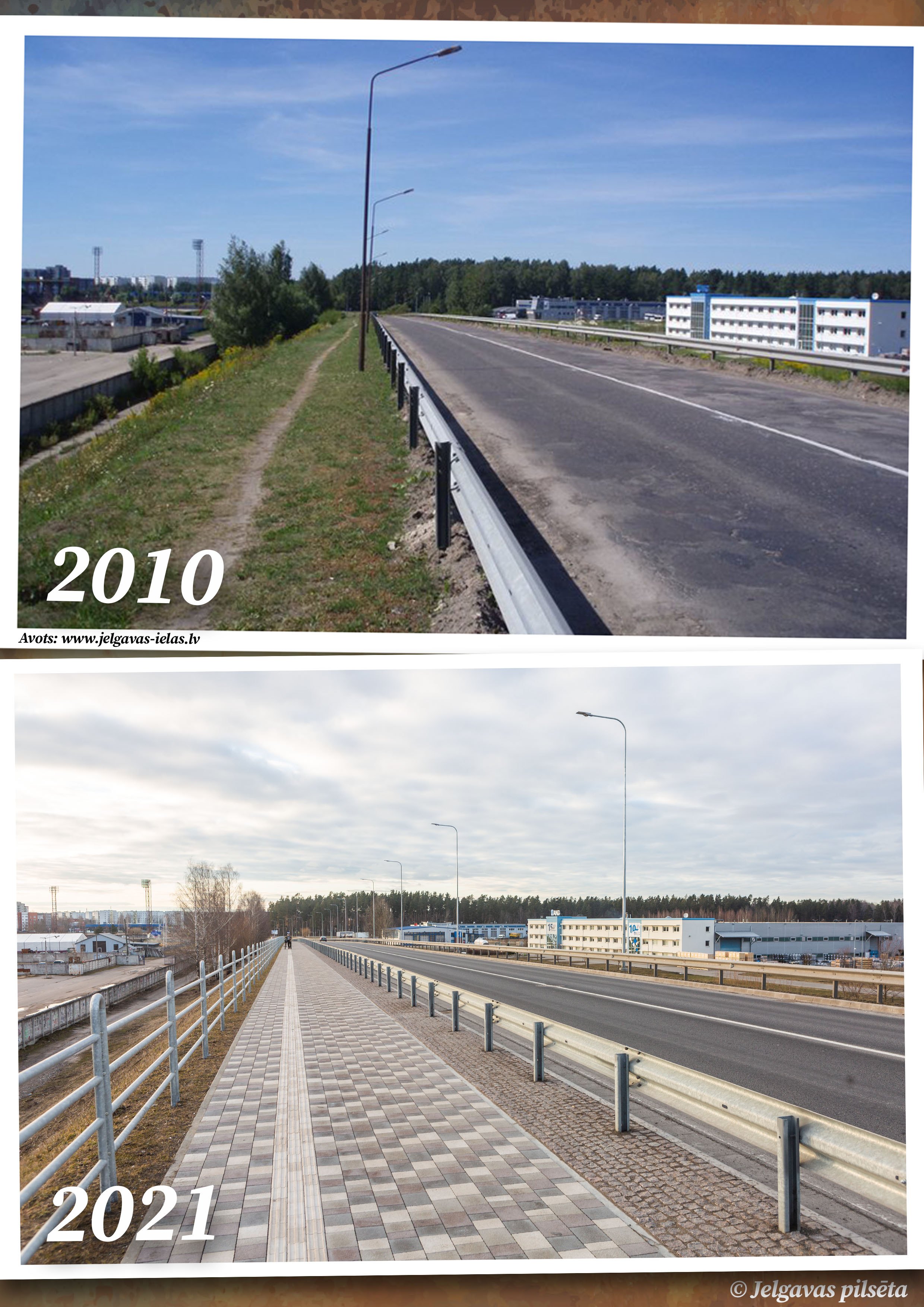
There are also paved sidewalks, an asphalt bicycle path, landscaped parking lots near apartment buildings and recreation areas with tourist information and benches.
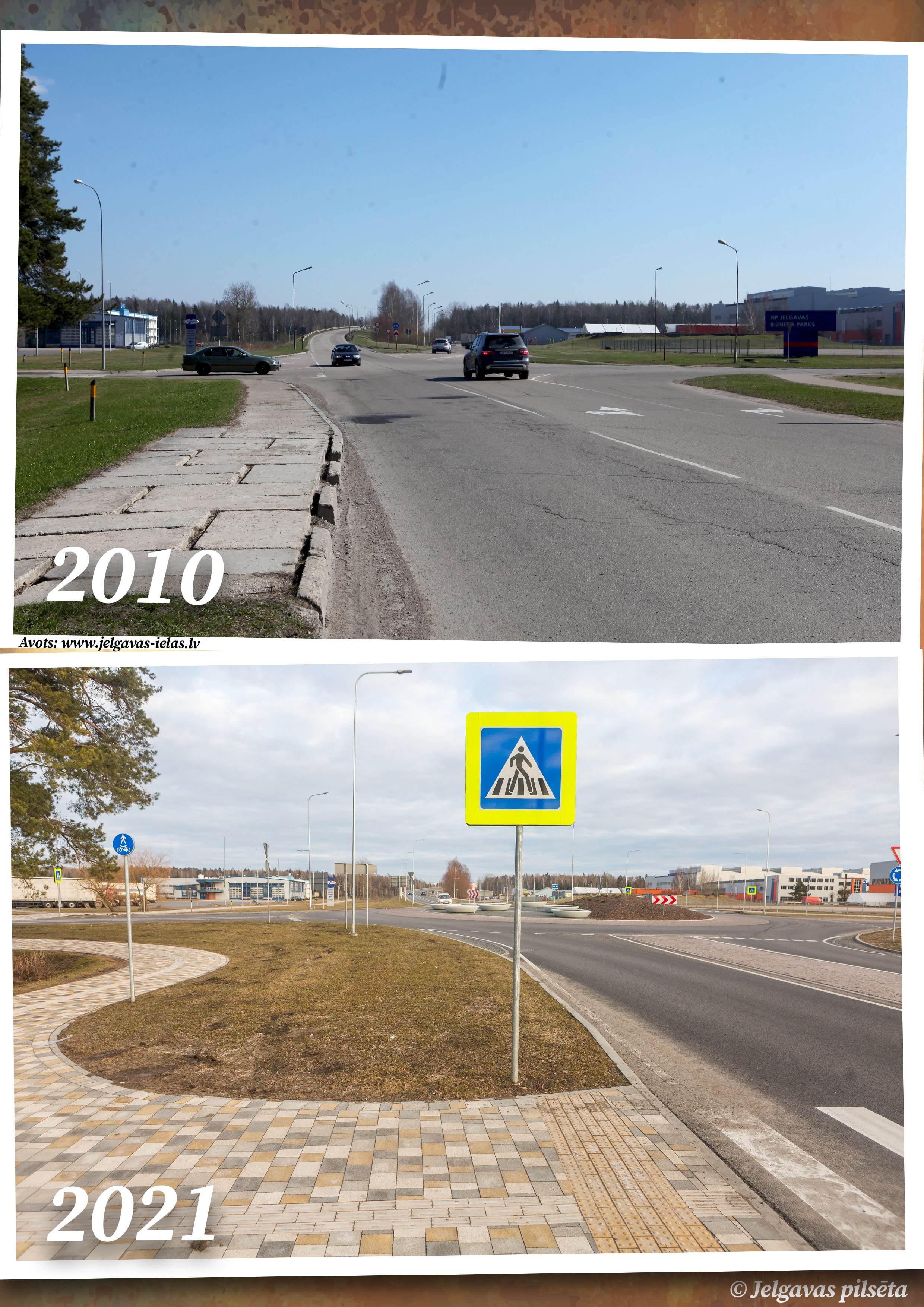
In the reconstructed section of the Loka highway, 10 public transport stops with sheds have been created and extensive works have also been performed in connection with the construction of rainwater sewerage, water supply and domestic sewerage networks, gas pipelines, electricity supply and street lighting networks.
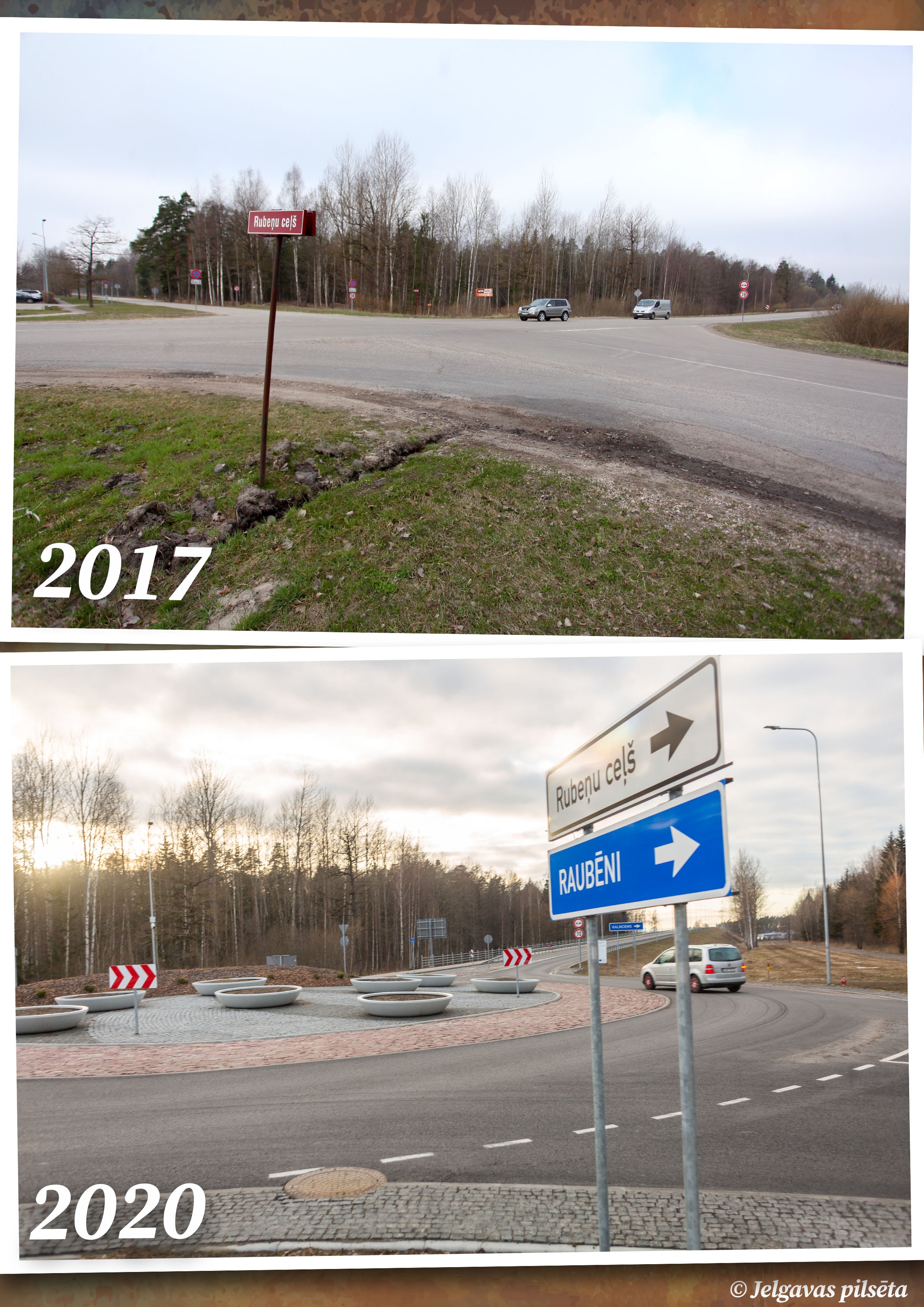
By installing two speed displays, technical means of road traffic organization and supplementing the city video surveillance system with 38 new video surveillance cameras, traffic safety has been significantly improved. In addition, cameras for registration of licence plates have been installed on Kalnciems Road, Rīgas Street and at the city’s administrative border.
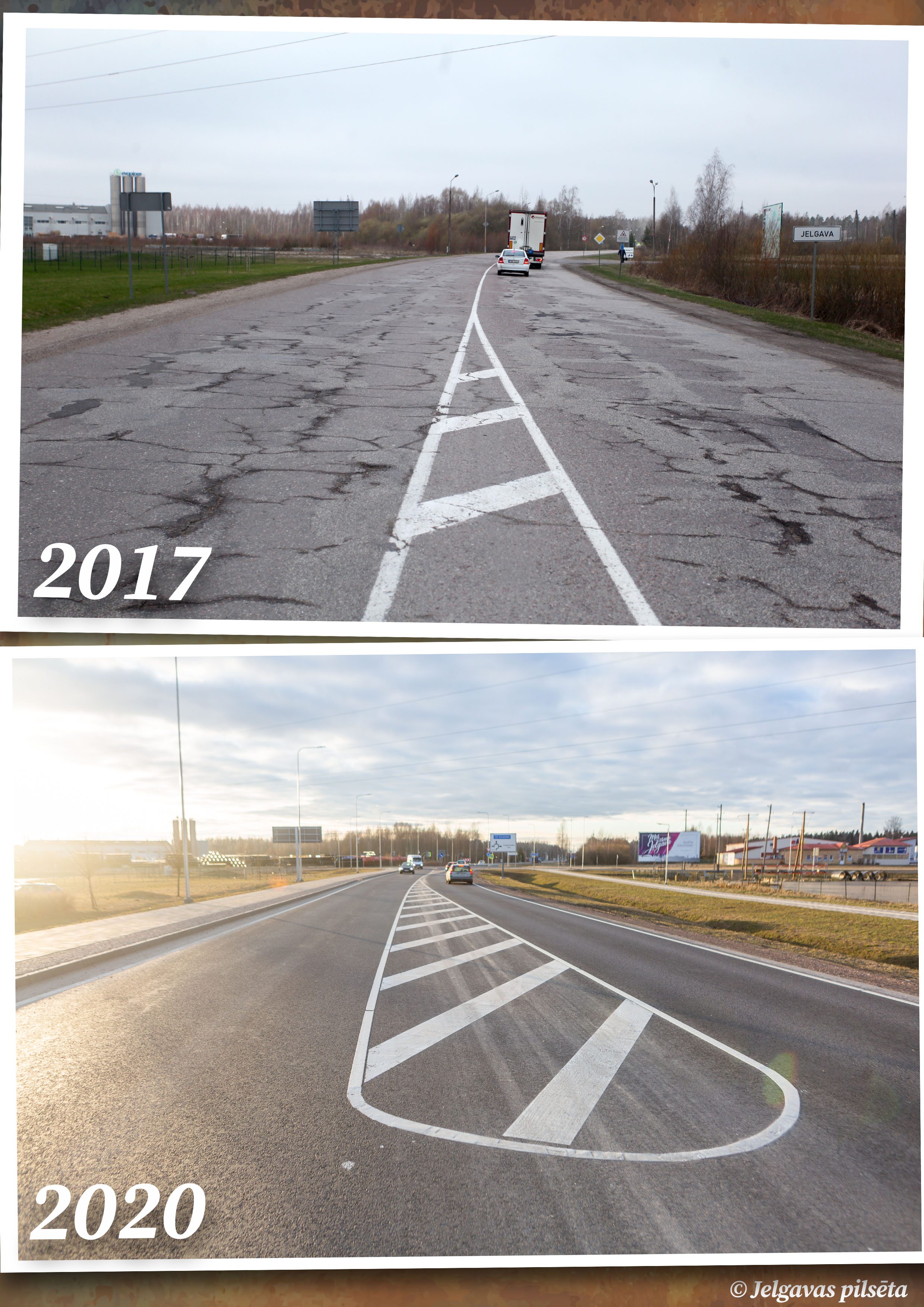
The reconstructed Loka highway is also greened – trees and shrubs have been planted, flower beds have been created and flower pots have been placed in the green areas of the streets and in rotation circles.
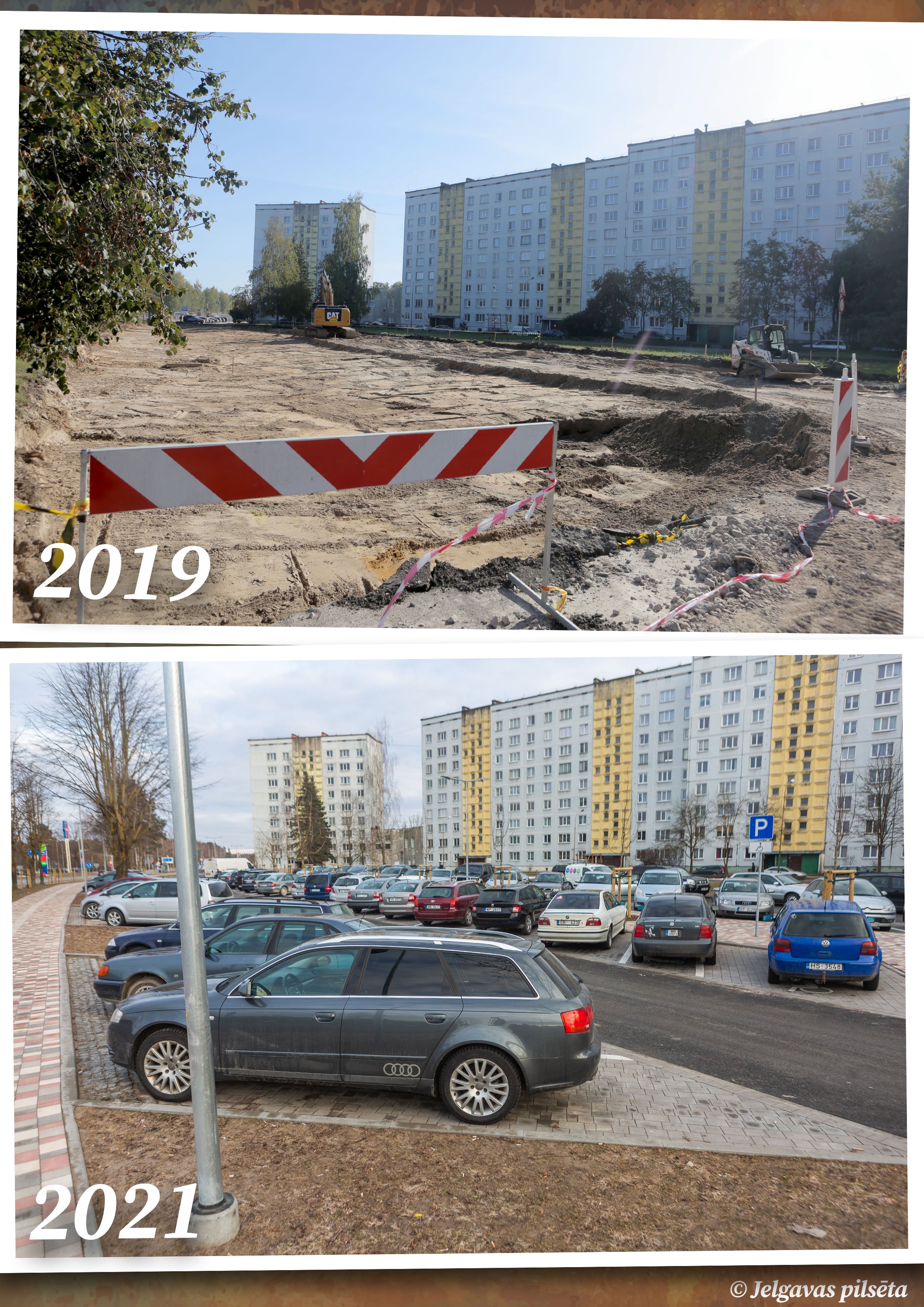

Public skating rink in Jelgava was built on Pasta (Post) Island near the Mītava Bridge in 2013, but in 2014 an additional wooden building was built with a heated skate rental point, changing rooms and facilities. The skating rink was opened in its new form in 2018. The roof was built using bent glued wood constructions. Steel elements are used only at joints and in some places as an auxiliary structure to strengthen the roof covering.
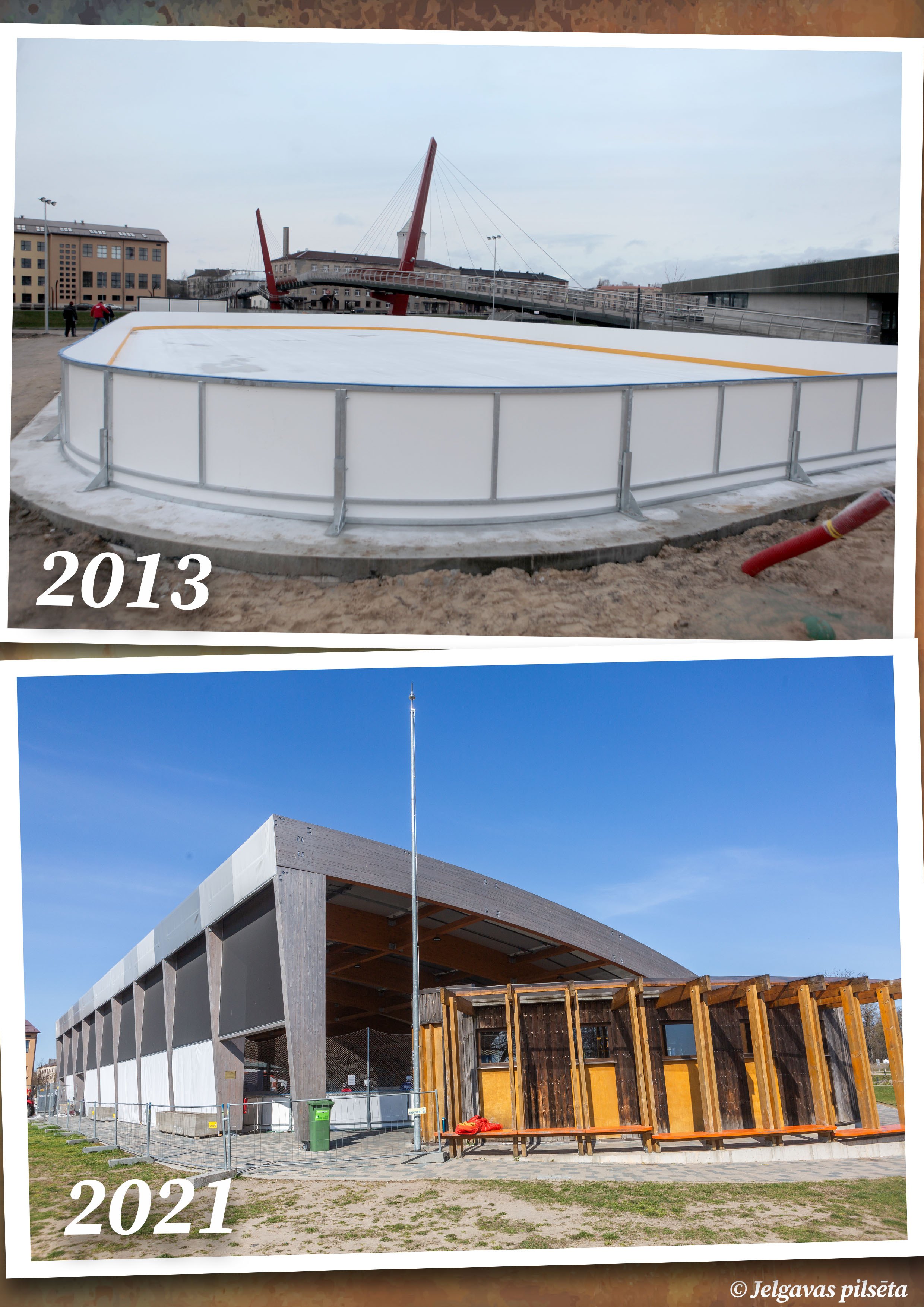
The roof structures cover the rink, the adjacent cooling system, as well as bleachers, providing seating for 100 spectators around the rink. A cover has been installed on the roof and side planes to protect the rink from wind and precipitation.
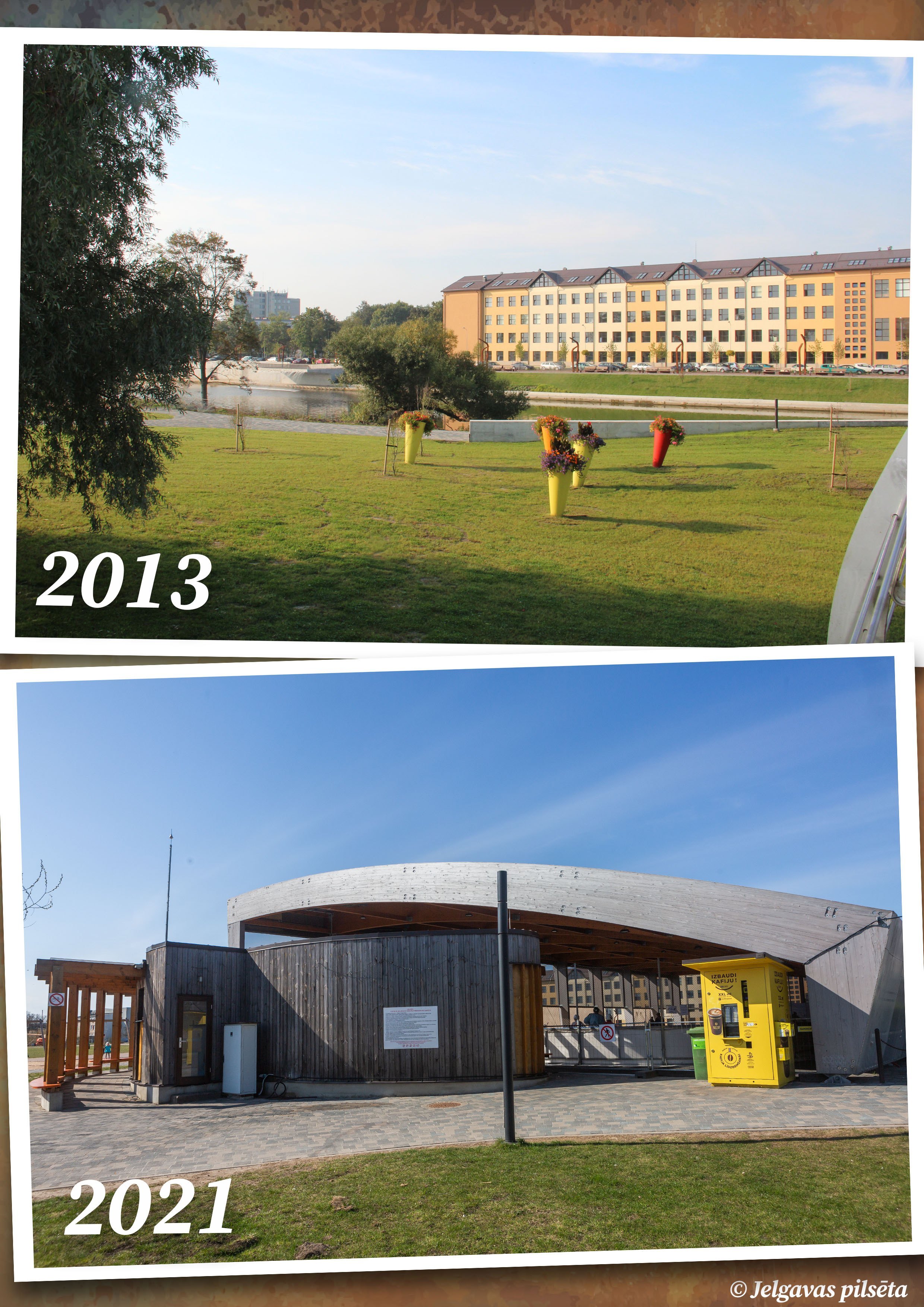
As the cold seasons nears its end, the rink is adapted for inline skaters or for specific events, such as a basketball tournament, which can take place regardless of the weather, providing an opportunity to hide from the sun and rain.
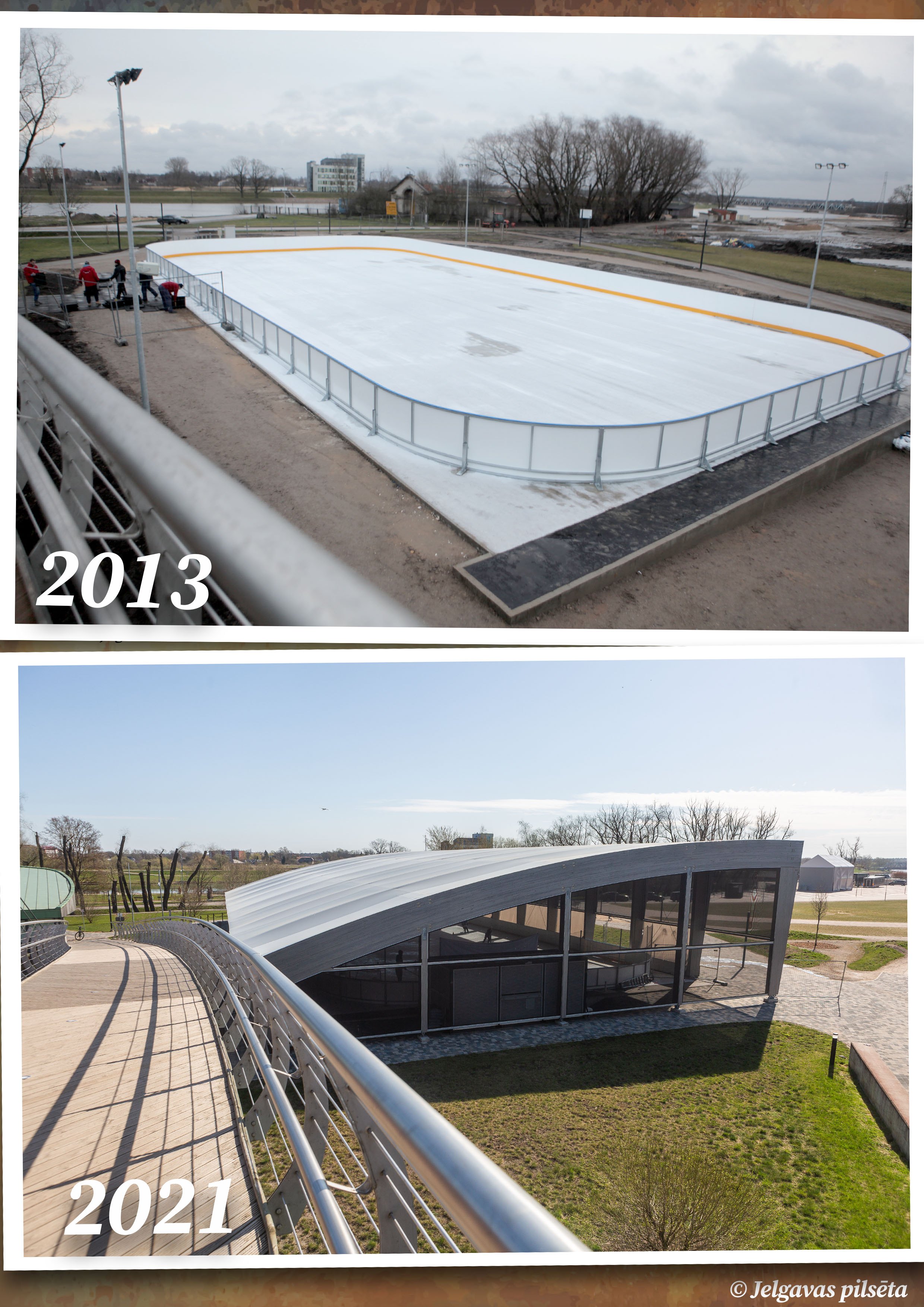
The roof of the Post Island public skating rink has been recognized as the best wooden building in Latvia in the competition “Latvian Construction Awards 2018”.

In order to improve the quality of vocational education at Jelgava Crafts Secondary School and to develop the school infrastructure and modernize teaching equipment, the Jelgava Crafts Secondary School underwent a reconstruction that took place in two phases. The first phase of the project lasted from 2010 to 2011, while the second – from 2018 to 2020.
In the first phase of reconstruction, production workshops, tasting halls, classrooms and laboratories were established in Jelgava Crafts Secondary School. The necessary technological equipment was installed and furniture was purchased to ensure the functionality of the classrooms.
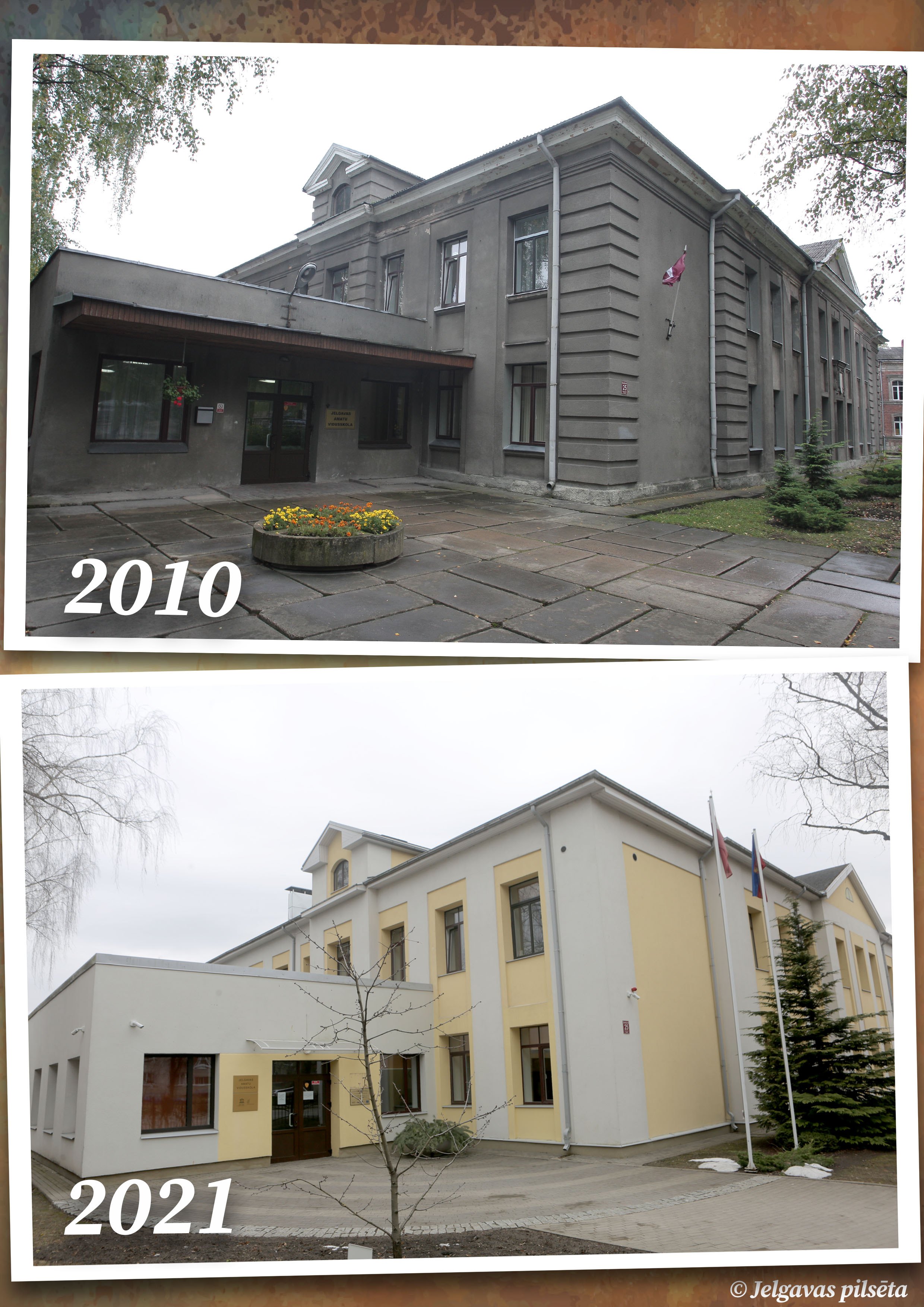
In the second phase of reconstruction, to improve the facilities for the future chefs in-training, an extension was built to the school building at 25 Akadēmijas Street, which houses a training kitchen, confectionery workshop, warehouse, dishwasher, training and tasting room, as well as a wardrobe for students. An extension was also built to the school building at Elektrības Street 8, where the metalworking laboratory was expanded.
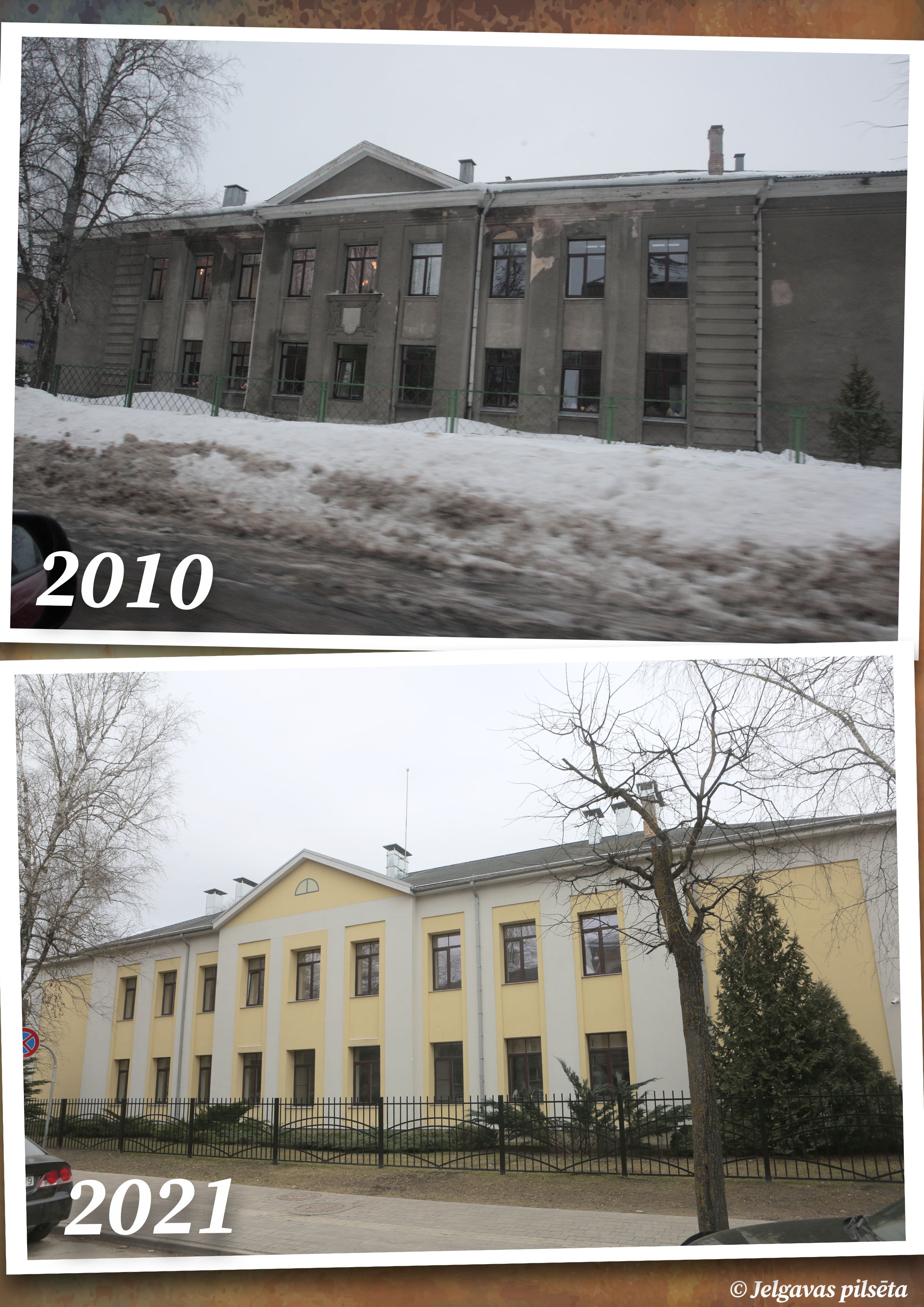
During the construction work, several study rooms and premises for recreation were reconstructed, a transition to the new outbuildings was created, both courtyards were landscaped, the territory was greened and a small parking lot and bicycle parking lots were created near both buildings.
The entirety of school territory was fenced-in, while the school gym underwent significant changes as well.
In 2020, the driveway leading to Jelgava Crafts Secondary School was rebuilt in Elektrības Street.

In order to improve traffic safety and comfort for one of the city’s main transit highways, changes were made to the Lietuvas highway in the section from Miera Street to Rūpniecības Street from 2012 to 2013.
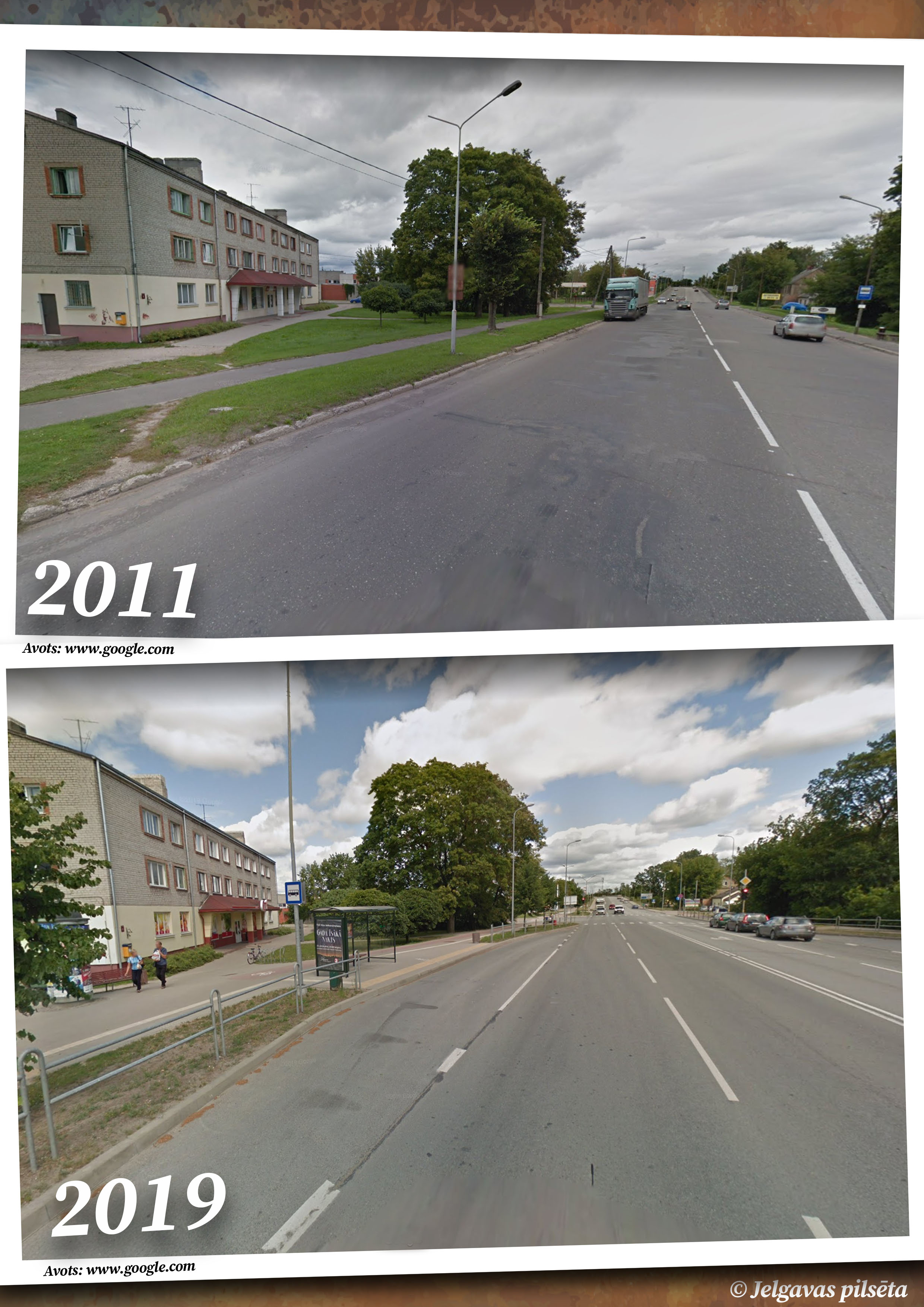
During the reconstruction, 4 lanes were built on this section of the Lietuvas highway, two in each direction, with bus stops and canopies. The surface of the carriageway surface and the surface of the carriageway of the railway overpass was restored, electricity supply networks were arranged, a new traffic light was installed at the intersection of Lietuvas highway and Savienības Street, as well as traffic lights at the intersection of Lietuvas highway, Miera Street and Platones Street were equipped with sound signals. All sidewalks have built-in lanes with a guideline structure, allowing visually impaired people to navigate the directions of the sidewalk.
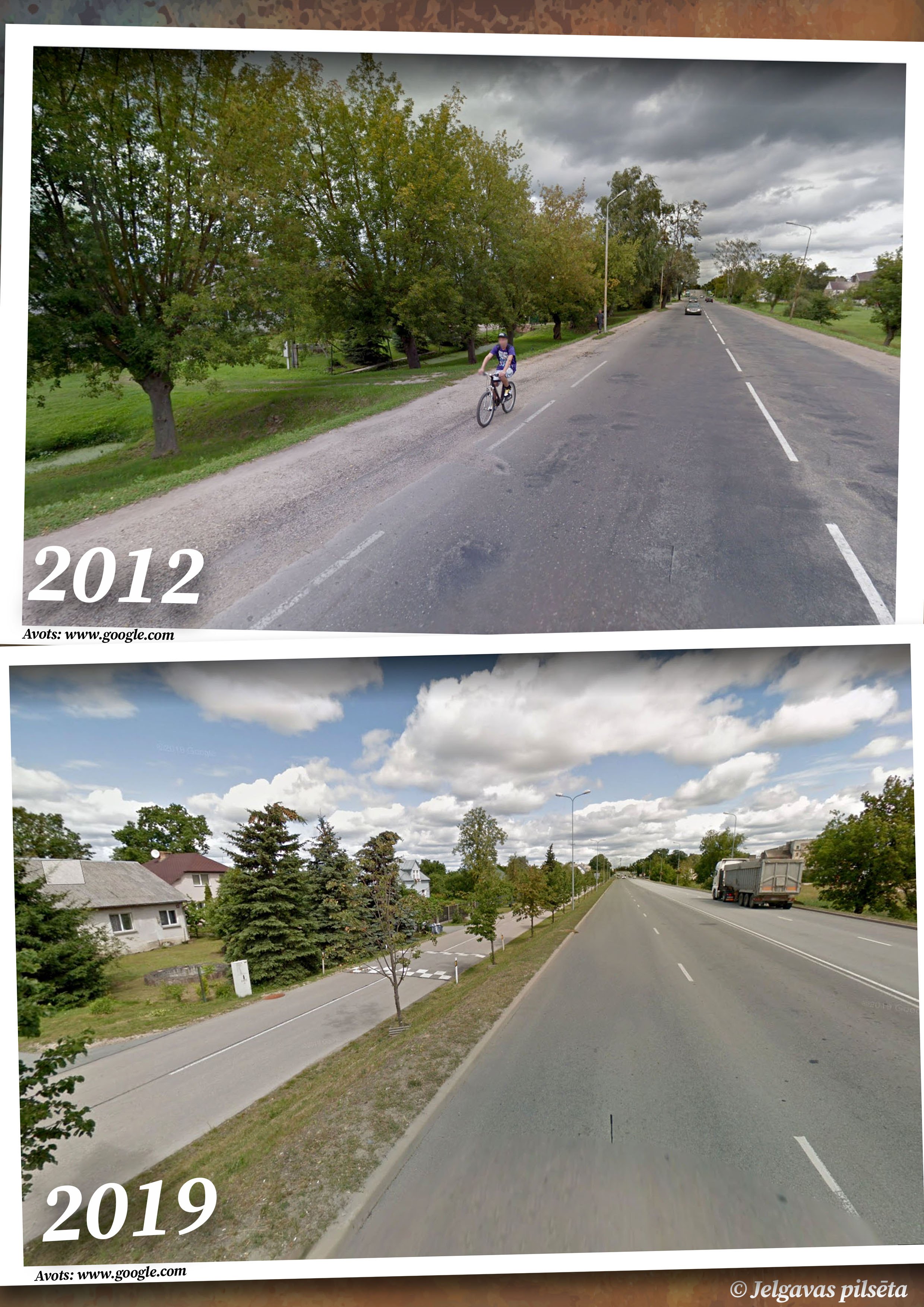
A six-meter-wide parallel road with asphalt pavement for pedestrians and cyclists has been built along the right-hand side of the Lietuvas highway between Savienības Street and Platones Street, and to provide residents with access to residential houses and separate the area from vehicle traffic. New rainwater drainage networks with gullies, treatment facilities and a pumping station have also been built so that the rainwater drainage networks operate continuously and the area on the right side of the Lietuvas highway is protected from spring floods.
Repair works on the Lietuvas highway continued in 2015, restoring the pavement from Viskaļu Street to the administrative border of Jelgava.

Jelgava Palace is the largest Baroque palace in the Baltics and one of the few architectural monuments that has survived in Jelgava until the present day. The construction of Jelgava Palace as the residence of dukes was started on the site of the old wooden castle in 1738 according to the project by the Italian architect Francesco Bartolomeo Rastrelli.
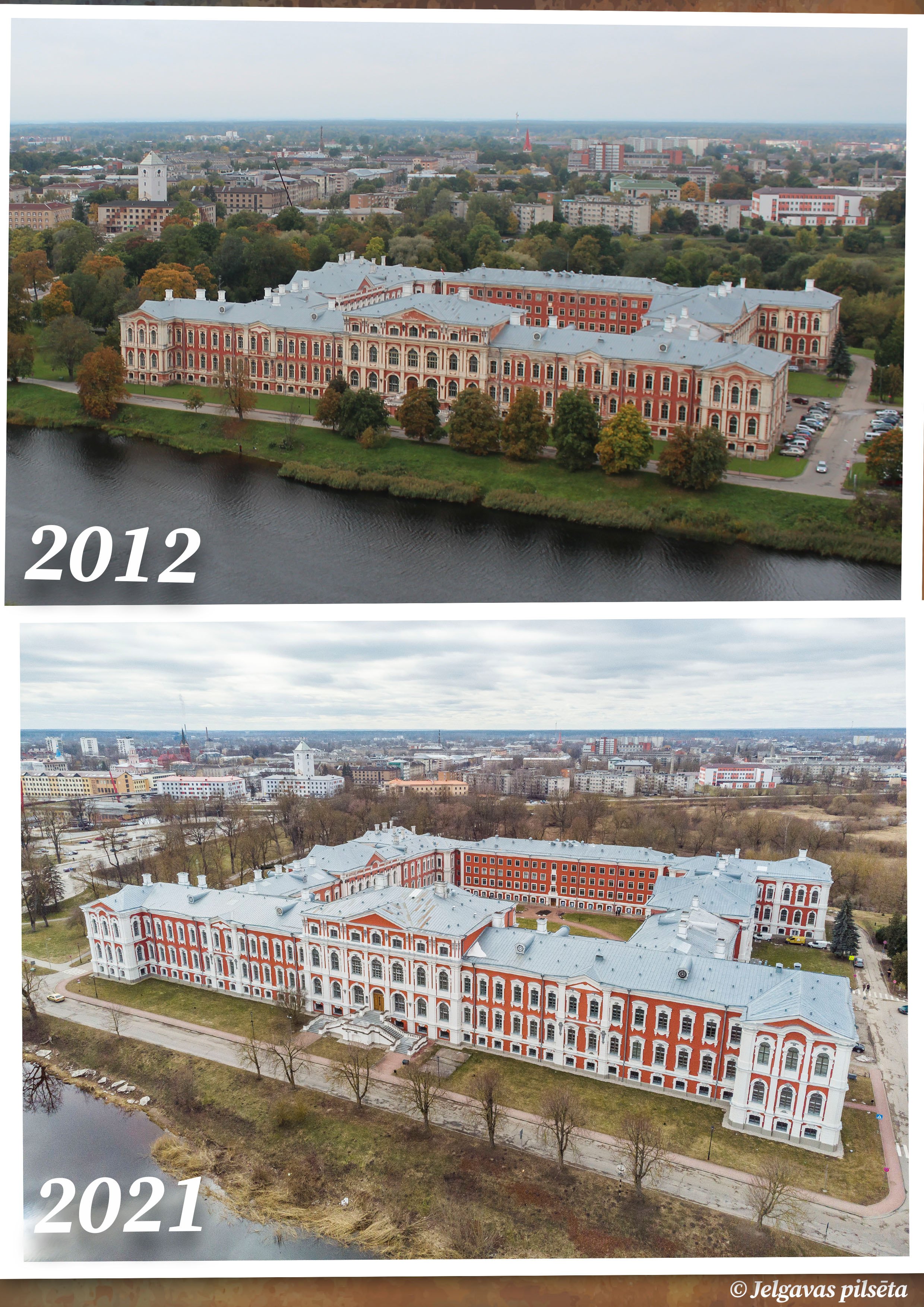
The Palace was destroyed during the Second World War, but it was later restored and is one of the few buildings from capital of the Duchy of Kurzeme and Zemgale that has survived the destruction of Jelgava in 1944.
The Palace underwent more extensive restoration work in the 1950s and 1960s, when the damage done by Second World War was repaired. During several decades, separate parts of the castle and the facade of the courtyard of the building have been reconstructed.
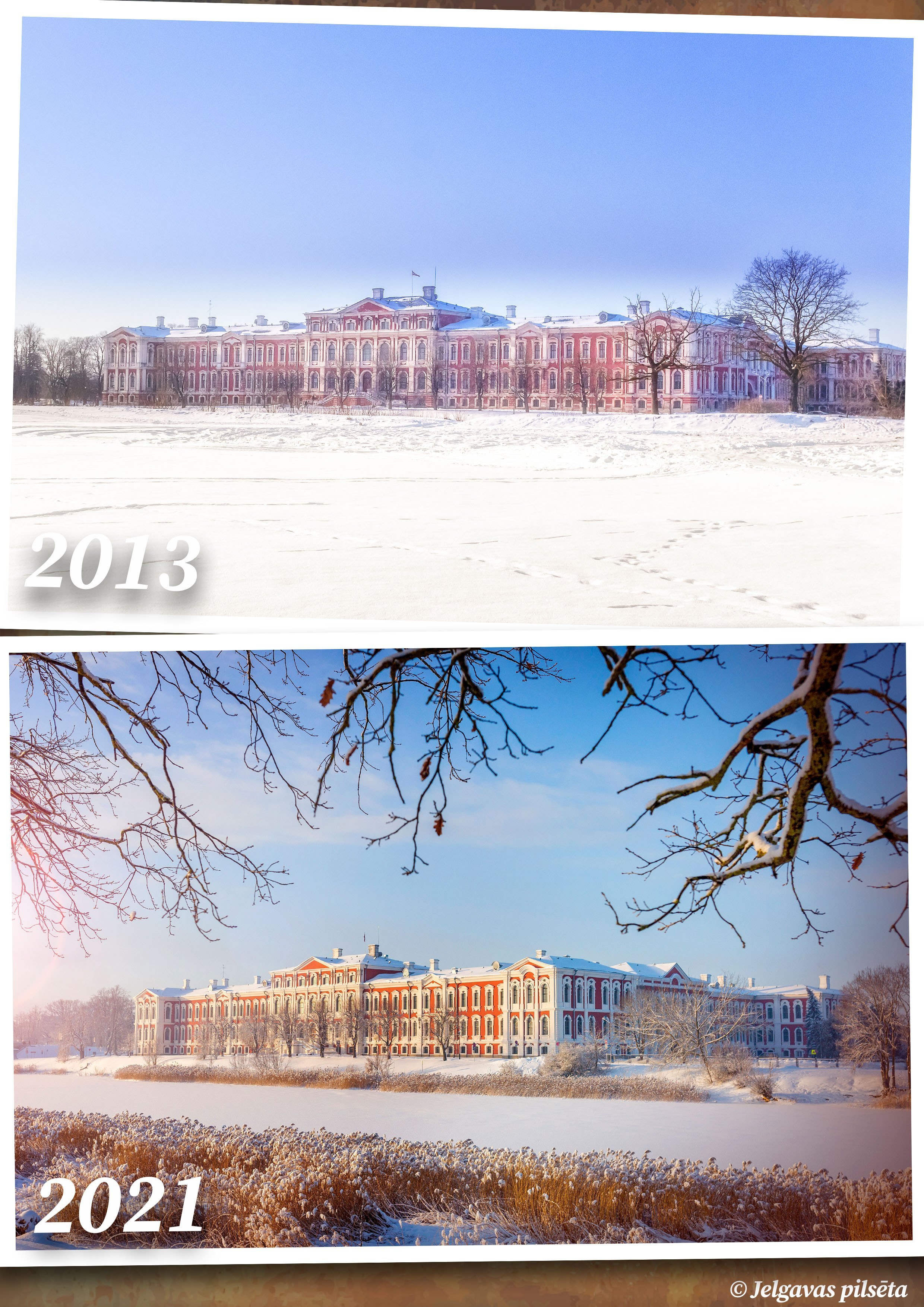
Renovation of Jelgava Palace with the aim to significantly reduce the heat loss of the building was started in 2016 and was done in several stages – first arranging the south-west corner of the palace, then work continued in the castle hall, Silver Hall and administrative building in the east wing of the castle. The renovation work was completed at the end of 2020.
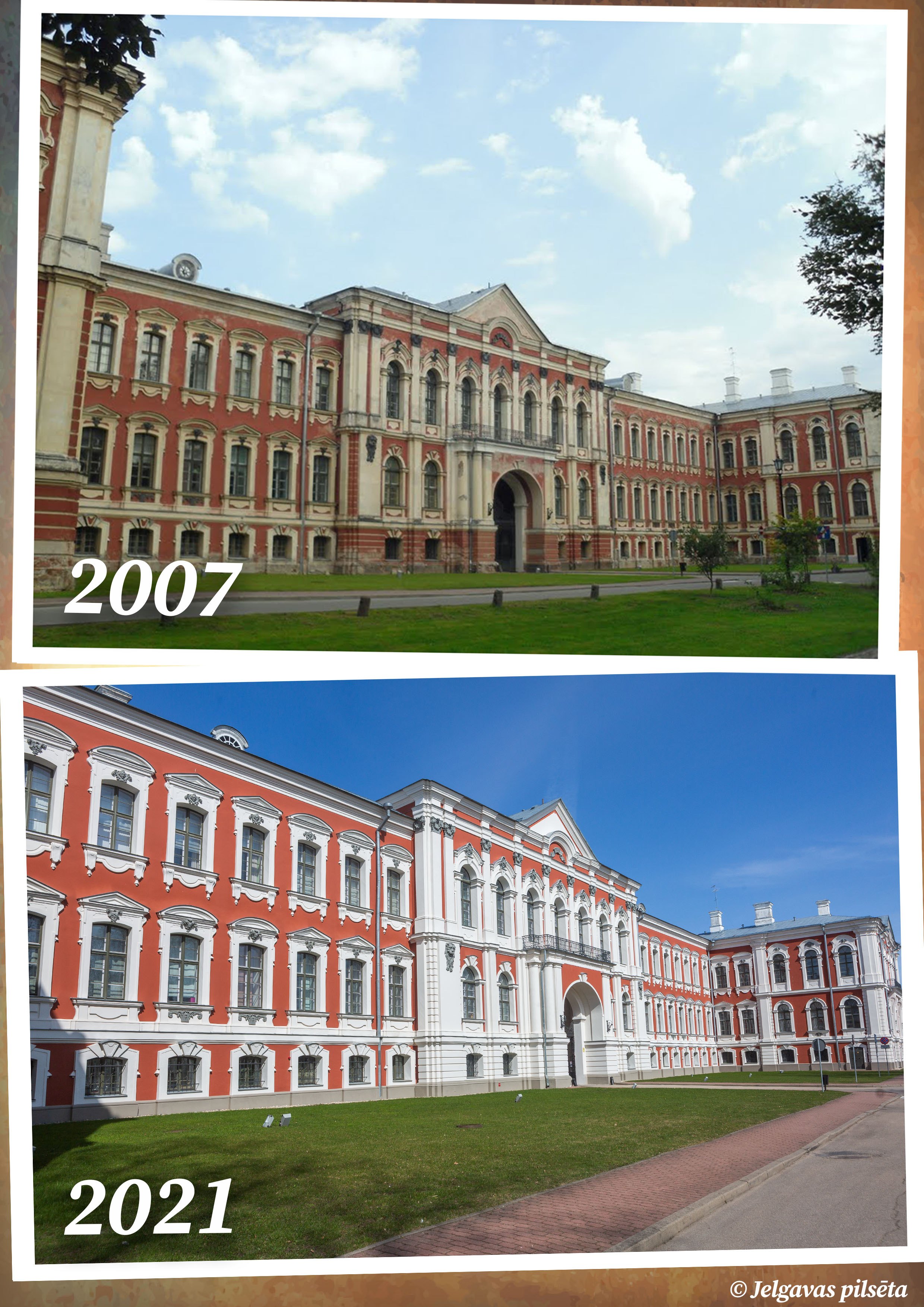
During four years, a ventilation system was built in the palace, 26 exterior doors and six balcony doors were made and restored, 701 new windows were made, 95 windows were restored. Also four balconies of the castle and stairs to the eastern façade have been restored, strengthening the structure and laying a new granite covering. New, master-forged gates for the northern passage have been made as well.
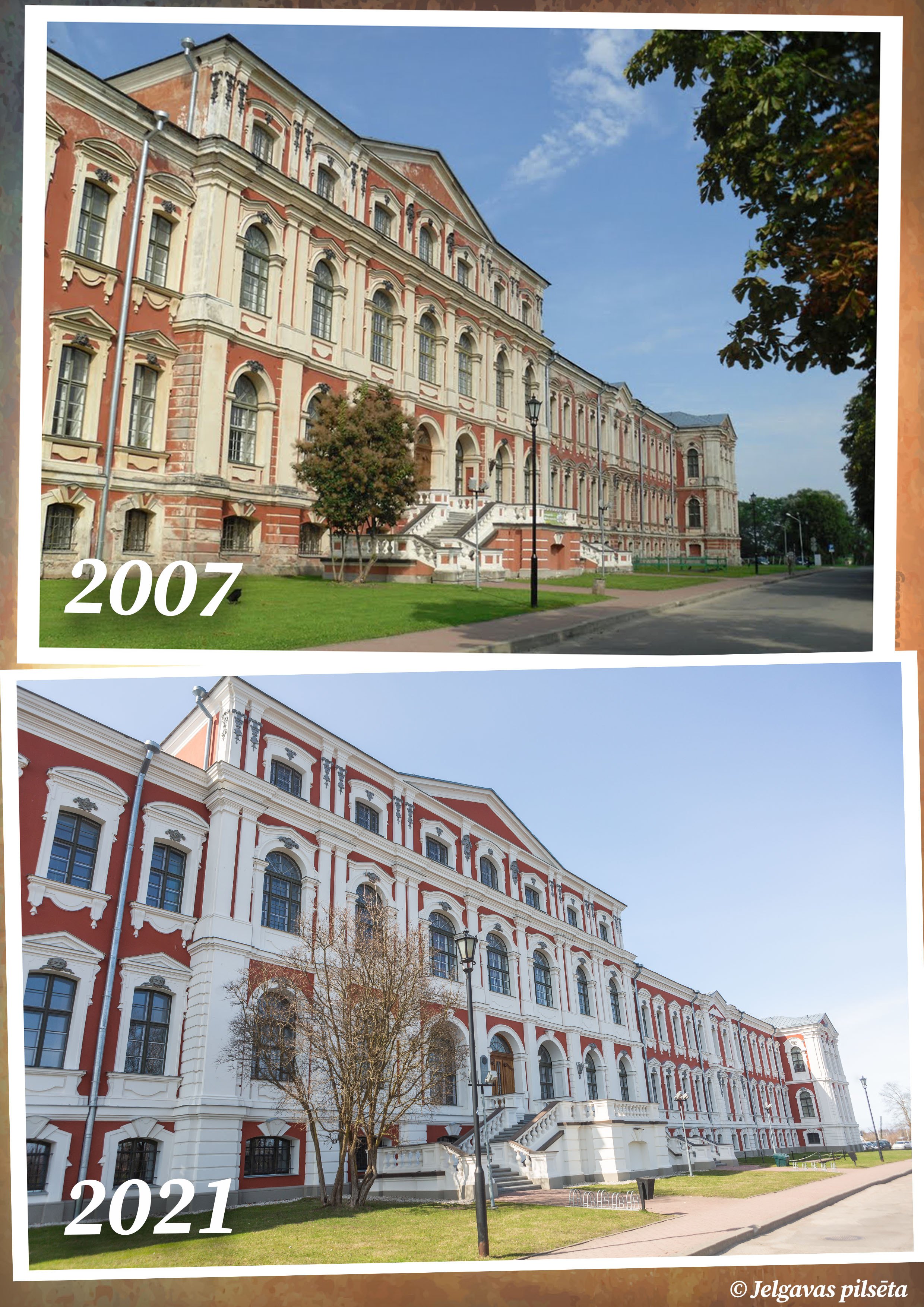

The reconstruction of Raiņa Street from Sarmas Street to Jāņa Čakstes Boulevard with the aim to create a modern and high-quality underground and surface infrastructure in the center of Jelgava began in 2011.
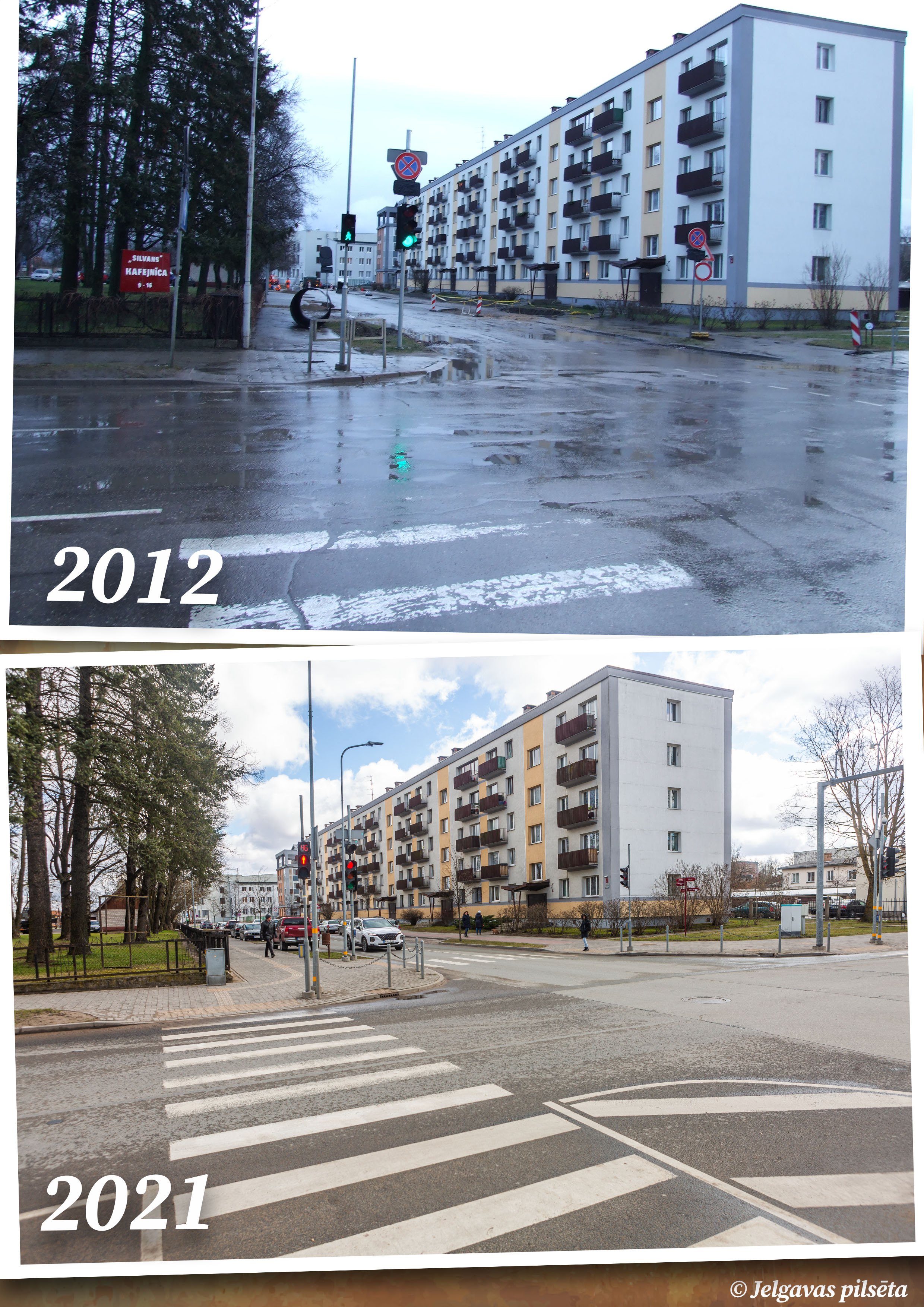
The street surface was completely restored, six intersections were reconstructed, pedestrian sidewalks and a bicycle lane were built, rainwater sewerage was reconstructed, street lighting was restored, new road signs were installed, the street was landscaped and greened during the construction works.
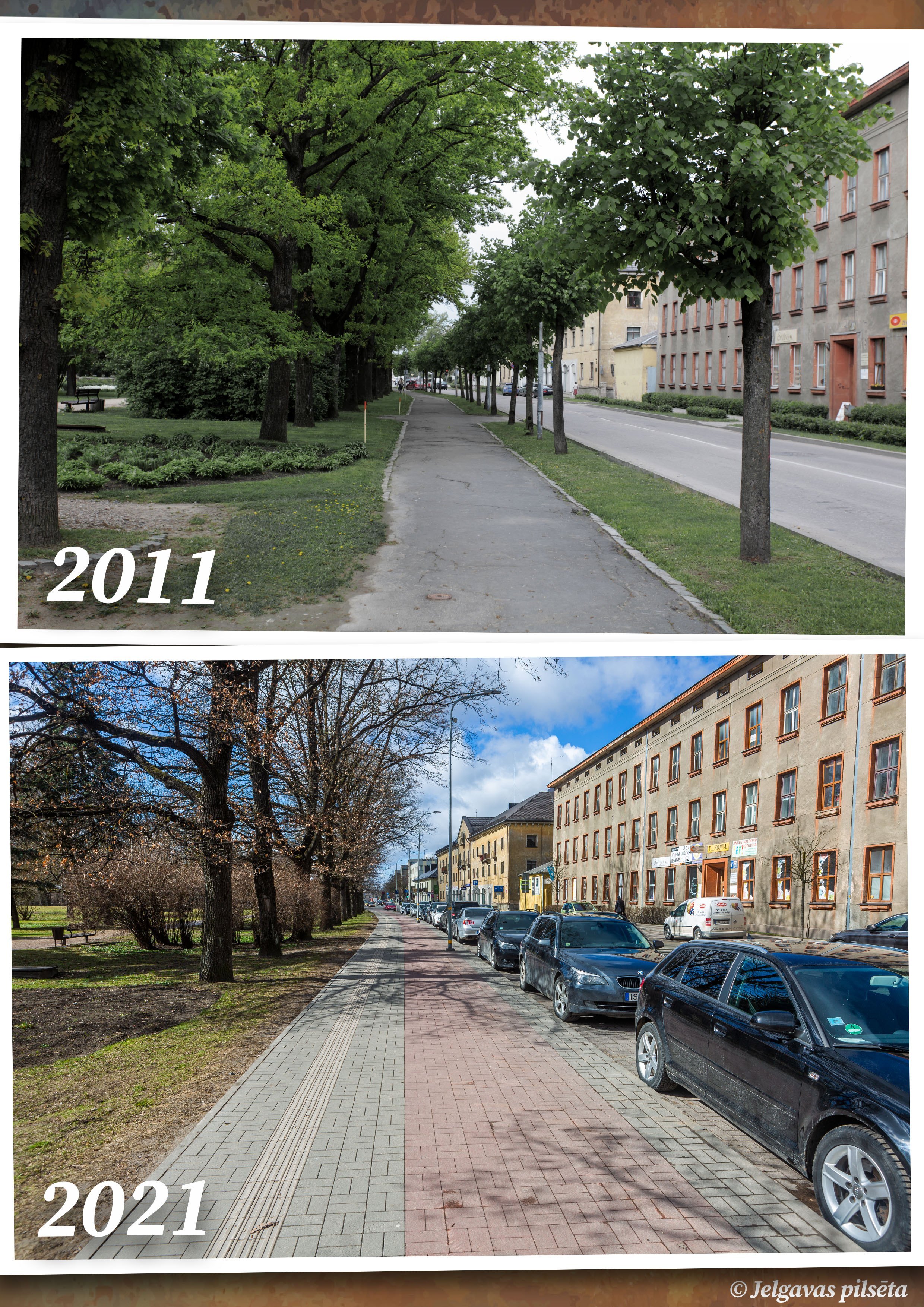
New bus stops have been built and a new poster poles have been installed.
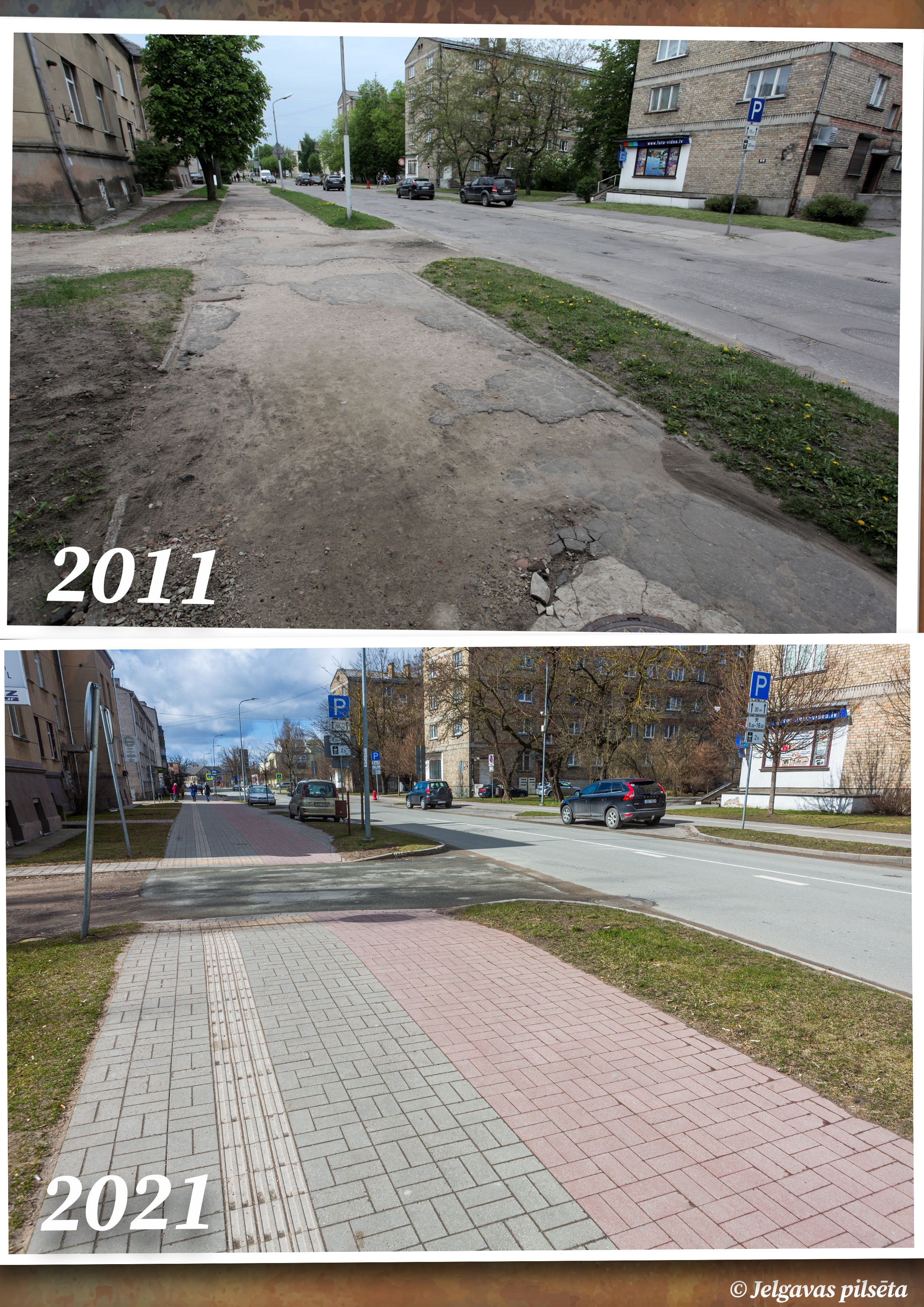
Raiņa Street in its new form after a year-long reconstruction was opened in 2012.
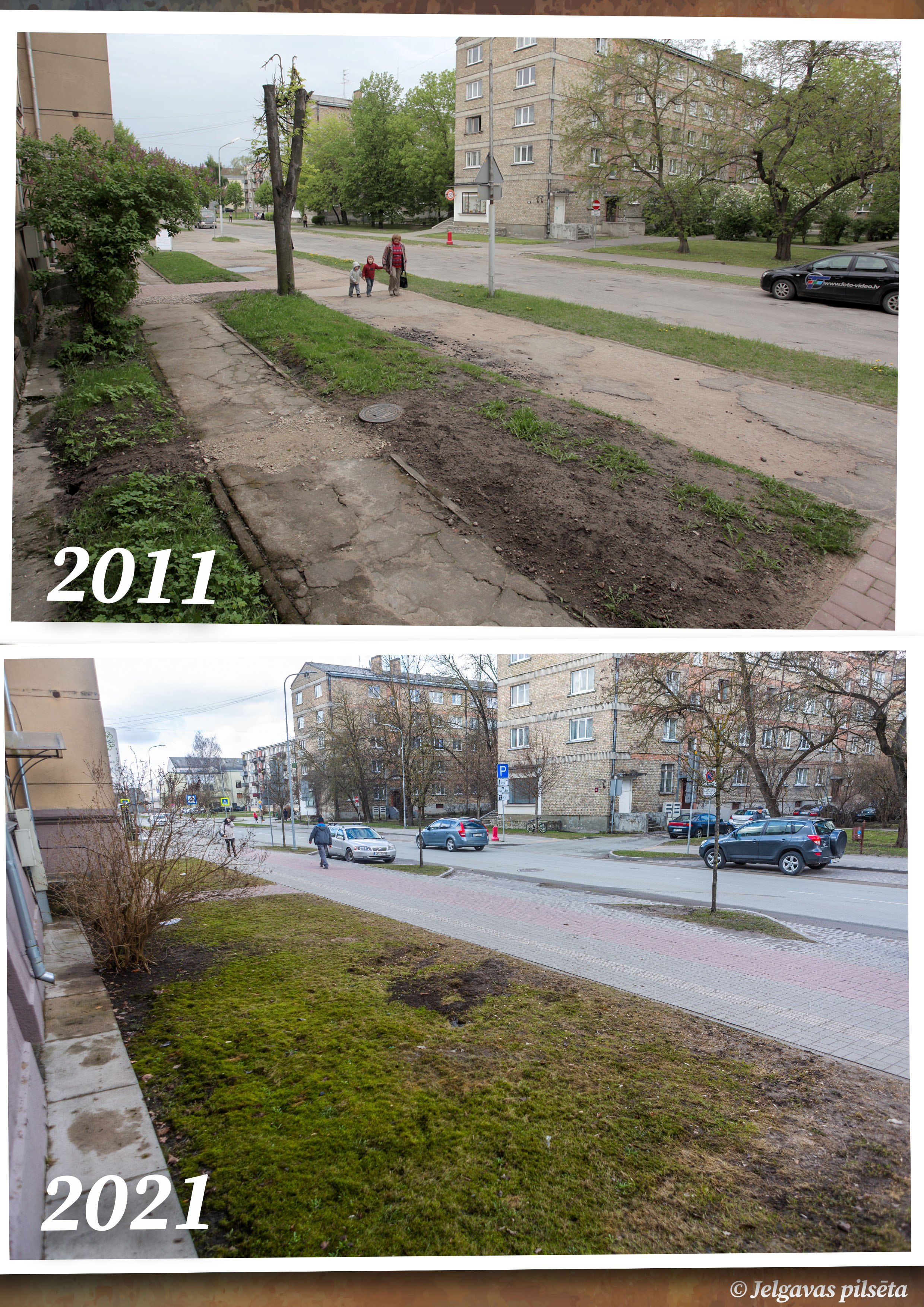

The reconstruction of Jelgava Secondary School No.4 began in 2007 and was completed at the end of 2010. The school building was rejuvenated, with its windows and doors replaced, an insulated facade, newly built roof, ventilation and heating system, as well as a new three-storey extension that has been built, a unique part of which is a concert hall with an excellent acoustic solution.
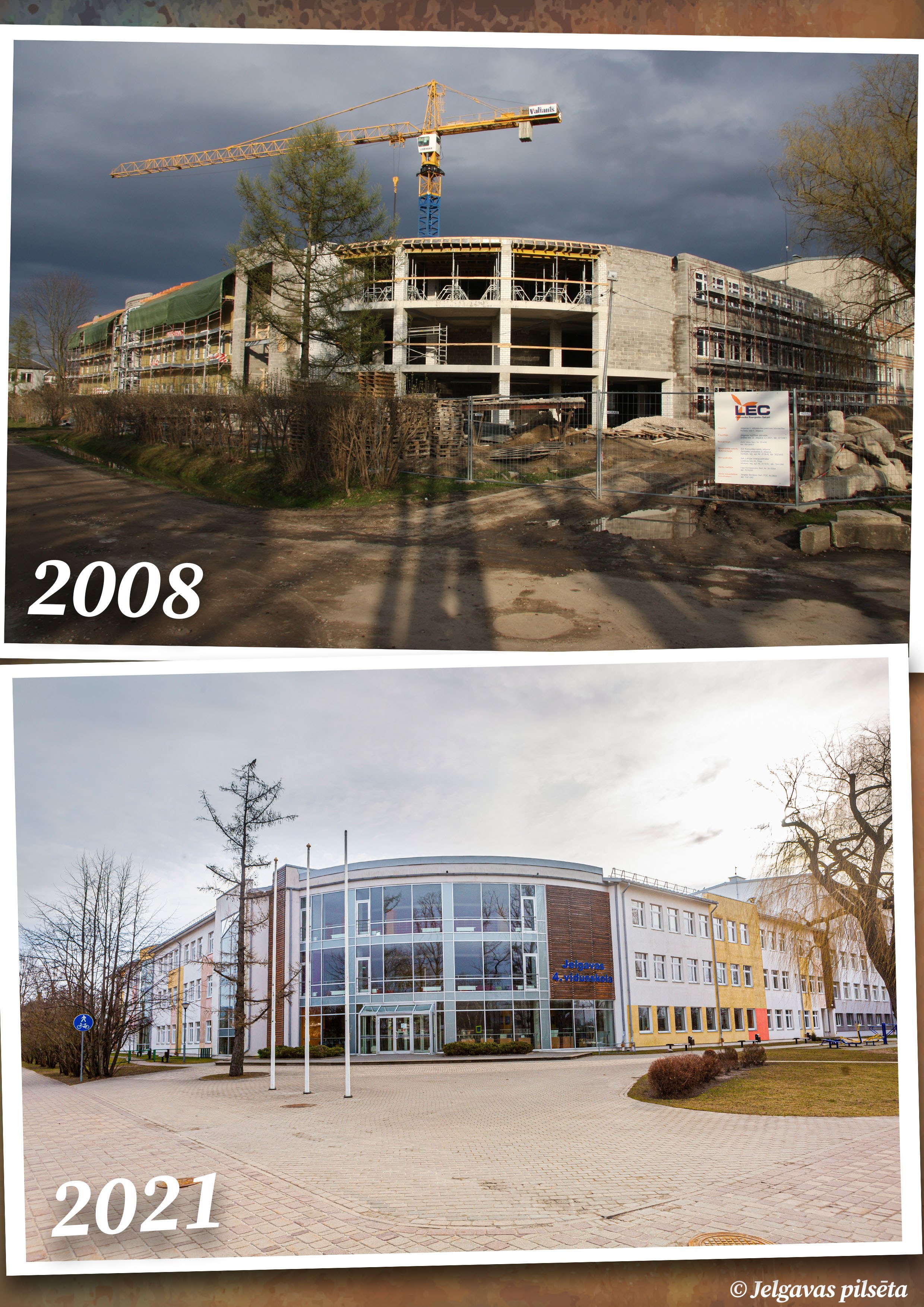
Along with the reconstruction of the school building, its surroundings have been improved, a parking lot and the streets adjacent to the educational institution have been built.
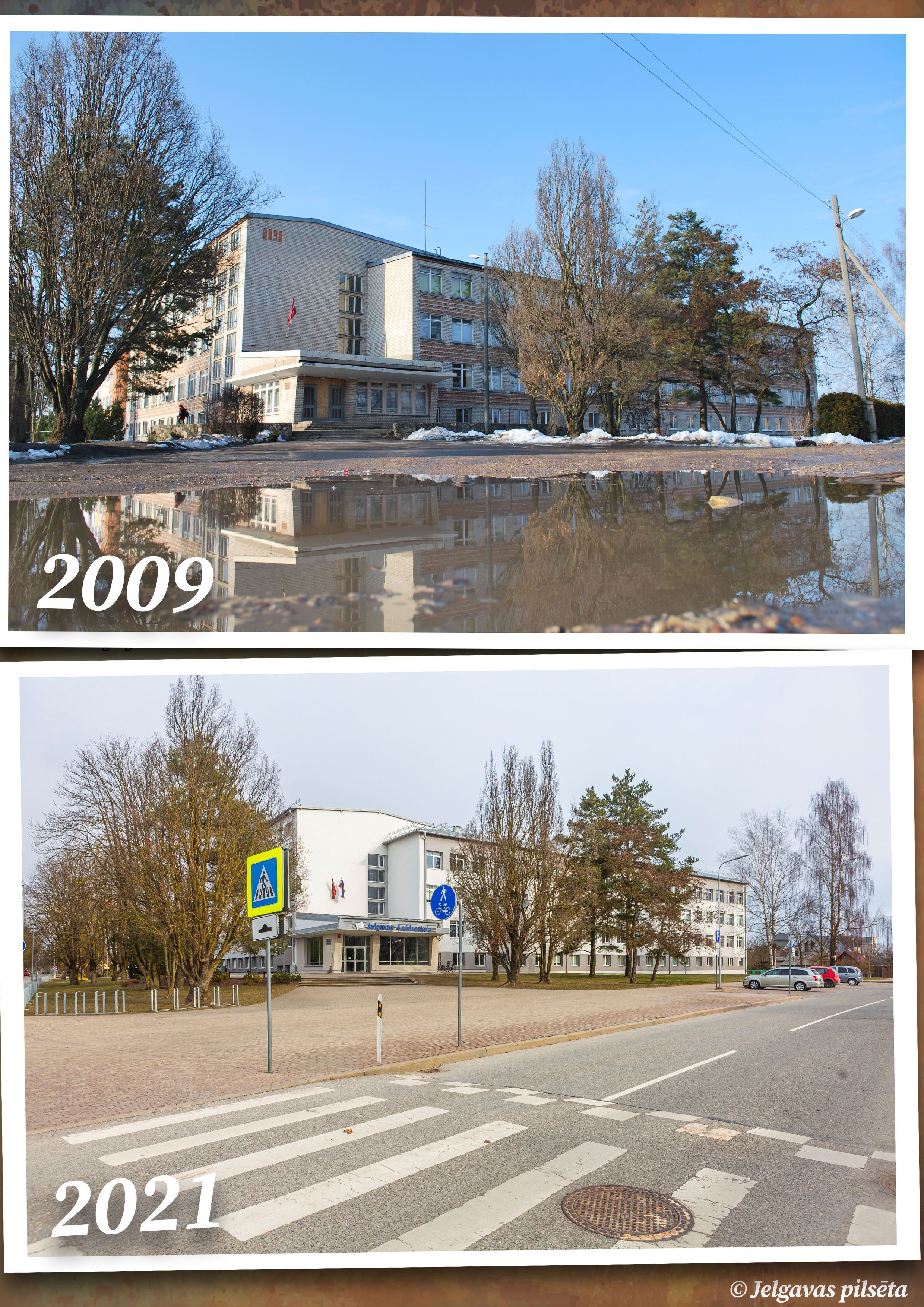

Strengthening and improvement of the Lielupe shore 170 meters in length began in Pilssala in 2018 with the aim to modernize Pilssala rowing base and develop water sports in the city.
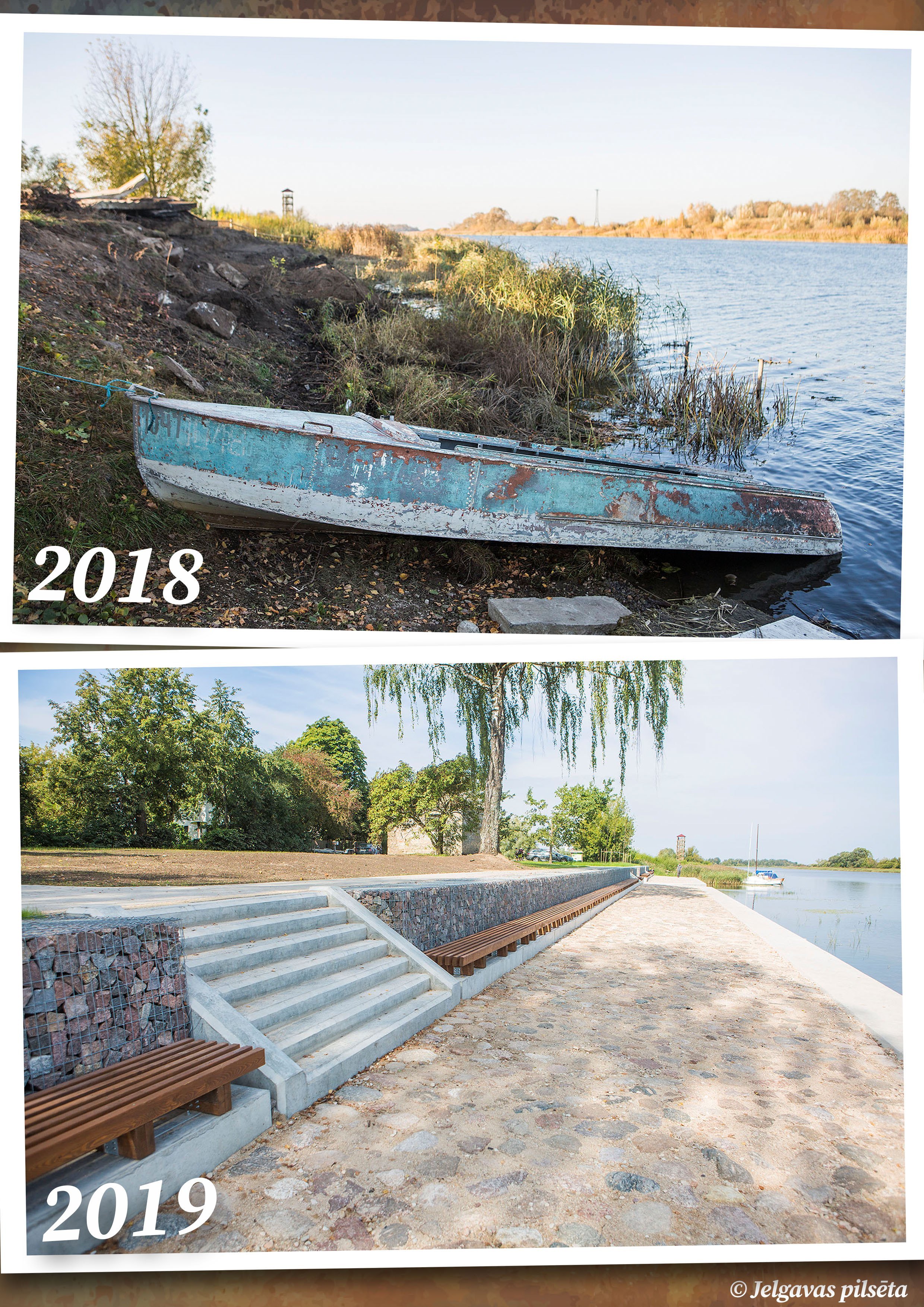
First, bushes were cut, reinforced concrete slabs and stairs were dismantled, and the riverbed was cleared in the shoreline with an excavator. In this area, a five-meter-high corrugated wall, which is the main element for fortifying the river bank, has been built at a depth of about three meters, a three-meter-wide reinforced concrete staircase has been built in five places, providing access to the river and three slips for launching boats and other small floats.
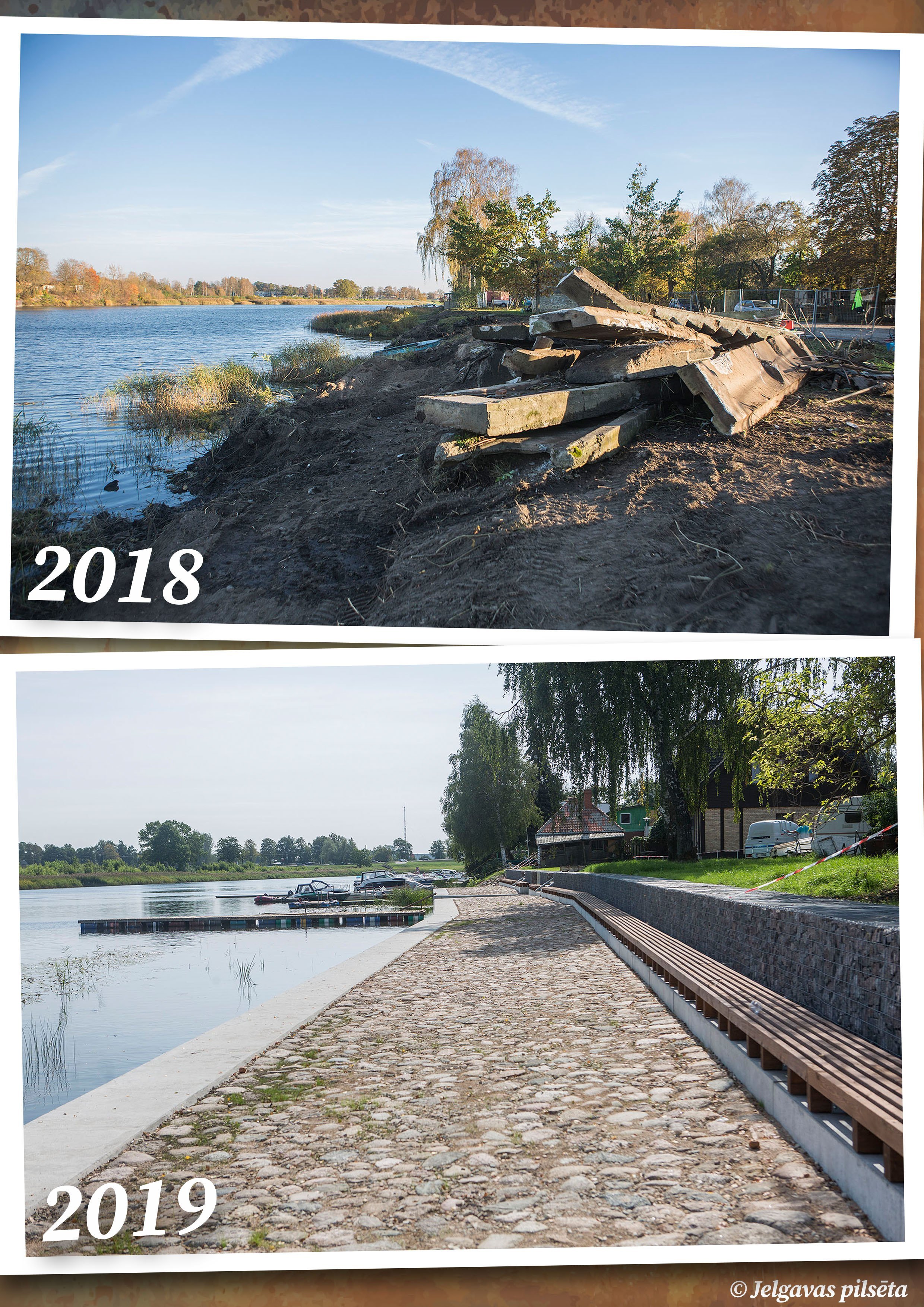
Also, approximately four meters wide pedestrian walking area covered with boulders and a small parking lot for cars has been built on the bank of the Lielupe and landscaped surroundings have been established. The strengthening of the Lielupe shore section was completed in 2019.

In order to ensure a modern study and work environment and increase the energy efficiency of the building, Jelgava City Municipality preschool educational institution “Sprīdītis” at Tērvetes Street 6 experienced significant changes in 2018–2019.
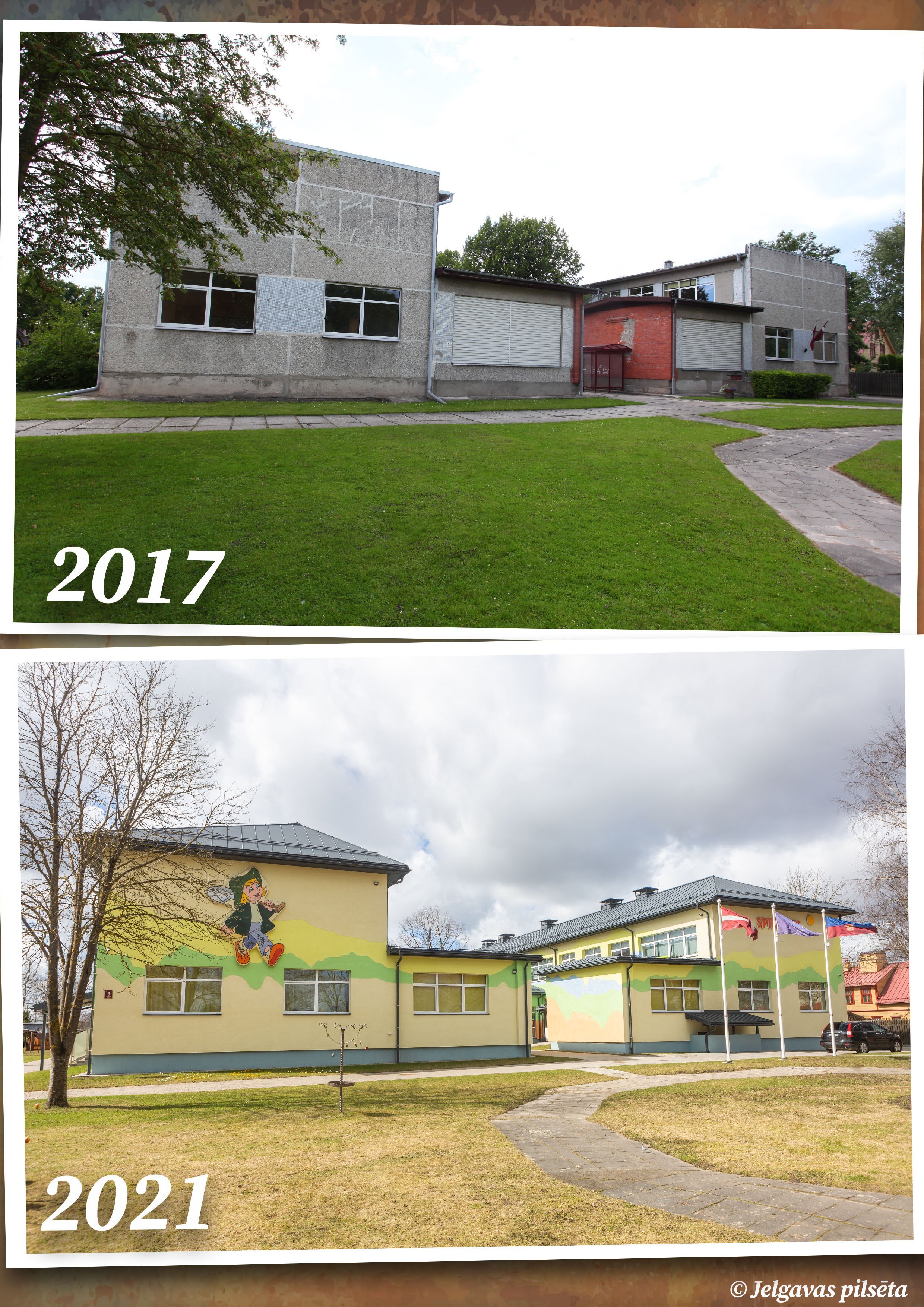
During construction, the plinth part of the building was insulated, windows and exterior doors were replaced, the basement floor and attic were insulated, a gable roof was built, heating system in the premises was restored, ventilation system was reconstructed and the lighting was modernized. In addition to increasing the energy efficiency of the building, the kindergarten also got an attractive exterior facade.
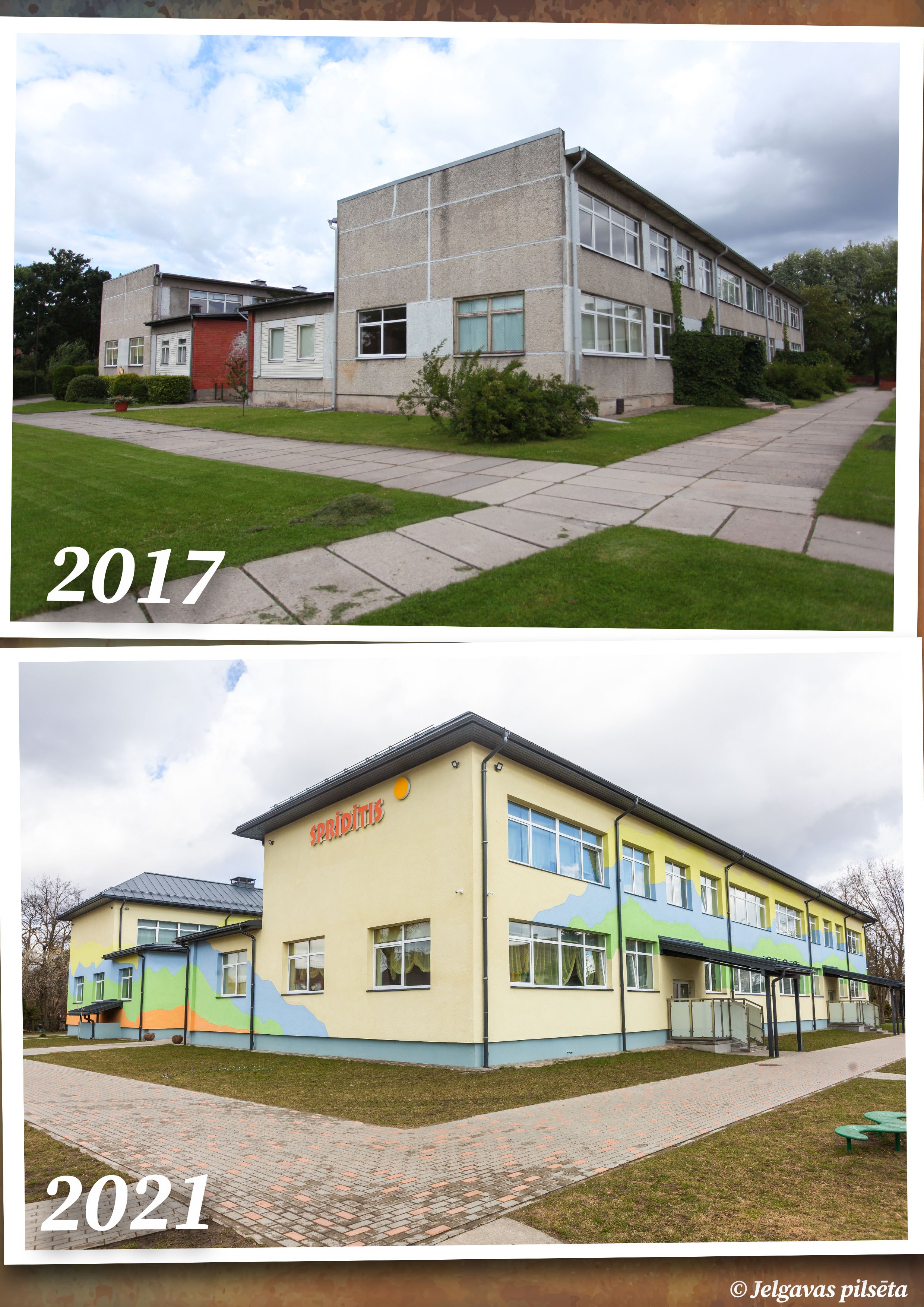
In turn, in 2020, the municipal preschool educational institution “Sprīdītis” expanded. In the former premises of the children and youth center “Junda” at Skolas Street 2, four groups of children who have reached the age of compulsory education were established.

The reconstruction of 1.5 km long Brīvības Boulevard began in 2008. New underground communications, lighting, parking lot, new asphalt pavement and other important works were done.
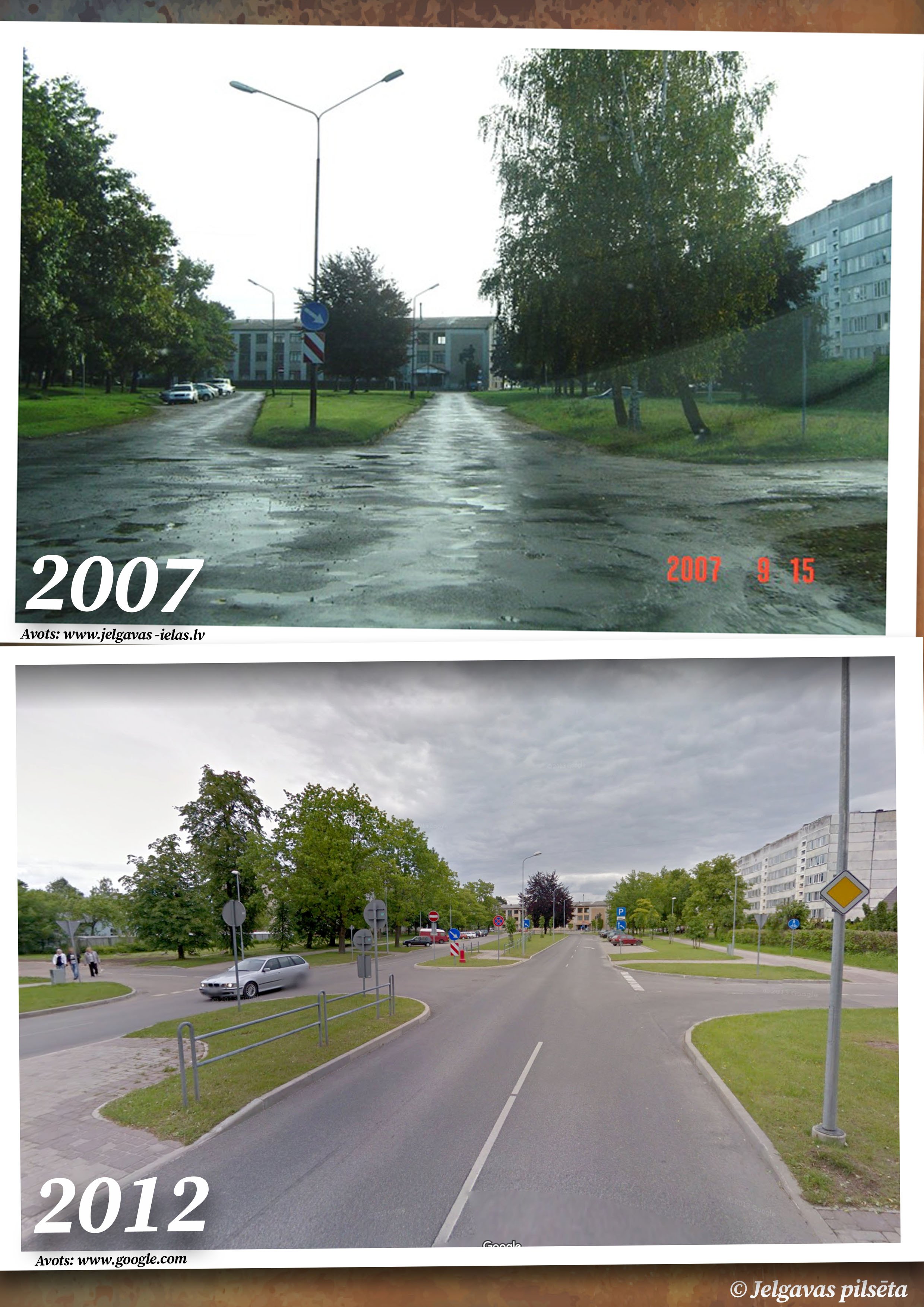
Taking into account the suggestions of the residents, the location of the bus stop was changed, but for traffic safety purposes, traffic lights were built at the intersection of Lāčplēša Street and Brīvības Boulevard.
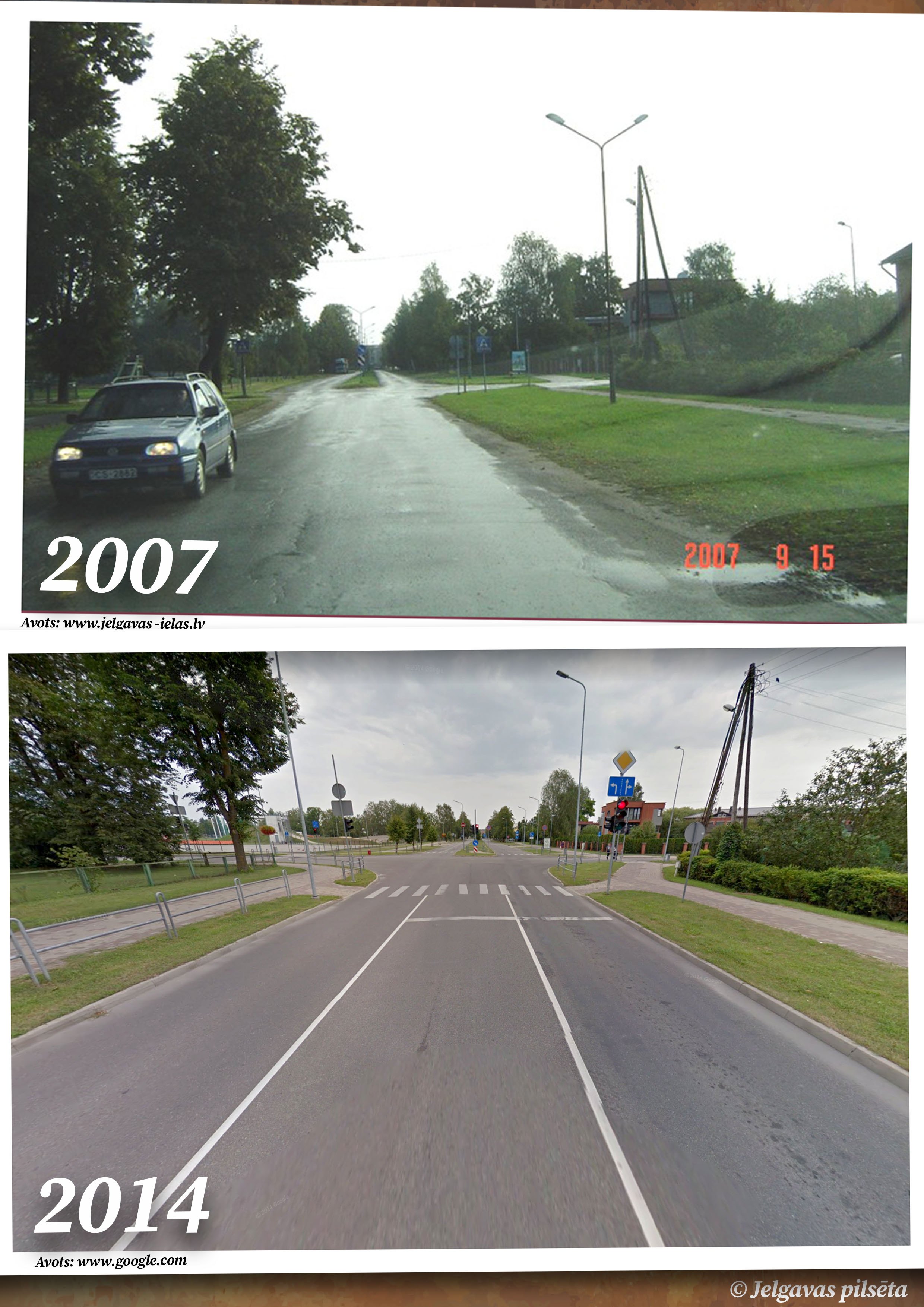
To ensure convenient access to Jelgava City Hospital, Zemgale Olympic Center and several educational institutions, reconstruction and improvement of Brīvības Boulevard was important both for the flow of public and private transport, as well as for pedestrians.
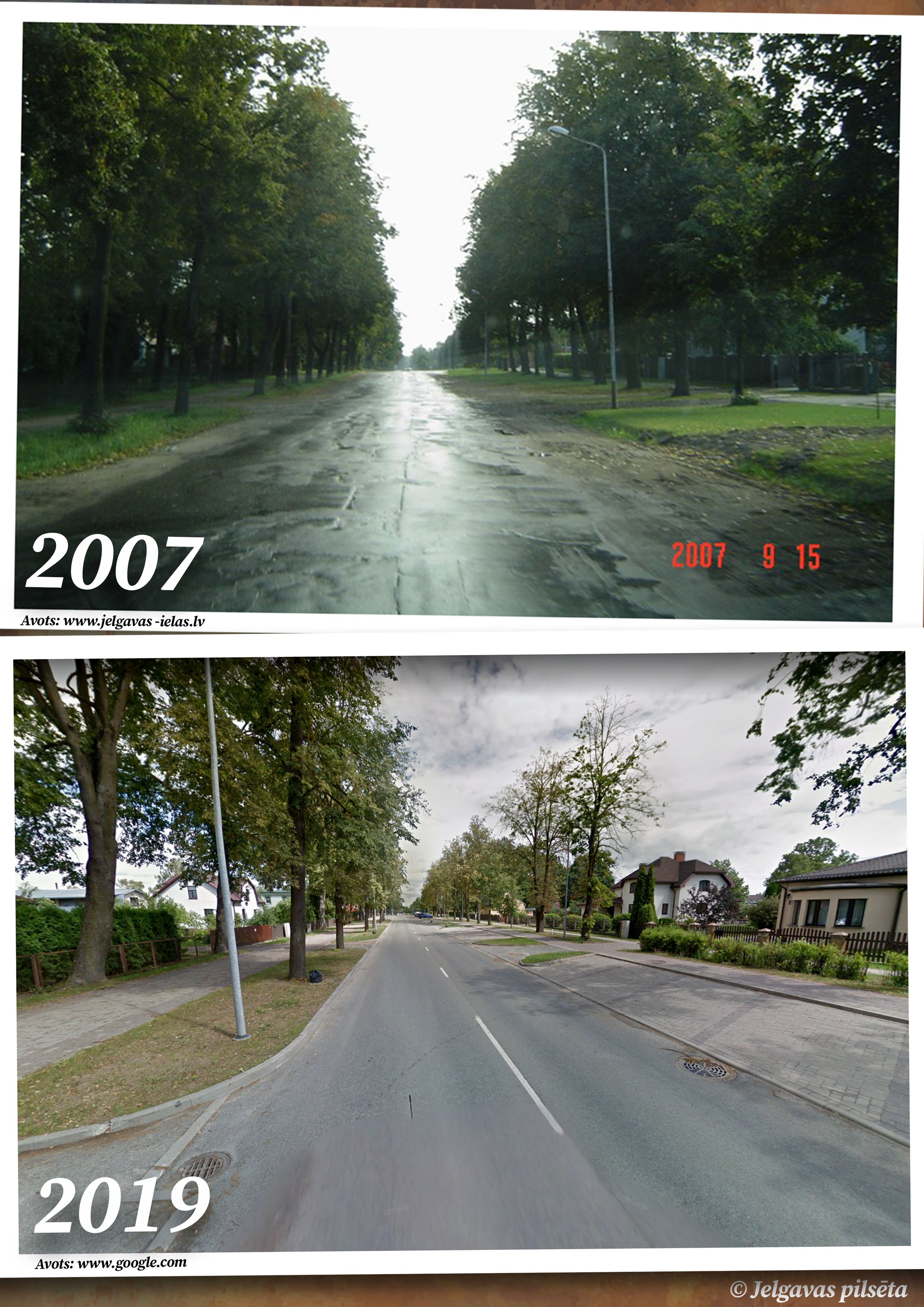
At 31A Brīvības Boulevard, repairs are currently underway and a municipal pre-school educational institution is being built. After the reconstruction of the building and the construction of its extension, it is planned to admit 160 children to the kindergarten.

The environmental object “The Wheel of Time 100” at Lielā Street 38 in the square between Jāņa Asara and Lielā Streets was unveiled by the sculptor Kārlis Īle on May 4th, 2018, marking the 28th anniversary of the restoration of the independence of the Republic of Latvia. It symbolizes each year of the country’s existence.
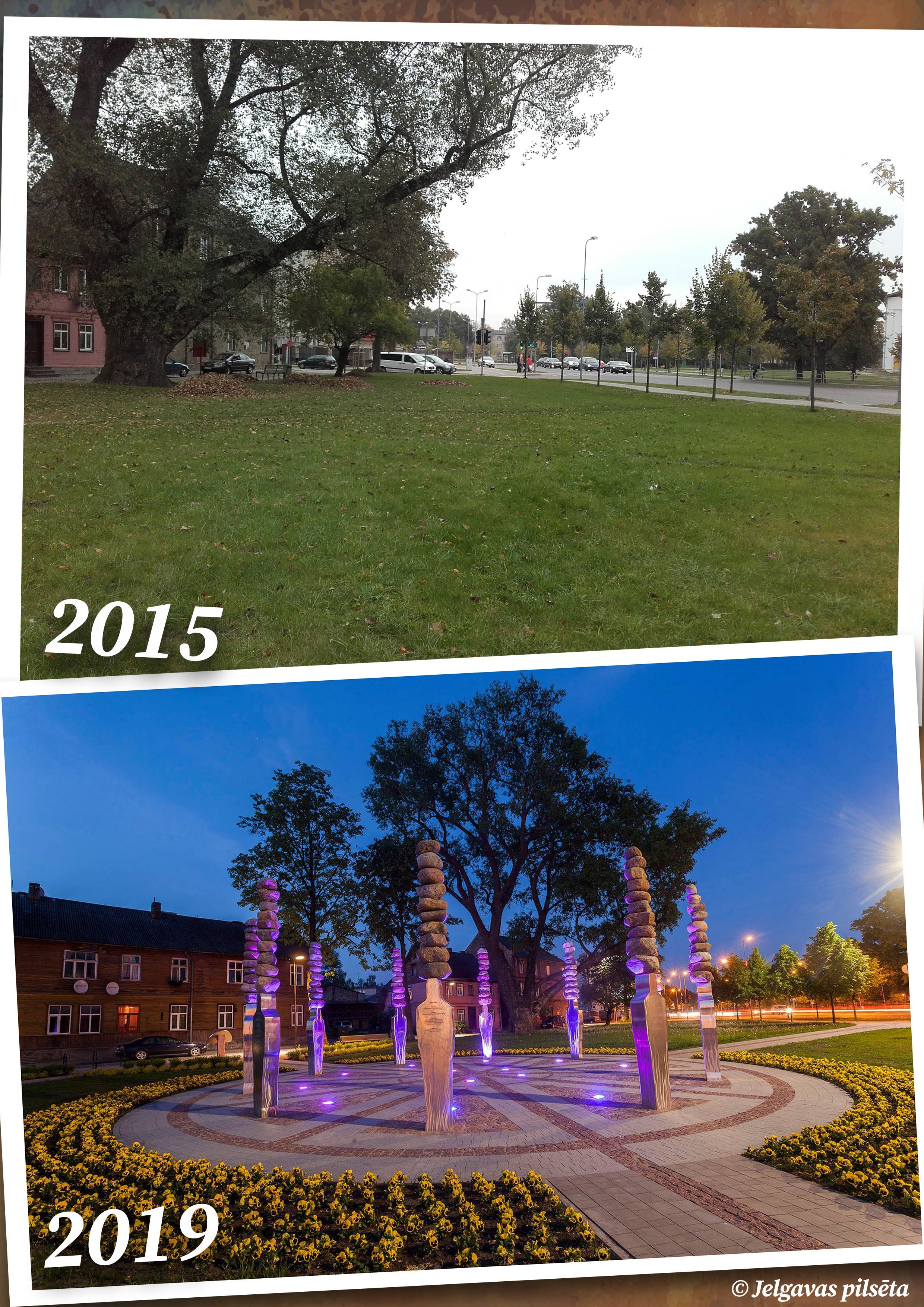
The interactive environmental object “The Wheel of Time 100” within a radius of 14 meters depicts the silhouettes of ten people in full height, each of them symbolizing ten years of our country. Next to each silhouette information about the most significant events of each decade can be read. The star-like paving in the square where the “holders” of Latvia are located, symbolizes the wheel of time that continues to move through the decades.
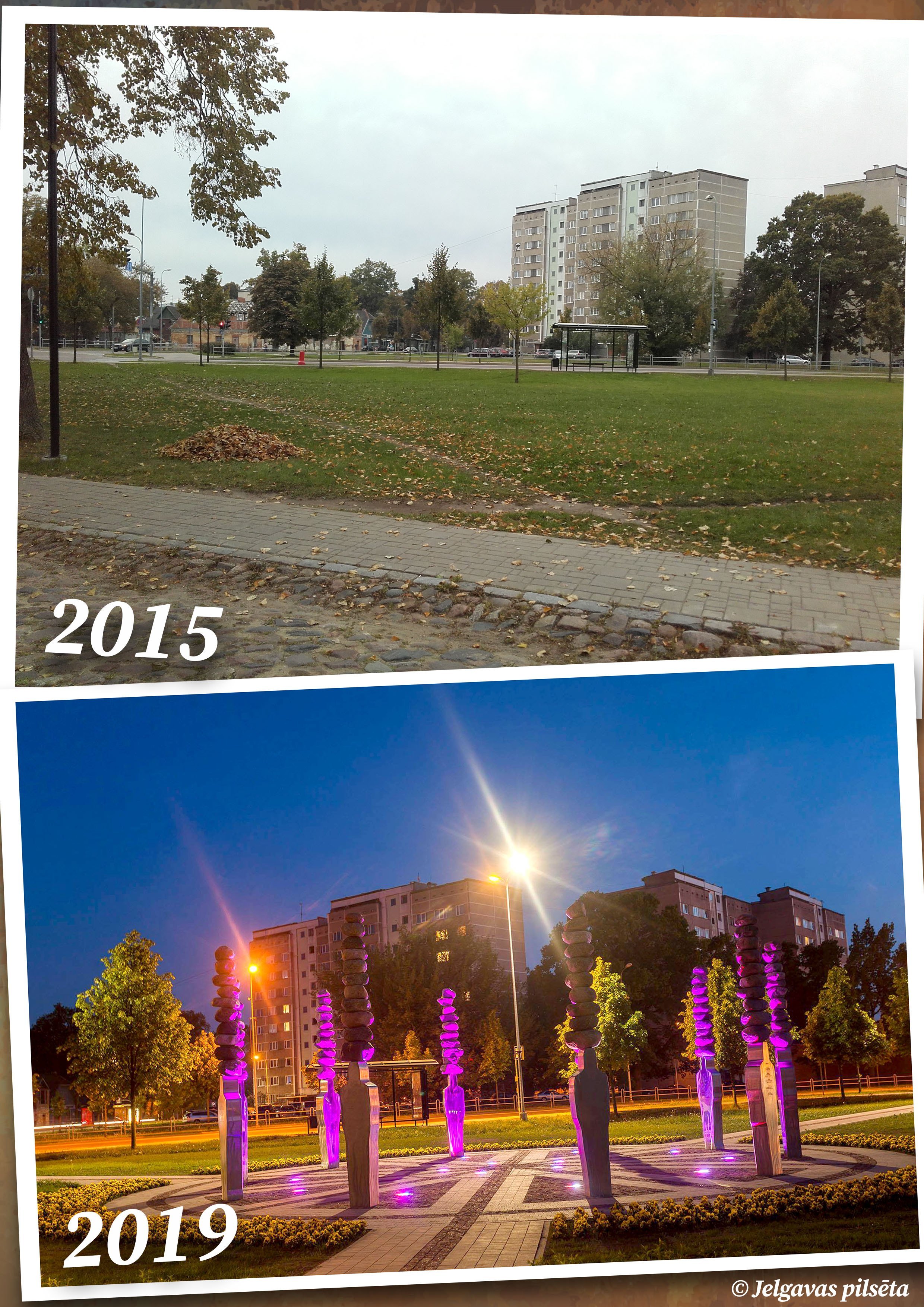
In total the silhouettes hold 100 stones, which symbolize the anniversary of Latvia’s existence, but the images of people – all those who were involved in the formation of Latvia, thus emphasizing that the country is formed by each of us. Human figures are made of brushed stainless steel. The planes facing the square are polished to form a mirror image of the visitors, thus each becoming the bearer of Latvia’s years and the creator of history. The side of figures facing the outside of the circle are engraved with the most important historical events of Jelgava in the context of Latvia.
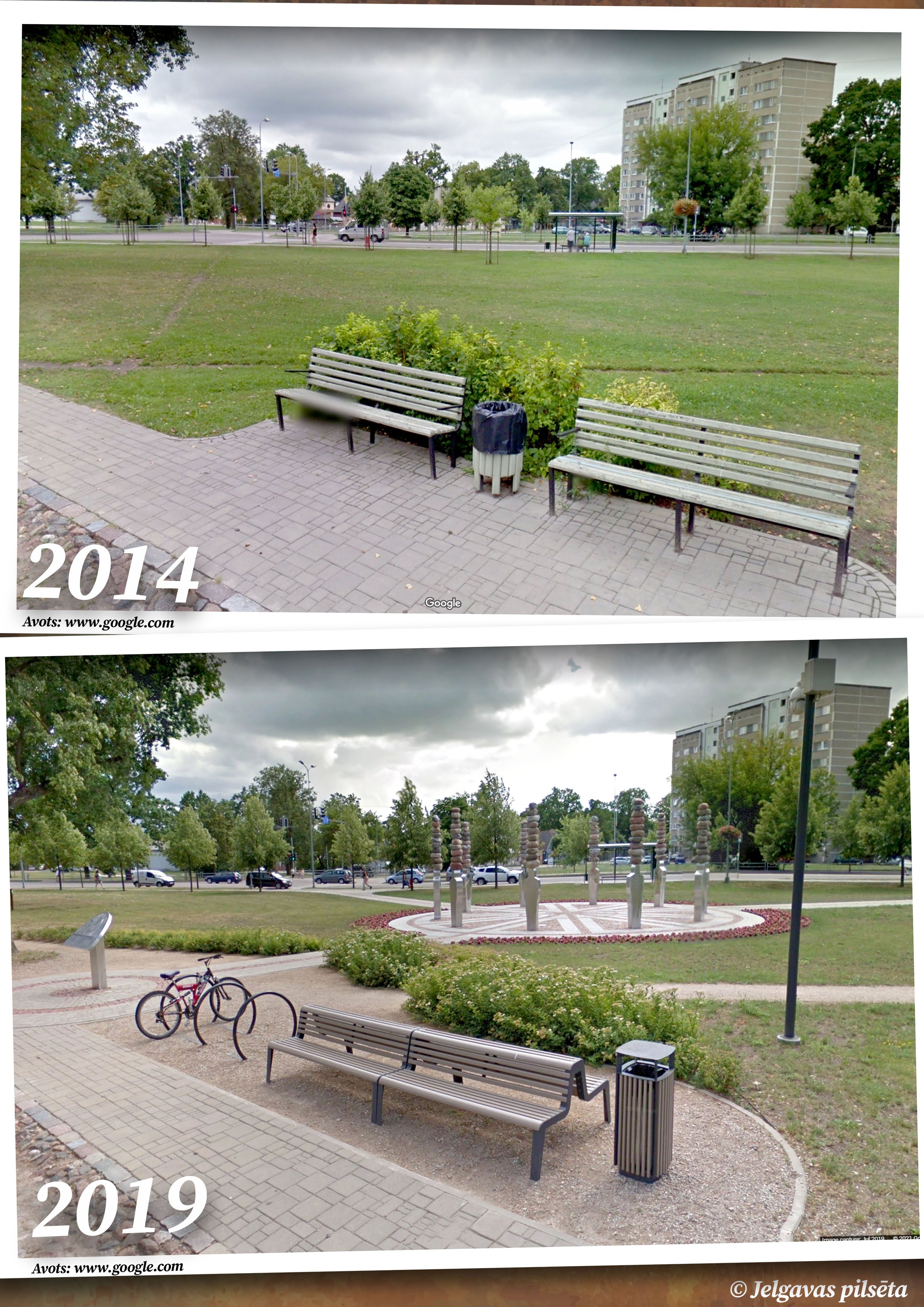

The building of municipal preschool educational institution at Ganību Street 66 began in the summer of 2013 with the aim of providing space for 280 children and 55 new jobs.
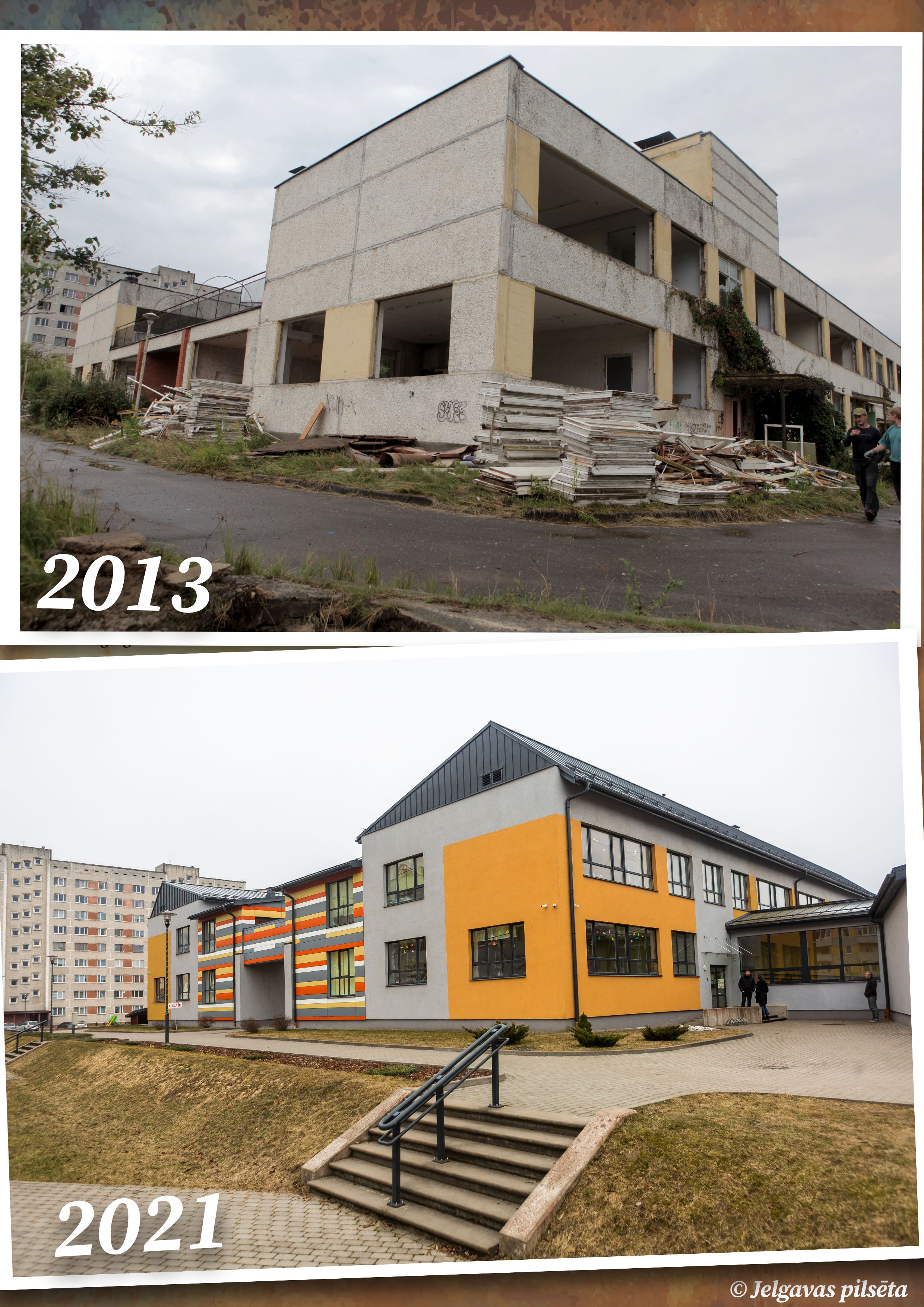
After the completion of the large-scale reconstruction, in 2015, the new kindergarten “Kāpēcīši” with 12 kindergarten groups, landscaped surroundings and two swimming pools was opened at Ganību Street 66.
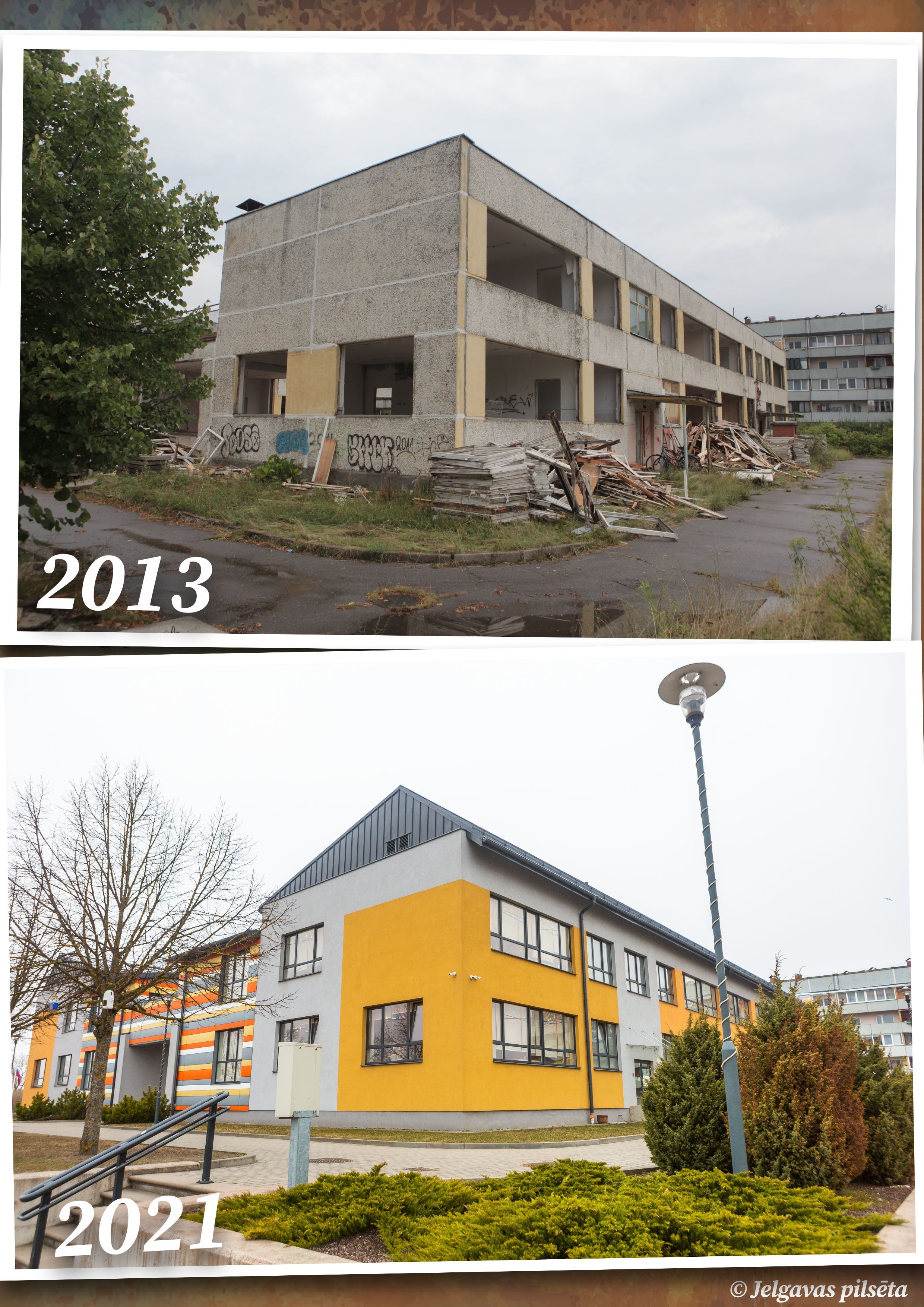
An extension was built to the kindergarten building, and two swimming pools were created – 10 x 15 meters and 4 x 5 meters in size – as well as a 90 square meter gym.
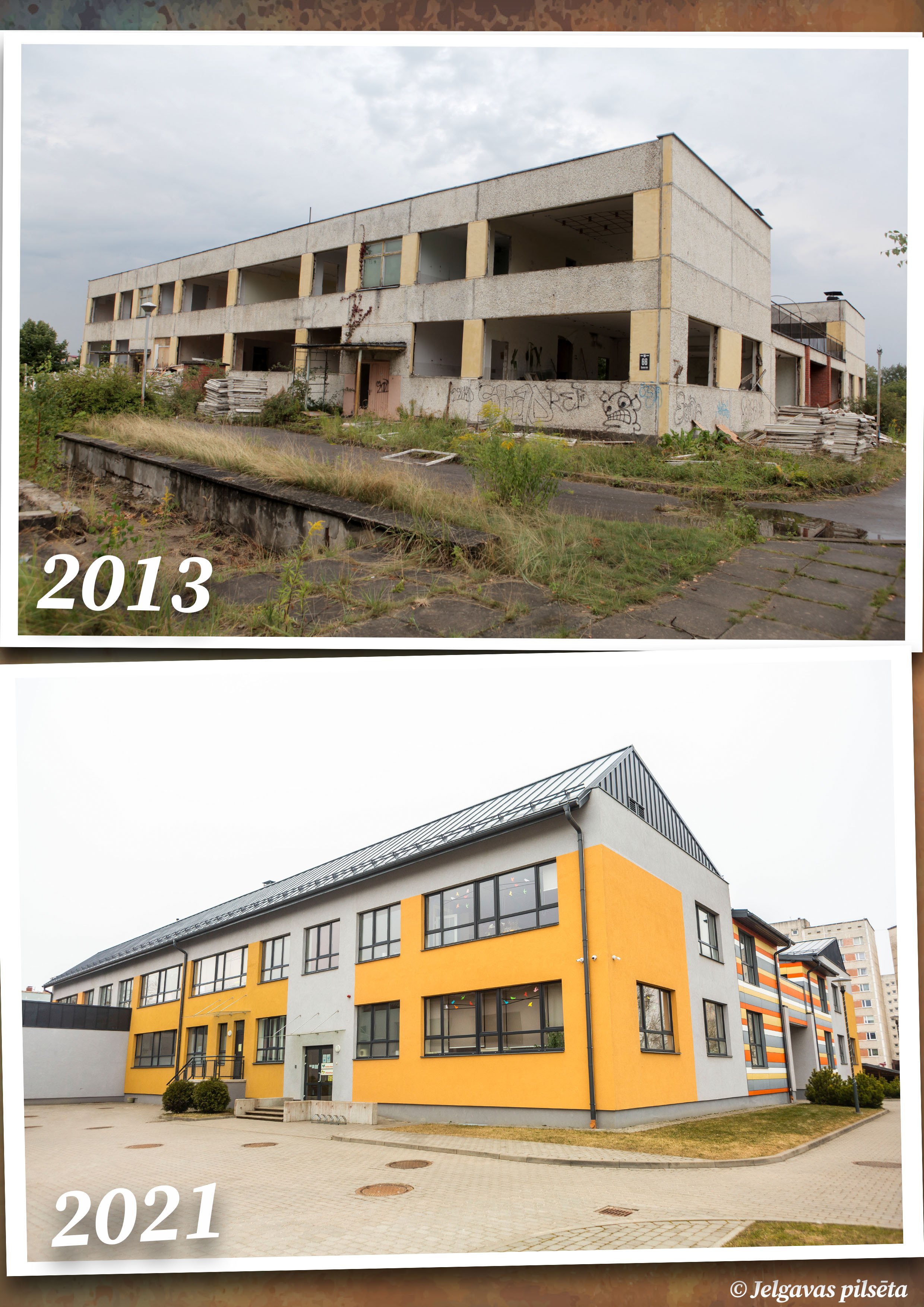
There is also a landscaped area, playgrounds for children of each group and a parking lot for 28 cars at the entrance gate.
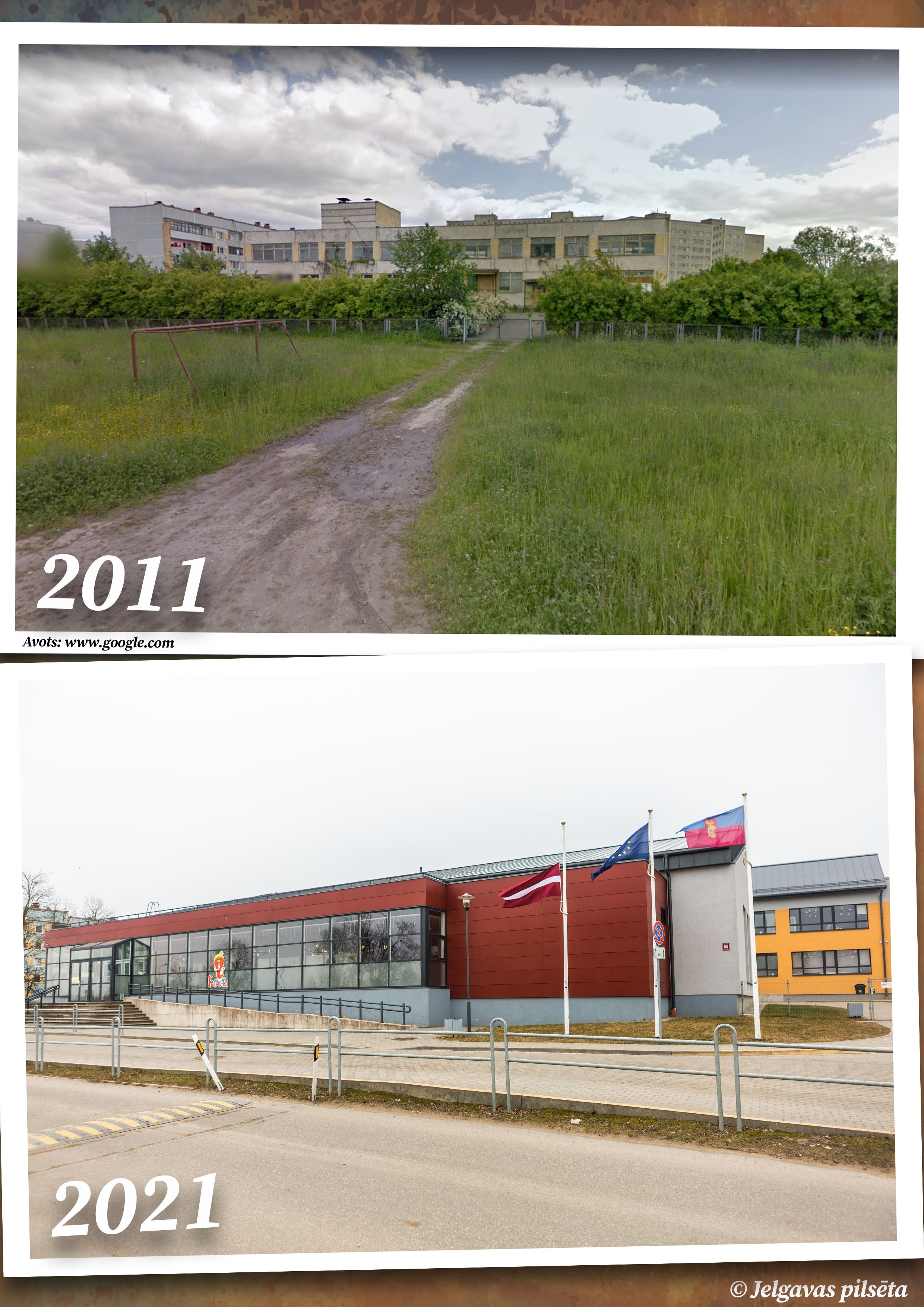

In 2019, in order to reduce the flood risk in the territory of Jelgava city, construction works were started in the vicinity of Būriņu Road and Sniega Street to restore the flow of the Svēte River and to reduce the flood risk in the adjacent area.
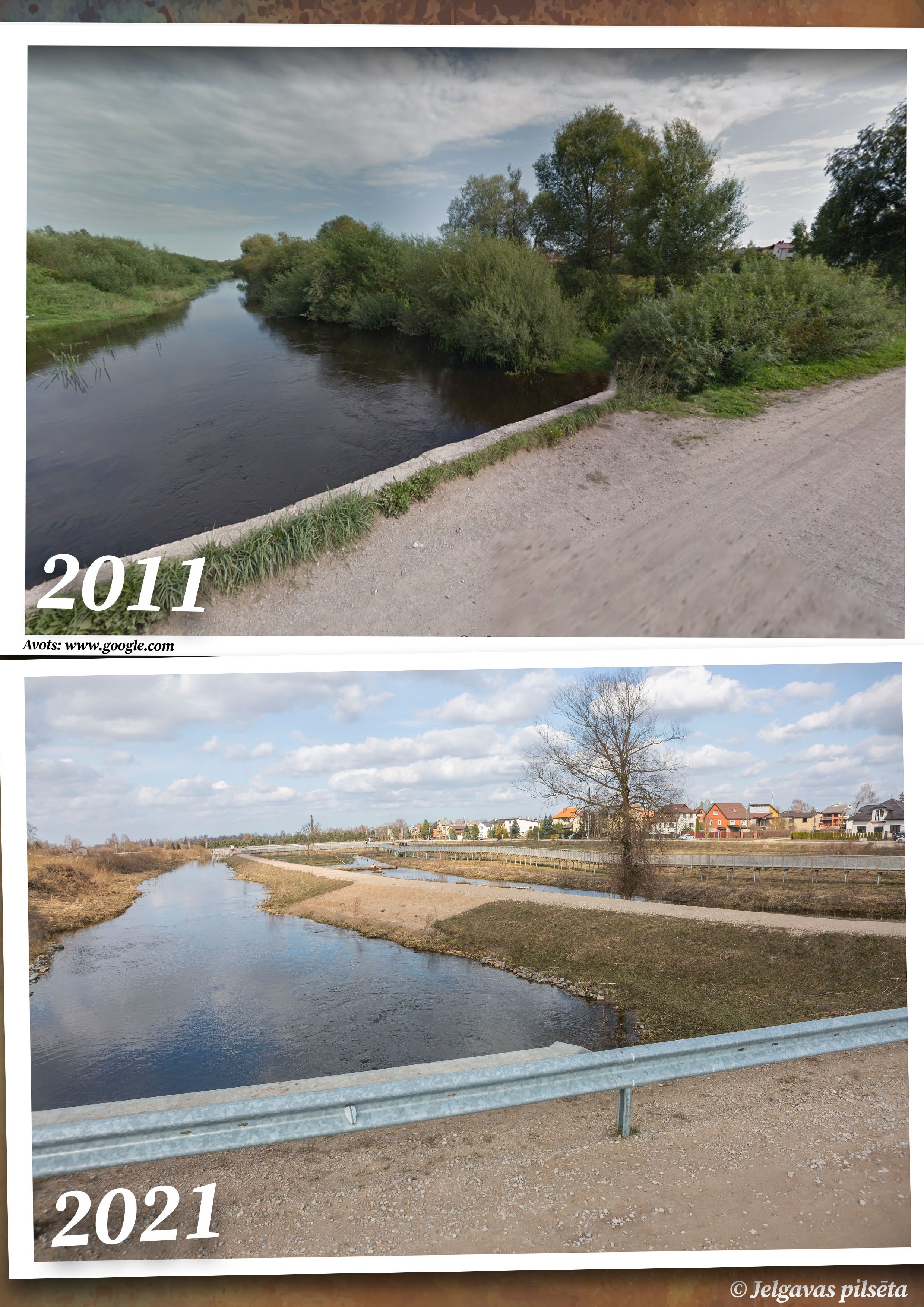
The construction work lasted for more than a year, and in March 2020, a new recreation area was opened – wooden footbridges in the Svēte floodplain meadows, which is one of the most visible benefits of this project for residents, as there is one more organized place to take walks in Jelgava.
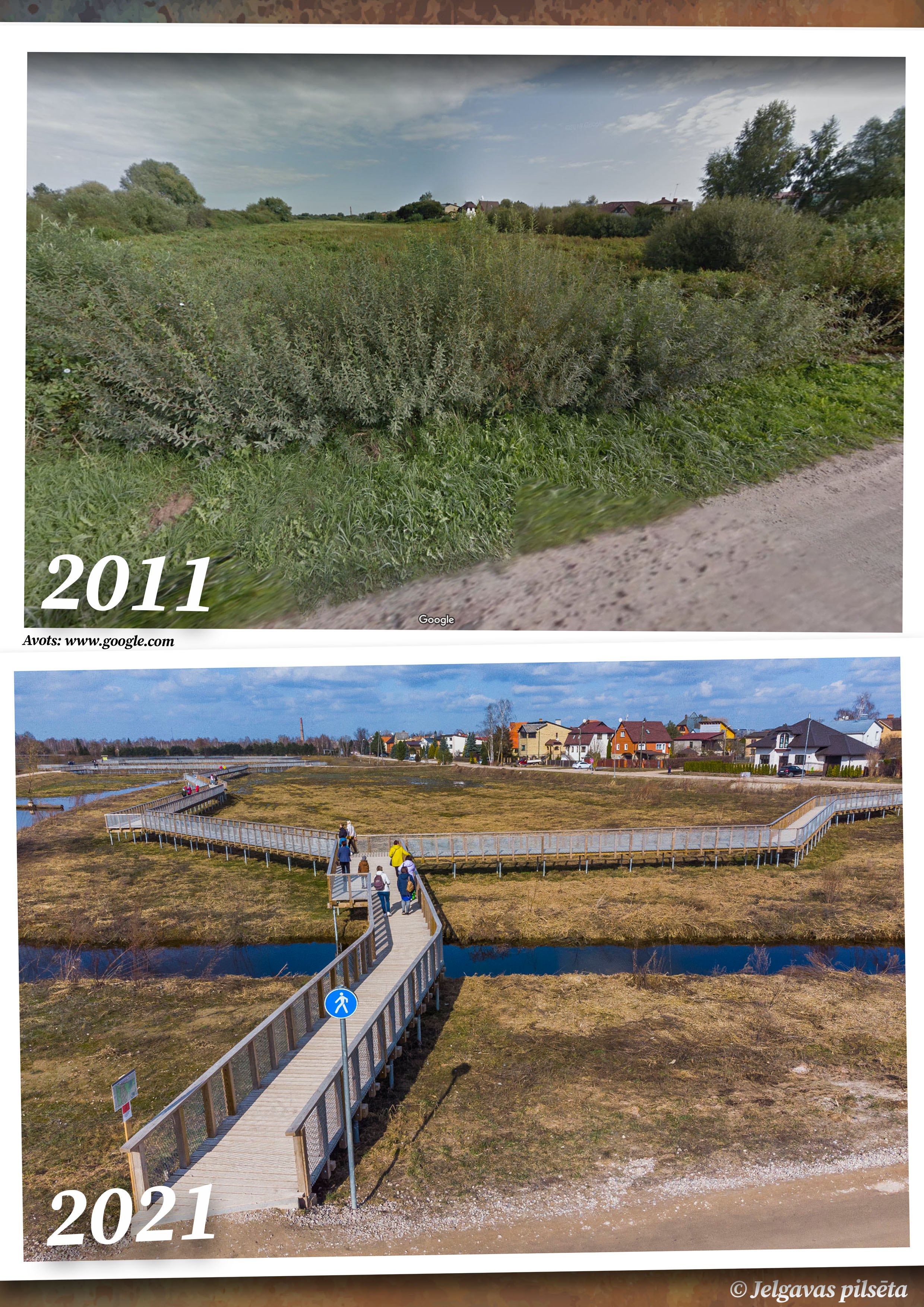
In the meadows of the Svēte floodplain between Sniega Street, Būriņu, Vītolu and Miezītes Road, a recreation area of almost 3365 square meters in size has been created. The built network of wooden footbridge paths for walks is more than 1.6 kilometers long and the footbridges are connected with three gravel paths. For pedestrian safety, wooden footbridges are equipped with handrails with fencing, and platforms have been created in several places for smoother pedestrian flow, allowing people to watch nature undisturbed.
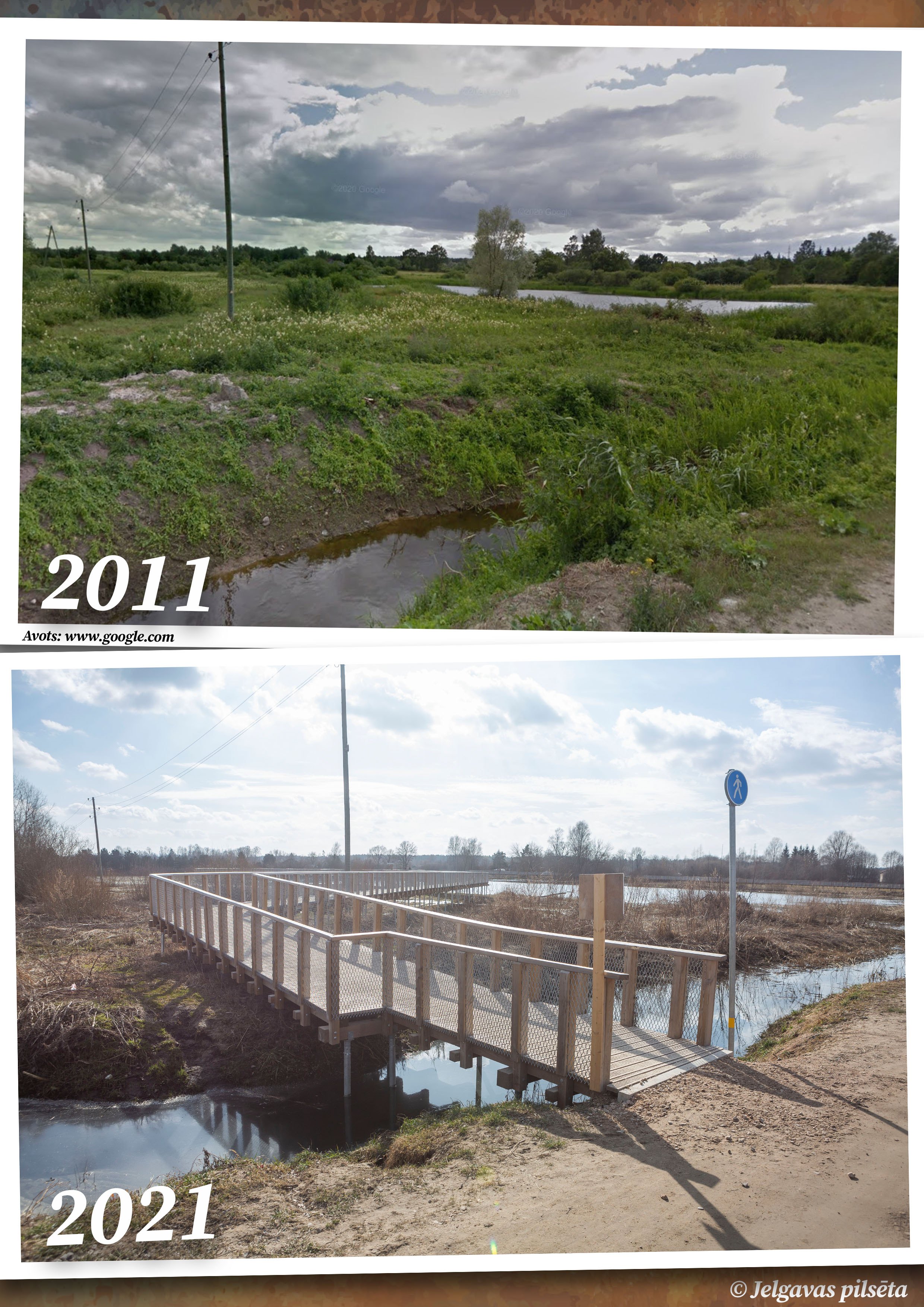
Wooden footbridges are a popular place for recreation walks for locals and other inhabitants.

Transformation of Sporta Street
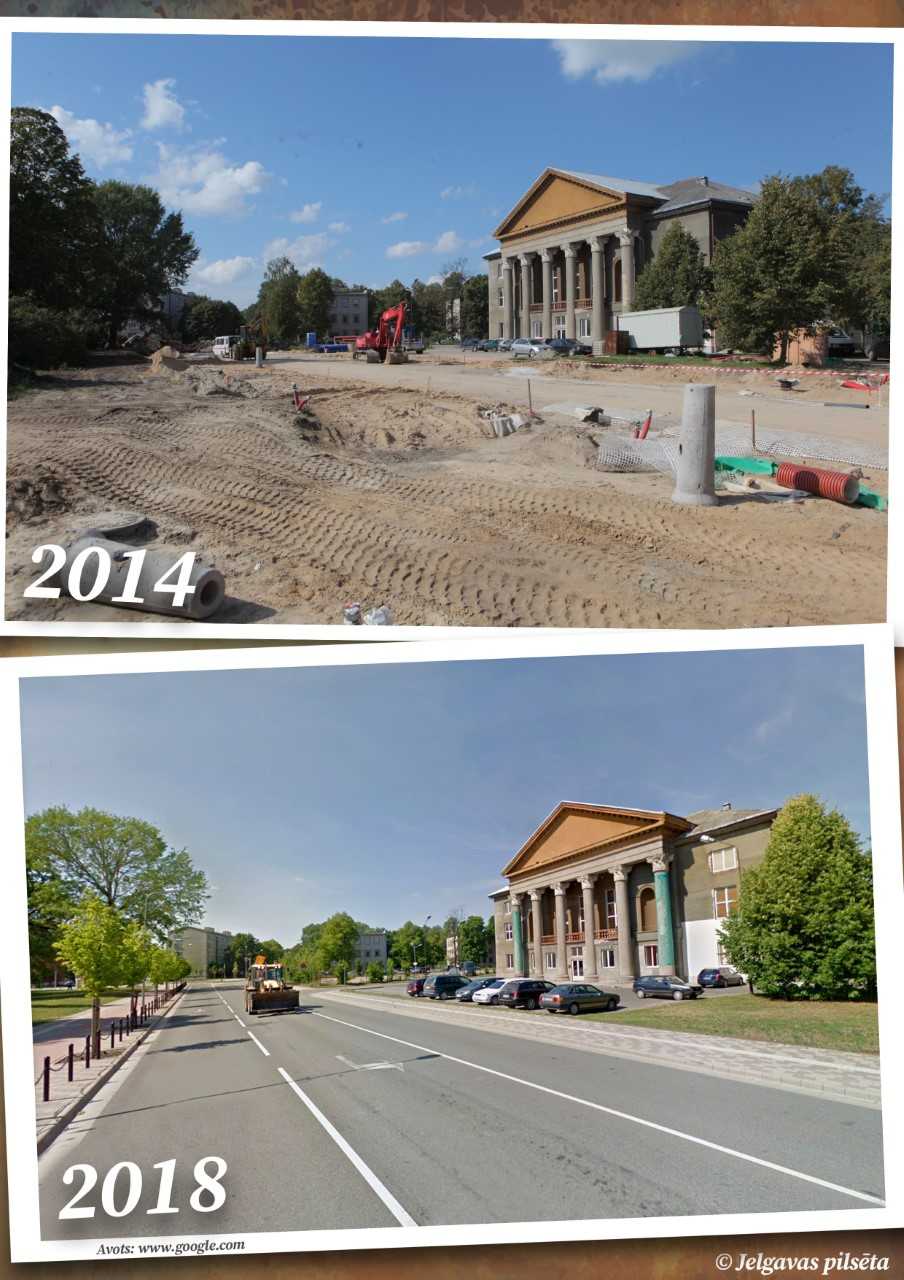
In 2014, with the aim of creating a modern and safe public transport system to ensure the connection of various modes of transport, the city of Jelgava started to improve several sections of streets,,including the reconstruction of Sporta Street in the section from Pasta Street, while the section from Pasta Street to Zemgale Prospekt was rebuilt entirely. During the reconstruction, a parking lot for 240 cars and a landscaped area was also created.
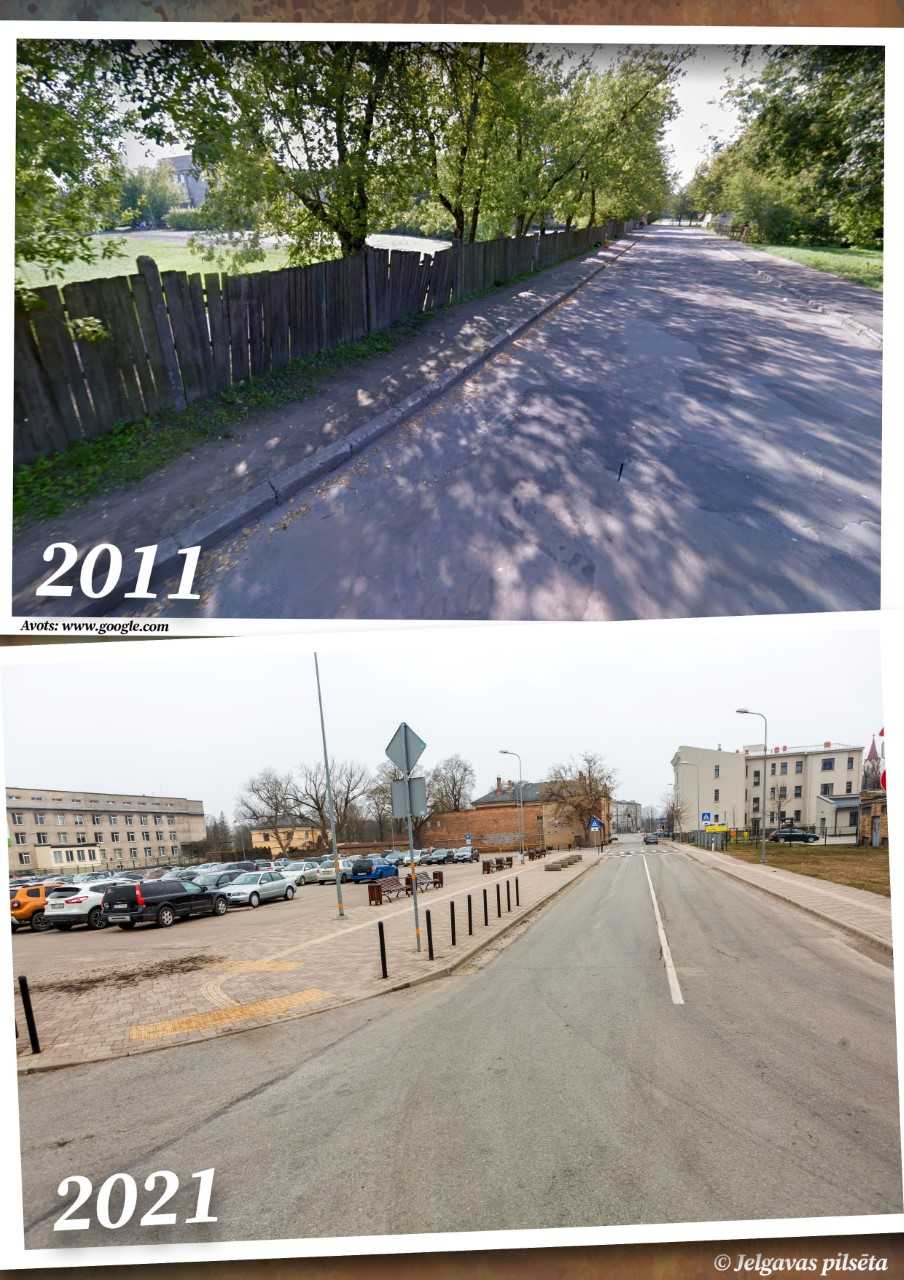
It is important to note that in the section of Sporta Street from Zemgale Prospekts to Pasta Street, a soil research was carried out using manual labor in order to find archaeological objects that would allow to record the formation time of the archaeological layer. Archaeological objects that were found have been cleared of overgrowth, numbered and their description has been prepared. After the completion of the works, all of the found objects have been handed over to the Ģederts Eliass Jelgava History and Art Museum.
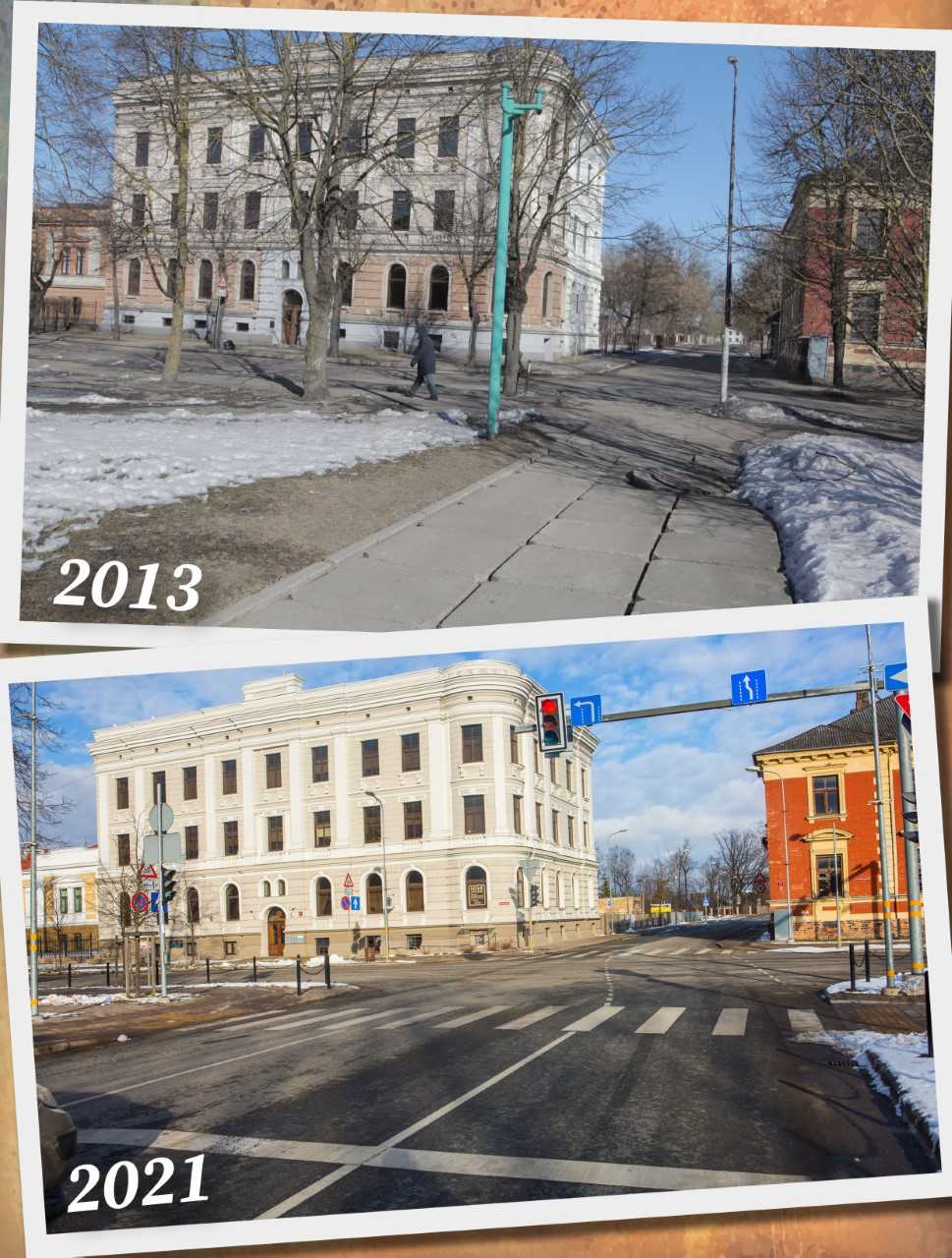

Changes of Lielupe Bridge
In the old Jelgava engravings and postcards, a floating raft bridge over the Lielupe can be seen, which was attached to piles driven into the river. In order not to carry the ice raft bridge, it was used only during the warm season and was removed every year before the onset of winter.
During World War I, in the summer of 1915, when the Tsar’s troops retreated from Jelgava in the direction of Riga, the floating Lielupe bridge was demolished and burned in order to prevent the advancing parts of the attacking 8th German Army.The first permanent bridge over the Lielupe in Jelgava was opened 105 years ago on March 1st, 1916, during the German occupation. It was built by the 8th German Army bomb disposal unit soldiers. The bridge was made out of wood and was called the Paprica Bridge.
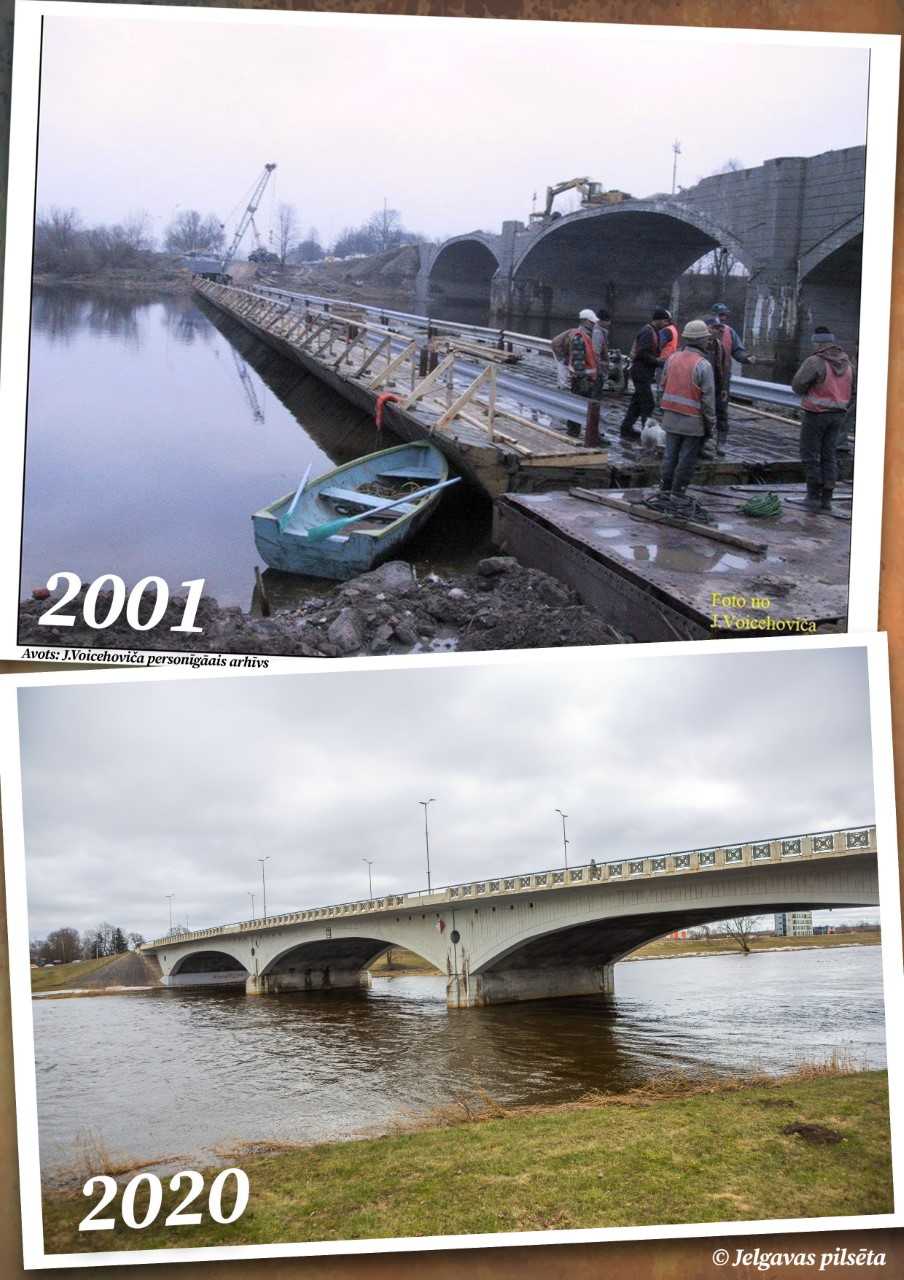
A reinforced concrete vault bridge over the Lielupe river in Jelgava was built in the mid-1950s. Its length is 146.6 meters. When the Lielupe bridge was reconstructed in 2001, traffic over the river was organized over a pontoon bridge. Along with the Lielupe Bridge, the Driksa Bridge has also been renovated.

The building of the Jelgava State Gymnasium was designed by architect Valdis Zēbauers and completed in 1939. The school building was damaged during World War II along with about 95 percent of the city, however the school building was later restored.
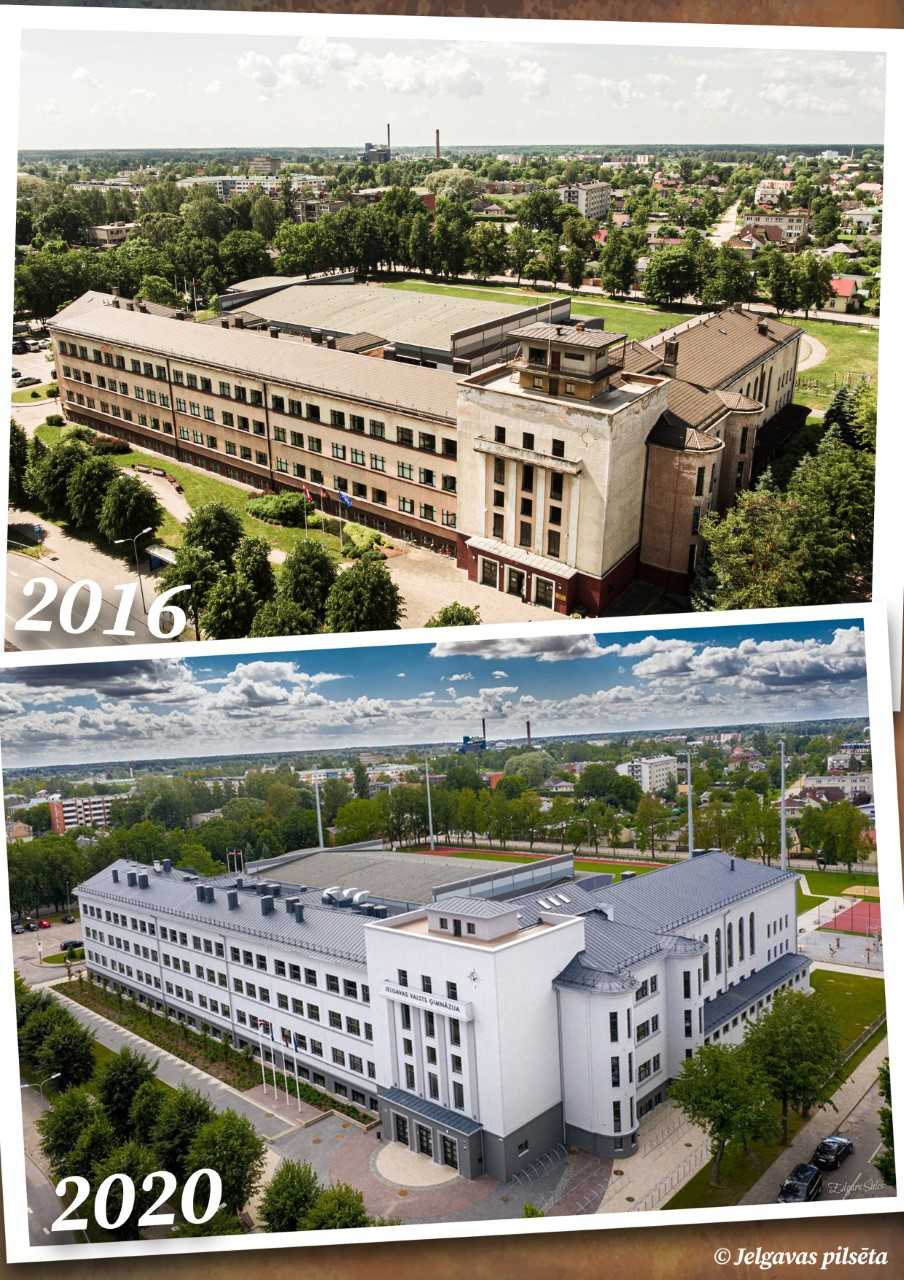
As the school had not undergone major renovations before its reconstruction, it kept its architectural look of the 1930s. It was decided to preserve as much as possible during the reconstruction – to restore where possible and to re-create it other places by analogy.
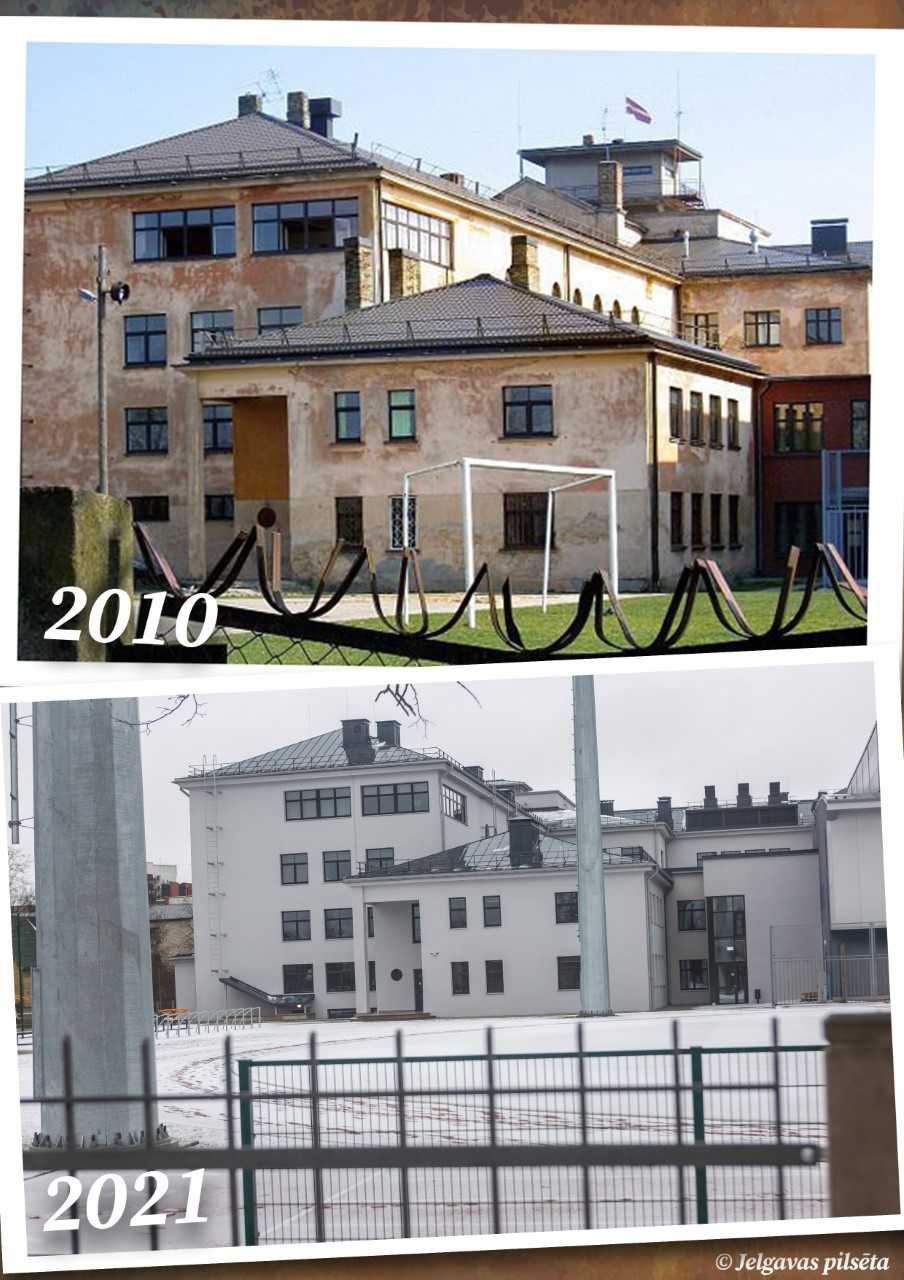
The reconstruction of Jelgava State Gymnasium was completed in 2019. The large-scale construction work lasted two and a half years, and new piping and utilities were built for the school – heating, gas, electricity, sewerage and water supply – which had not been changed since the building was renovated after the Second World War.
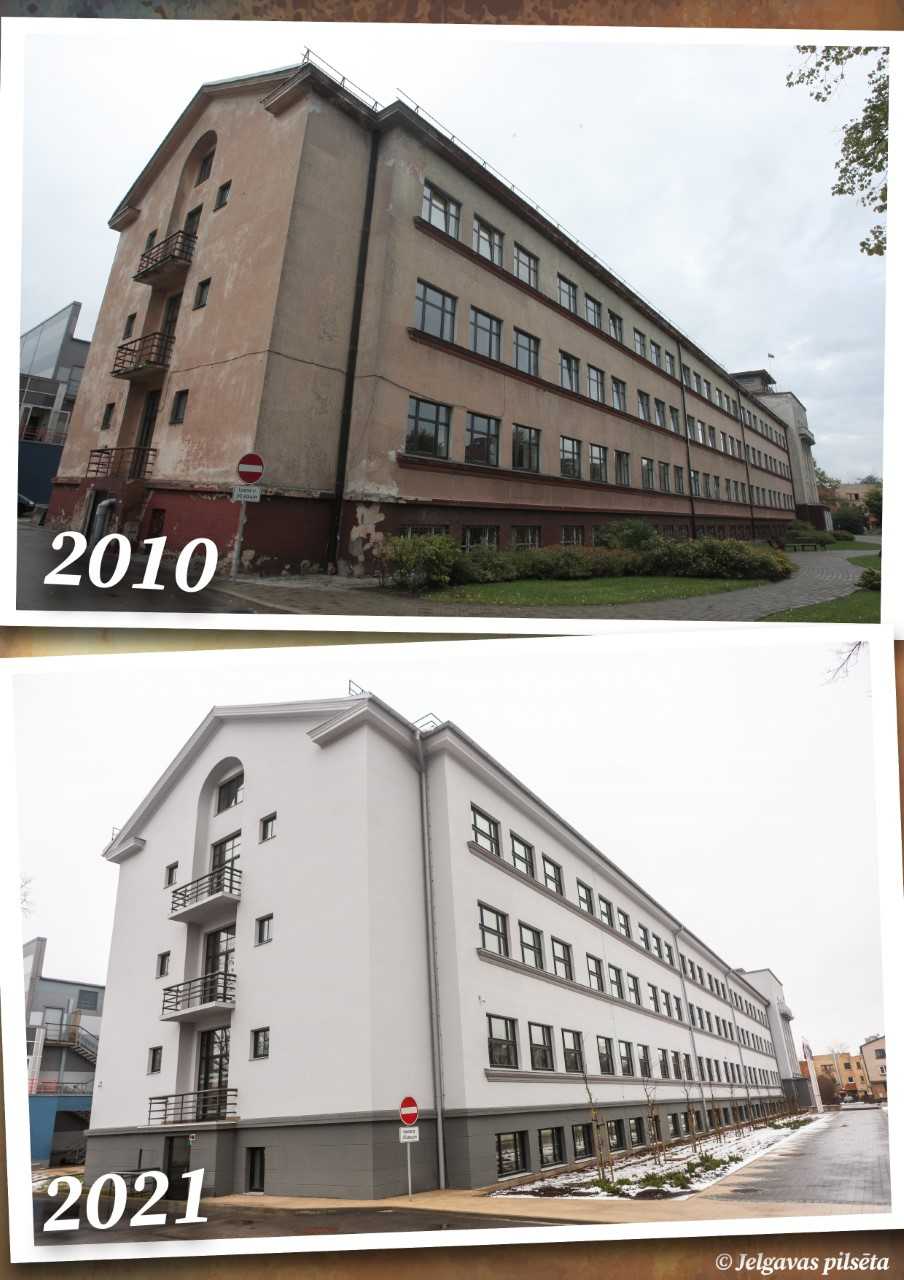
The building has a new roof and windows, a renovated facade painted in the gray tones, typical to the functional architecture of the 1930s, a landscaped area and a stadium. Within the framework of the reconstruction of the historical building, an ergonomic school environment has been created, information and communication technology solutions have been introduced, and the sports infrastructure has been improved.
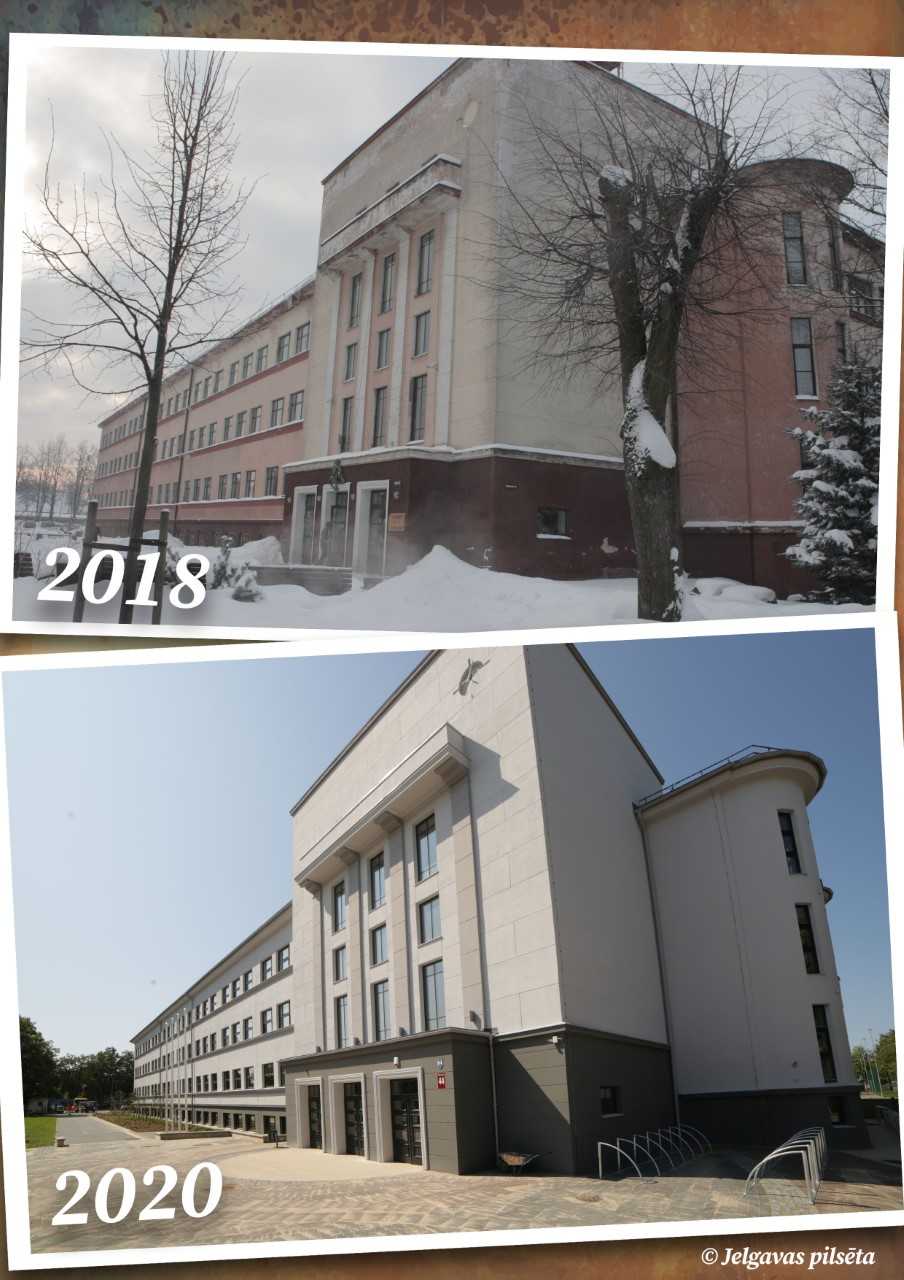
In 2020 the reconstructed building of Jelgava State Gymnasium, won the 3rd place in the competition “The best building of the year in Latvia 2019” in the nomination “Reconstruction”.

Jelgava State Gymnasium sports stadium – a place of recreation, sports and sports activities for rezidents
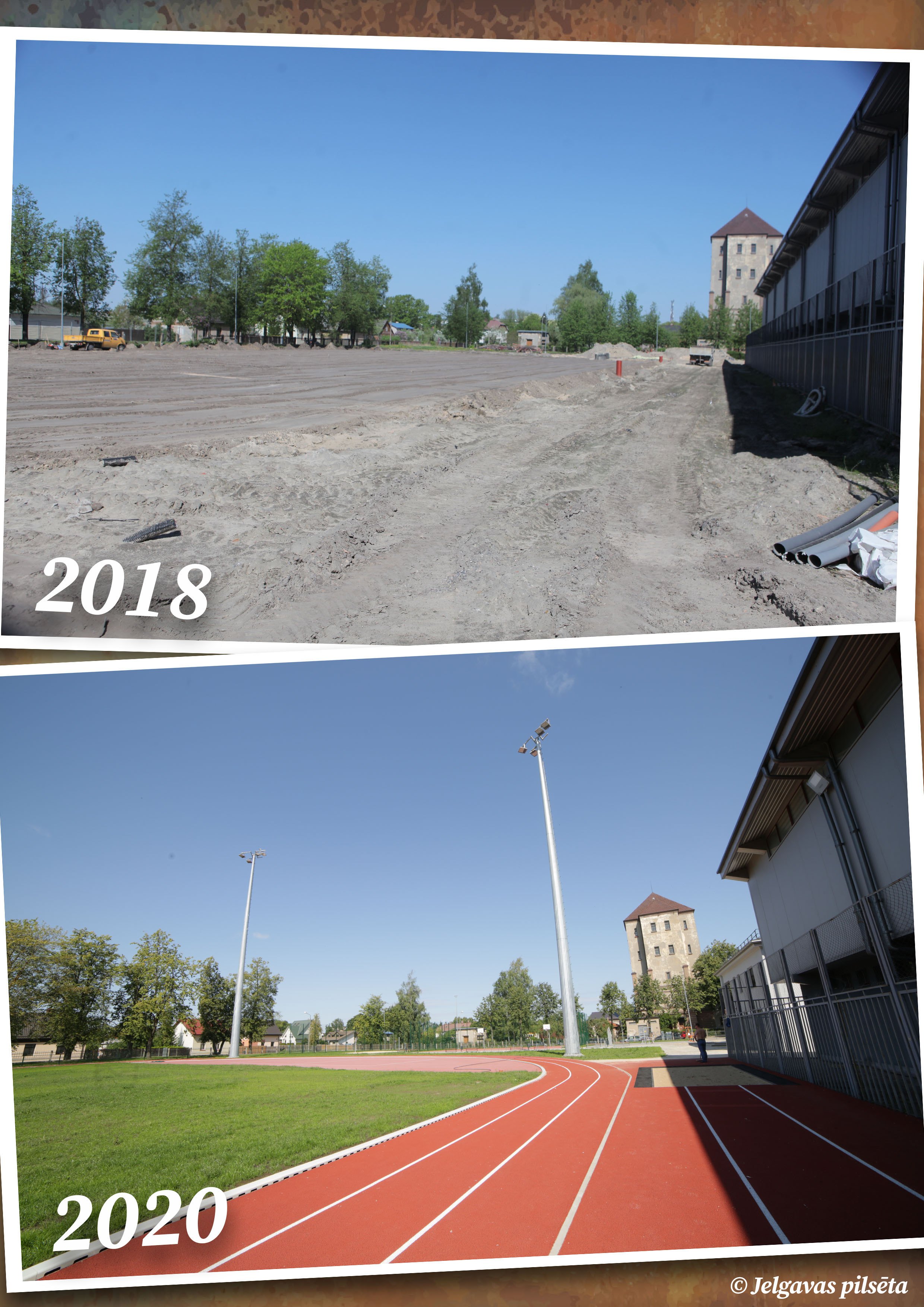
At the end of 2018, large-scale construction works were performed at the Jelgava State Gymnasium Stadium, as a result of which two streetball courts, a volleyball court, two long jump pits, a ball-throwing sector, two folk ball fields, a ball-throwing sector, a high-jumping sector and a fitness area with eight devices were installed in the 6511.10 square meter stadium.
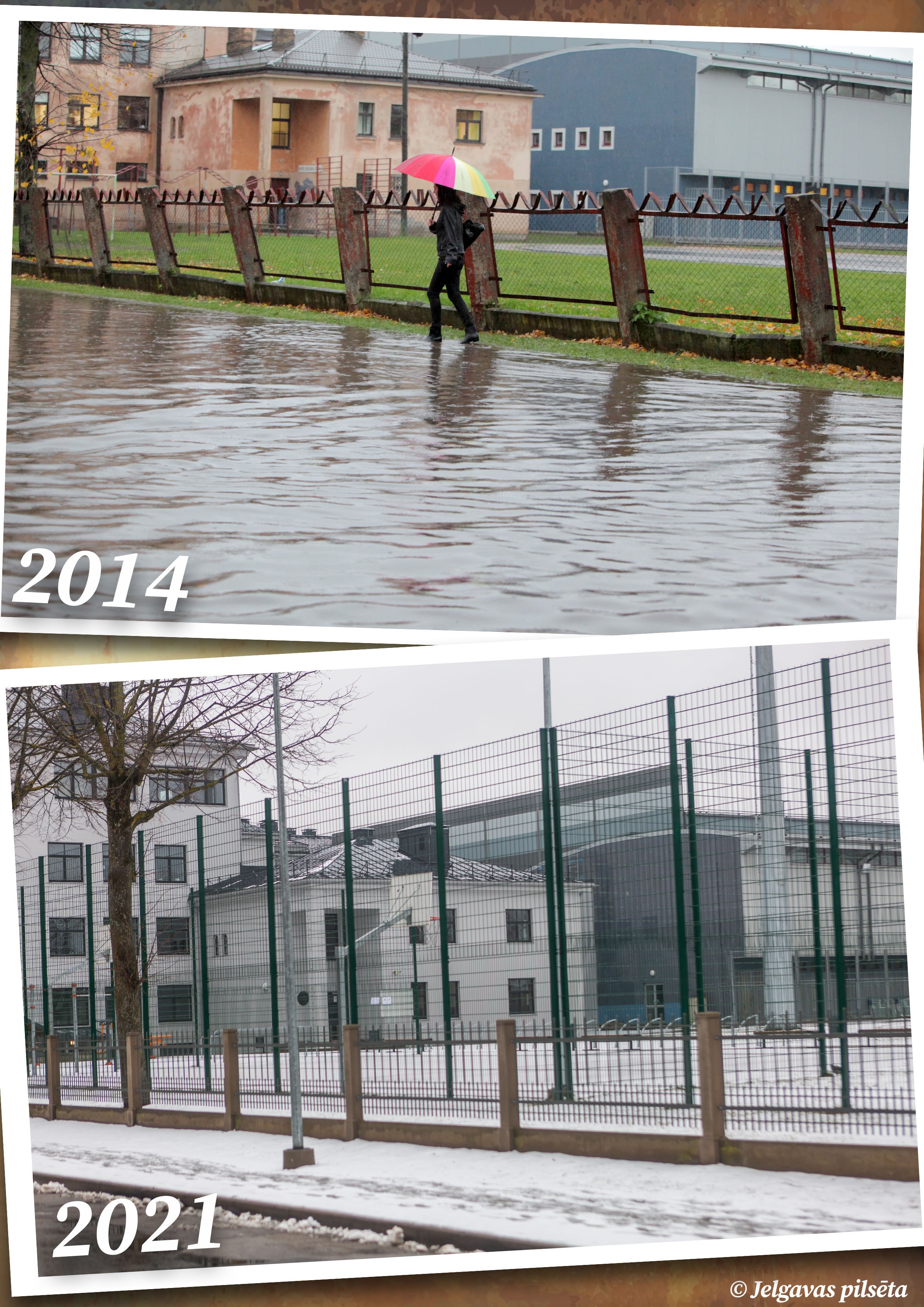
A new metal fence has been installed around the stadium and 30-meter-high spotlights have been installed so that the stadium can be used in the evenings.

Street Vecpilsētas 14 – a three-storey wooden building, which is an architectural monument of national significance and one of the oldest and most valuable wooden houses in Jelgava
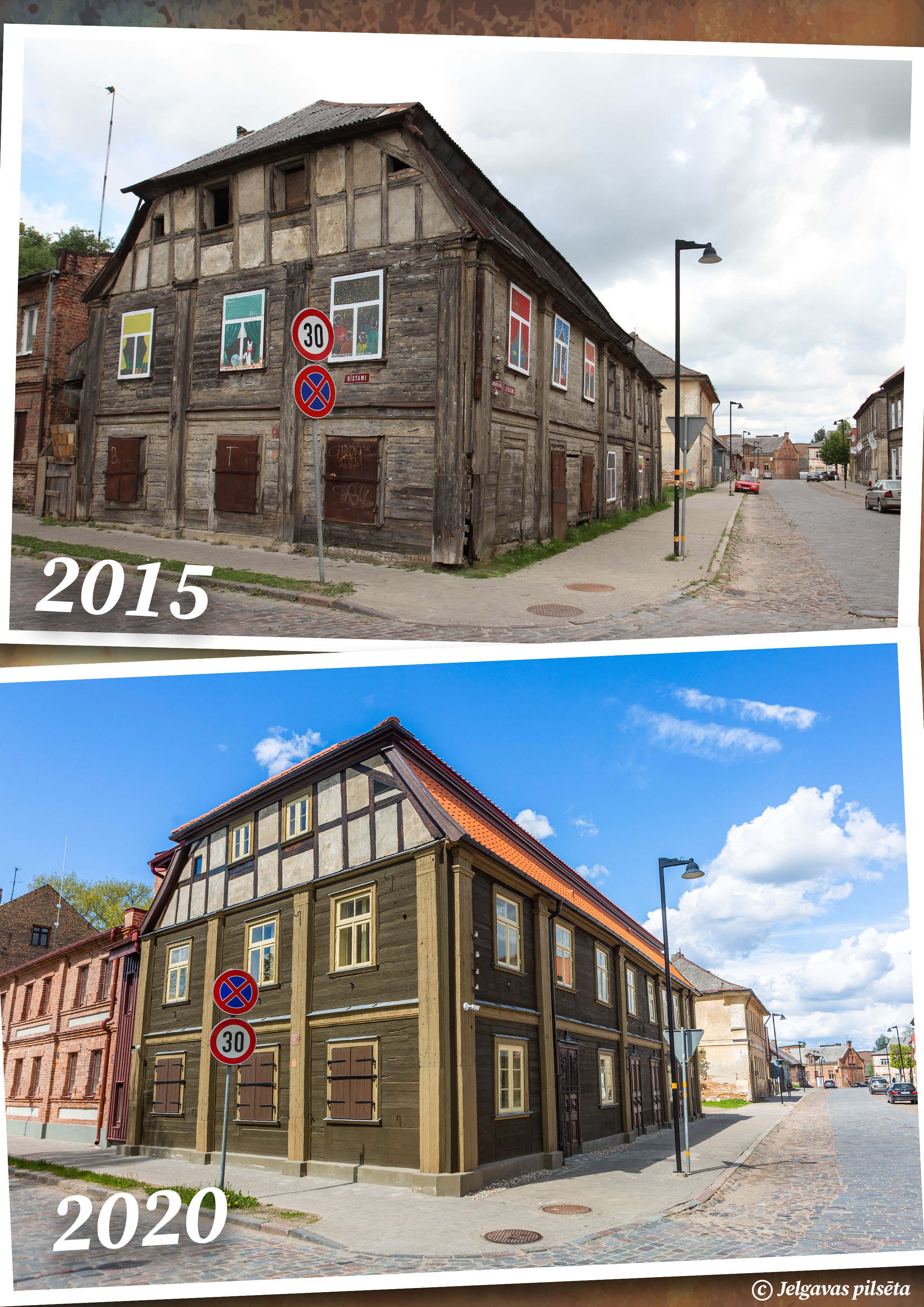
When the construction works started in 2018, the building was in a state of emergency, but as a result of the renovation, the facility has retained an overview on the various interior decorations, which indicates the development of historical style trends in the interior and lifestyle, tastes and material possibilities of the building’s historical occupants.
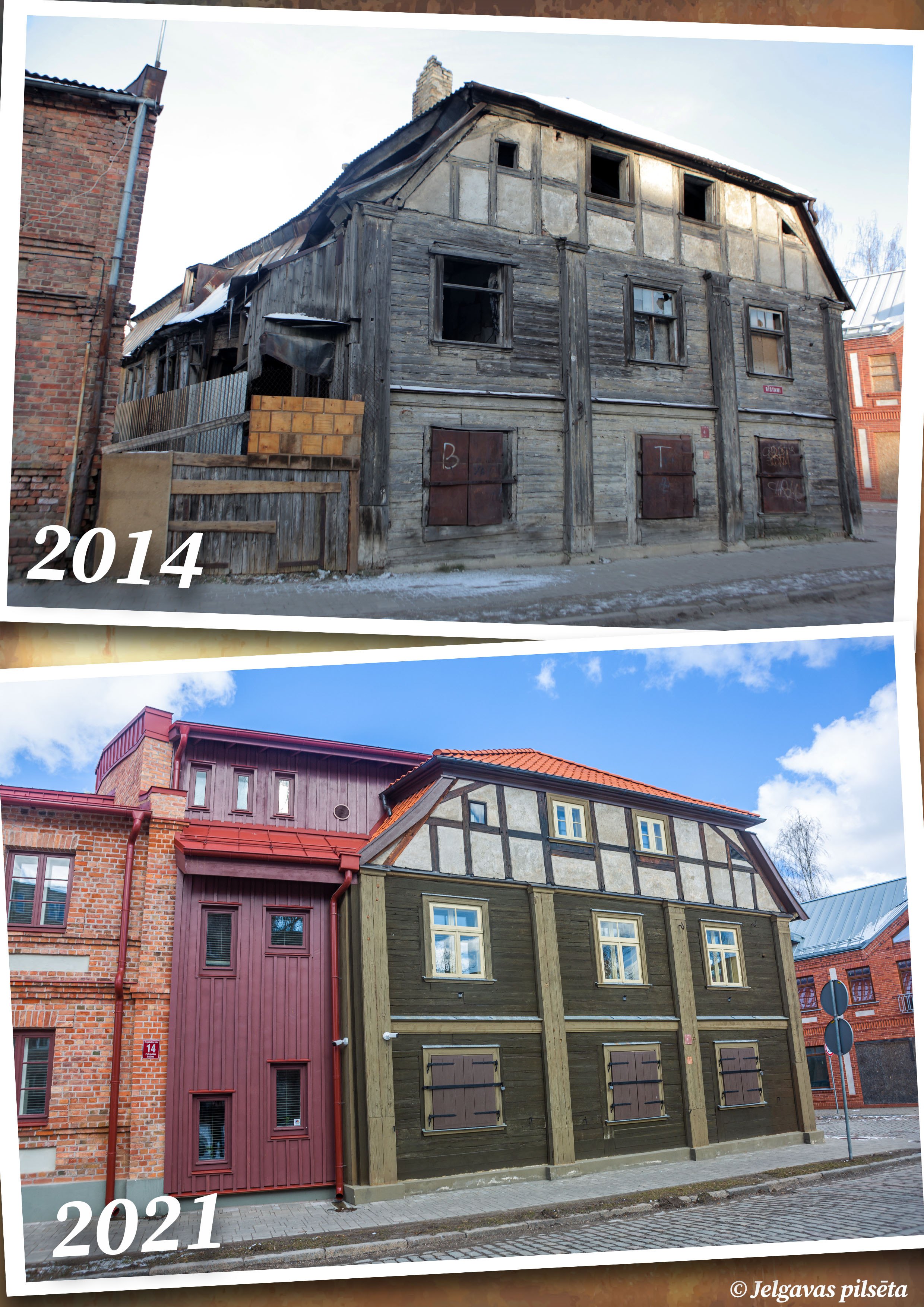
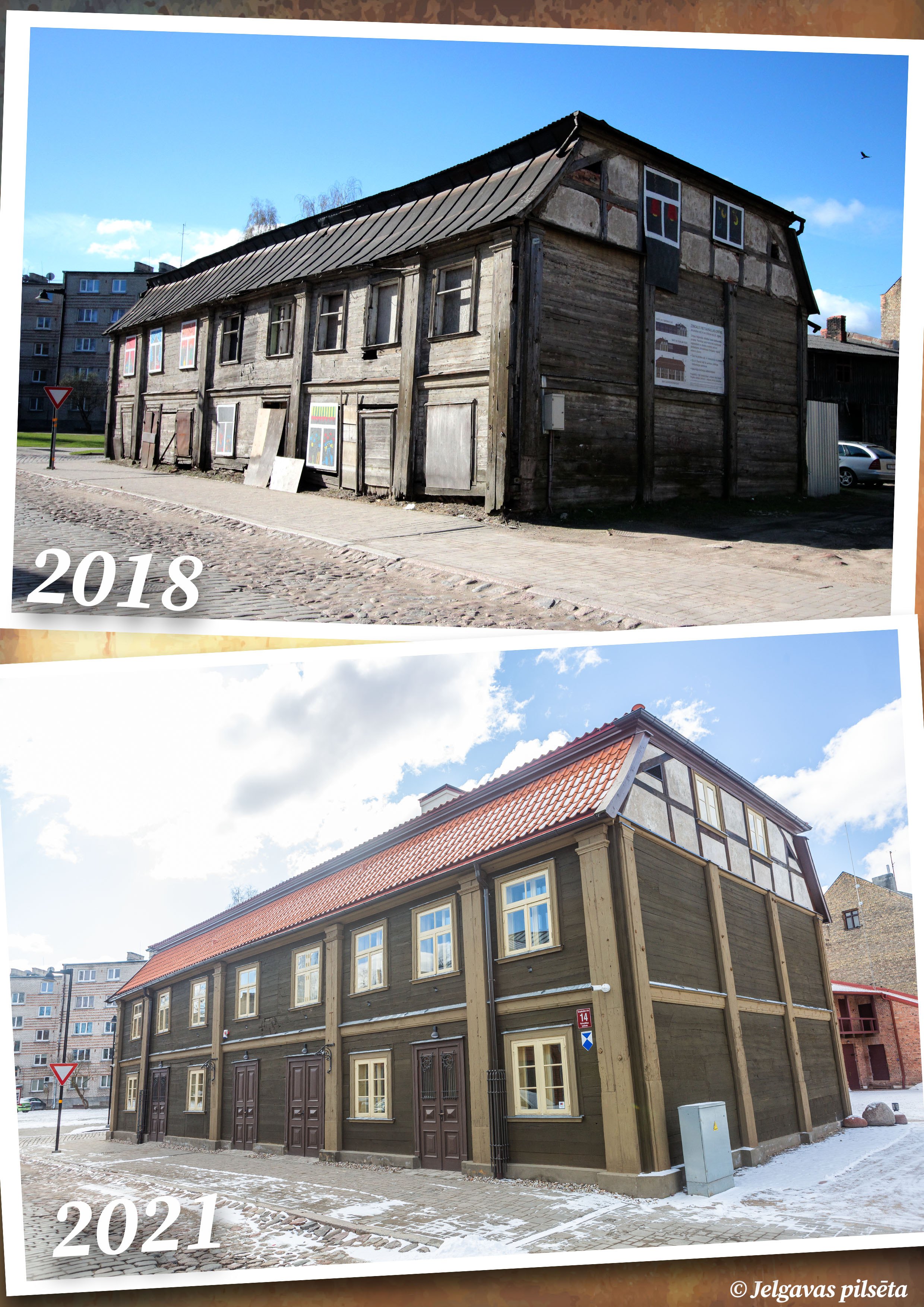
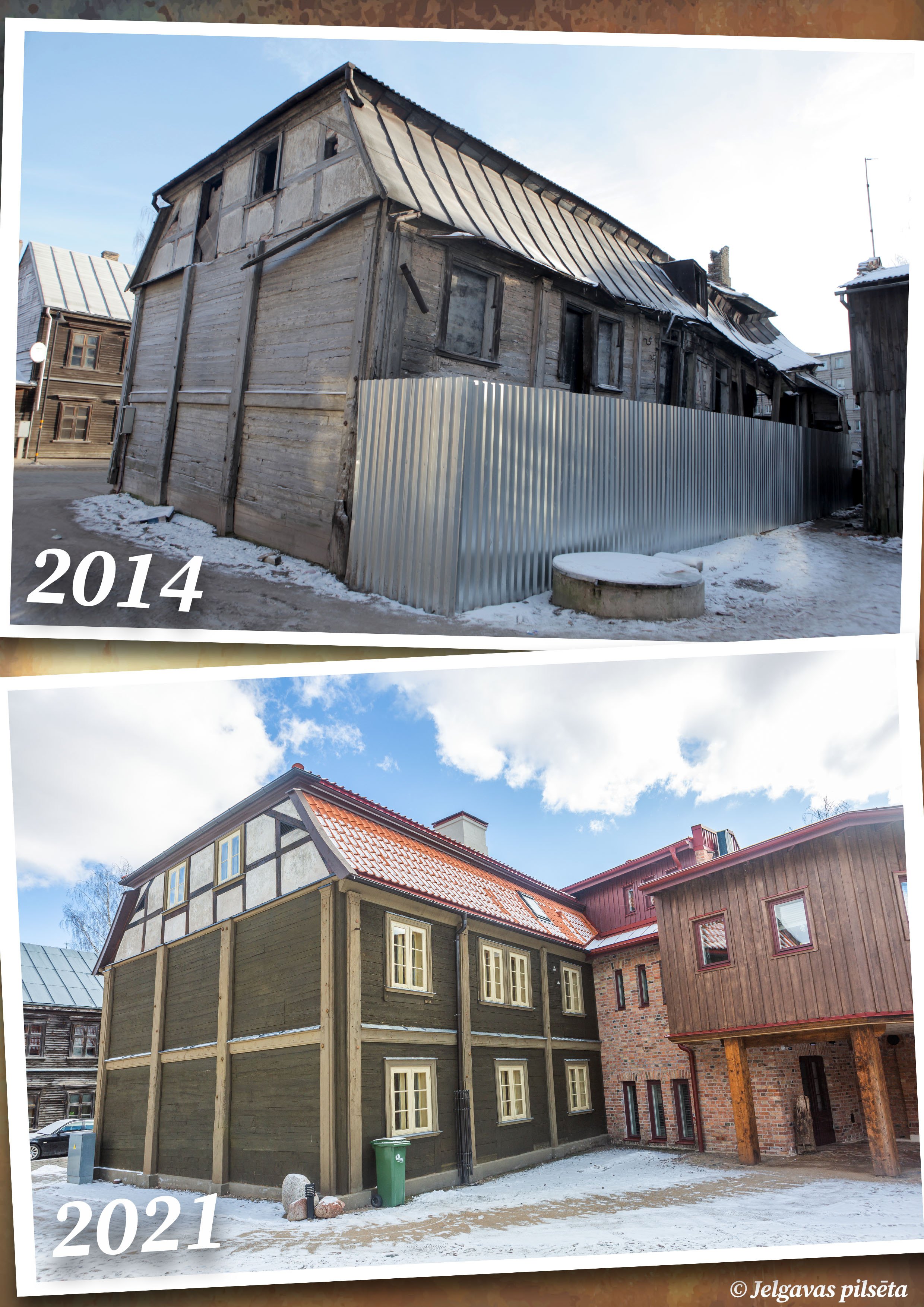
.jpg)
In 2020, the building No. 14 on Vecpilsētas Street was recognized as the best building in the nomination “Restoration” in the competition “The Best Building of the Year in Latvia 2019” and in the competition “Latvian Construction Annual Award 2019”.

Building on Zemgales prospekts 7 – the place where the Creative House “Junda” and the children’s and youth library “Zinitis” are located
.jpg)
The building was built in 1888 for the donation of Jelgava publisher Gustav Adolf Reir to the city according to the project of architect Aleksandrs Johann Friedrich Baumanis as a shelter for the widows of merchants, and its extension, built in 1973, has experienced extensive changes.
.jpg)
The construction work lasted for more than two years, creating a modern and up-to-date environment – the house has a new roof, windows, doors, restored facade, as well as two of the facade information boards on the older part of the building in which engraved gratitude to the builders. There are benches, a basketball hoop, a rock climbing wall in the yard, and there are bicycle parking spaces around the whole building, including one fenced and locked.

Jelgava Holy Trinity Church tower – one of the most visited tourist attractions in Jelgava
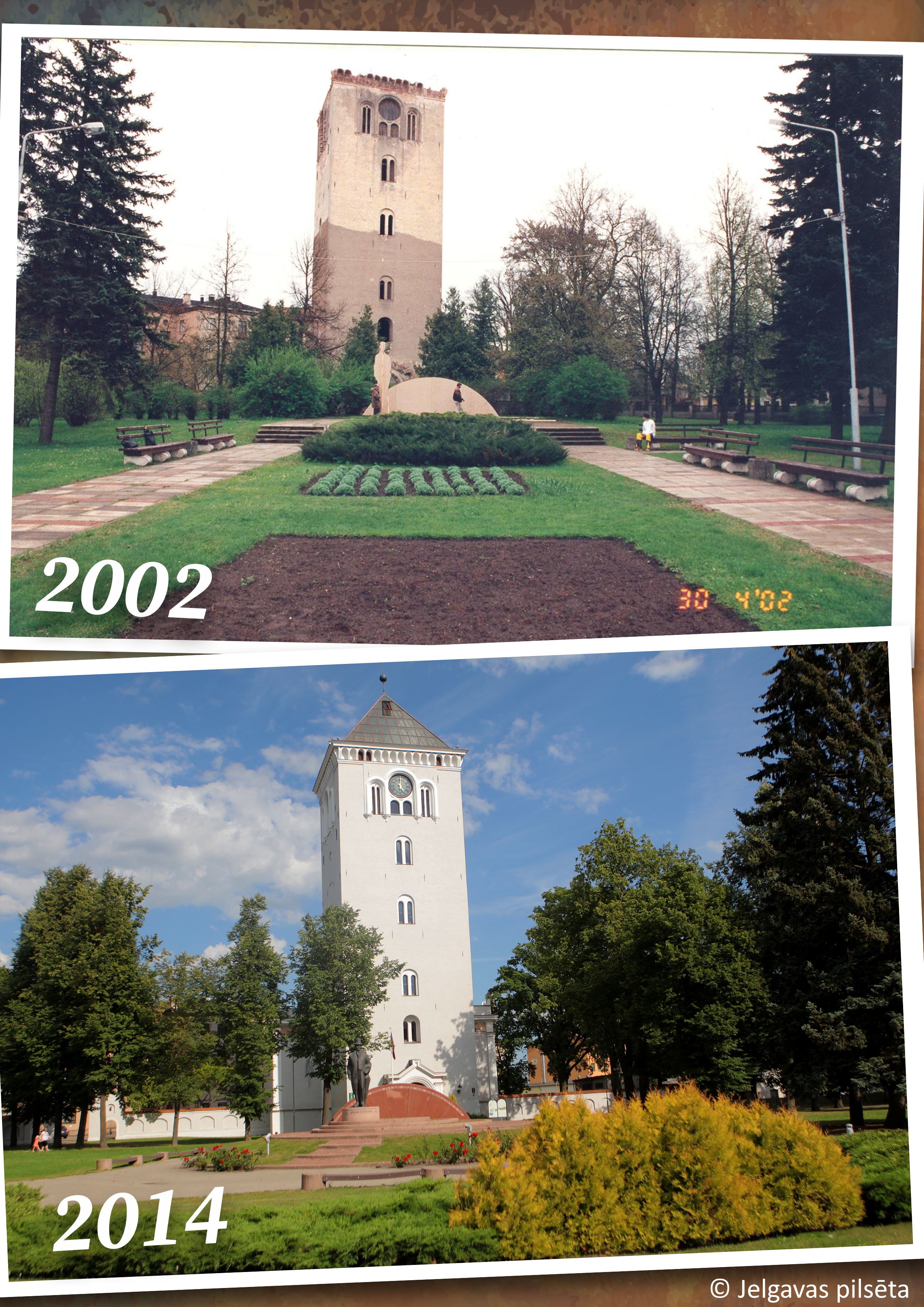
In November 2010, after an extensive reconstruction, the tower of the Holy Trinity Church was restored in a new form and opened its doors to visitors.
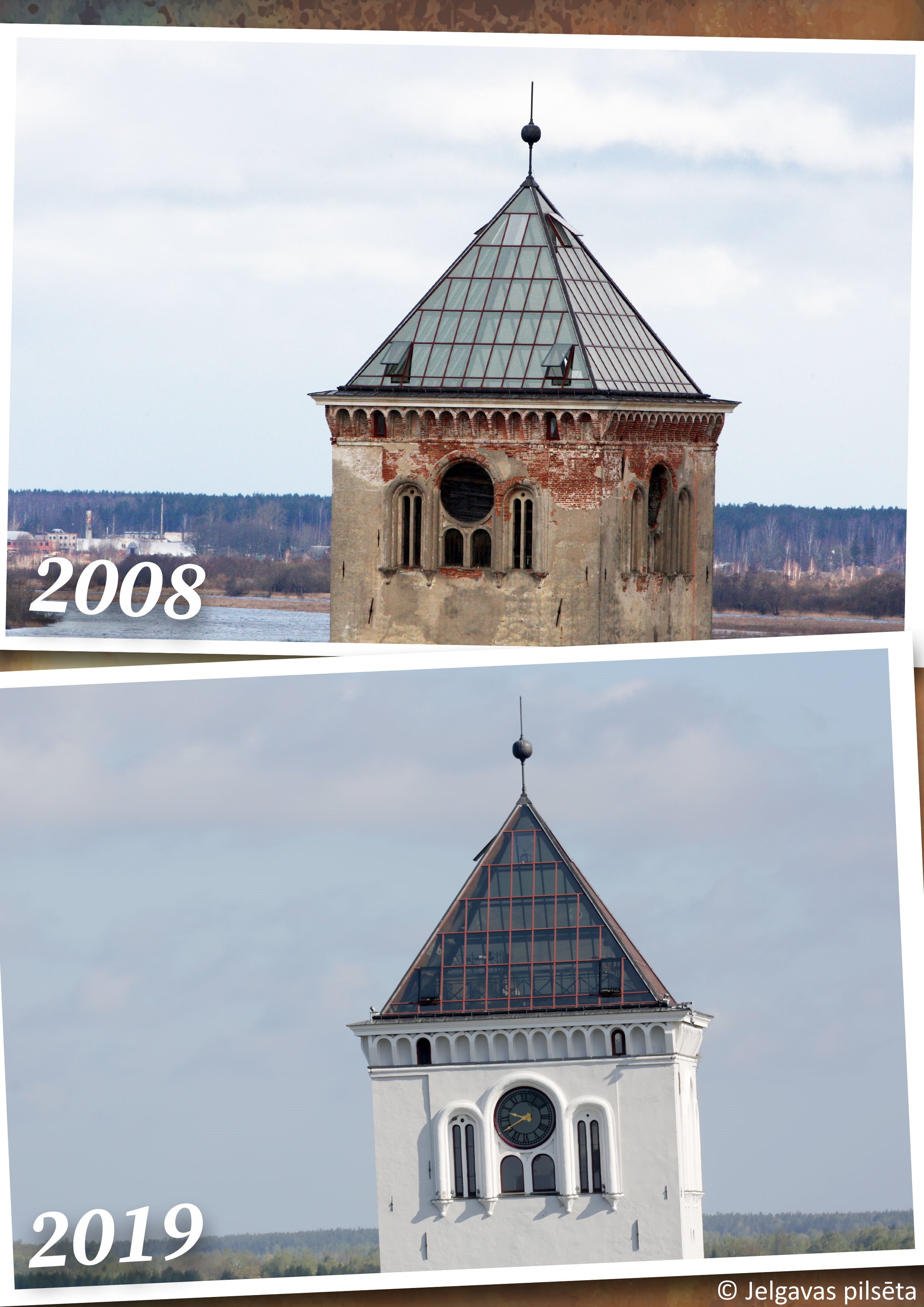
During the first days of opening, 3726 atendees got acquainted with the expositions of the tower, but during the first year, the exposition and viewing area was visited by an impressive number of 39,965 people from different parts of Latvia and the world.
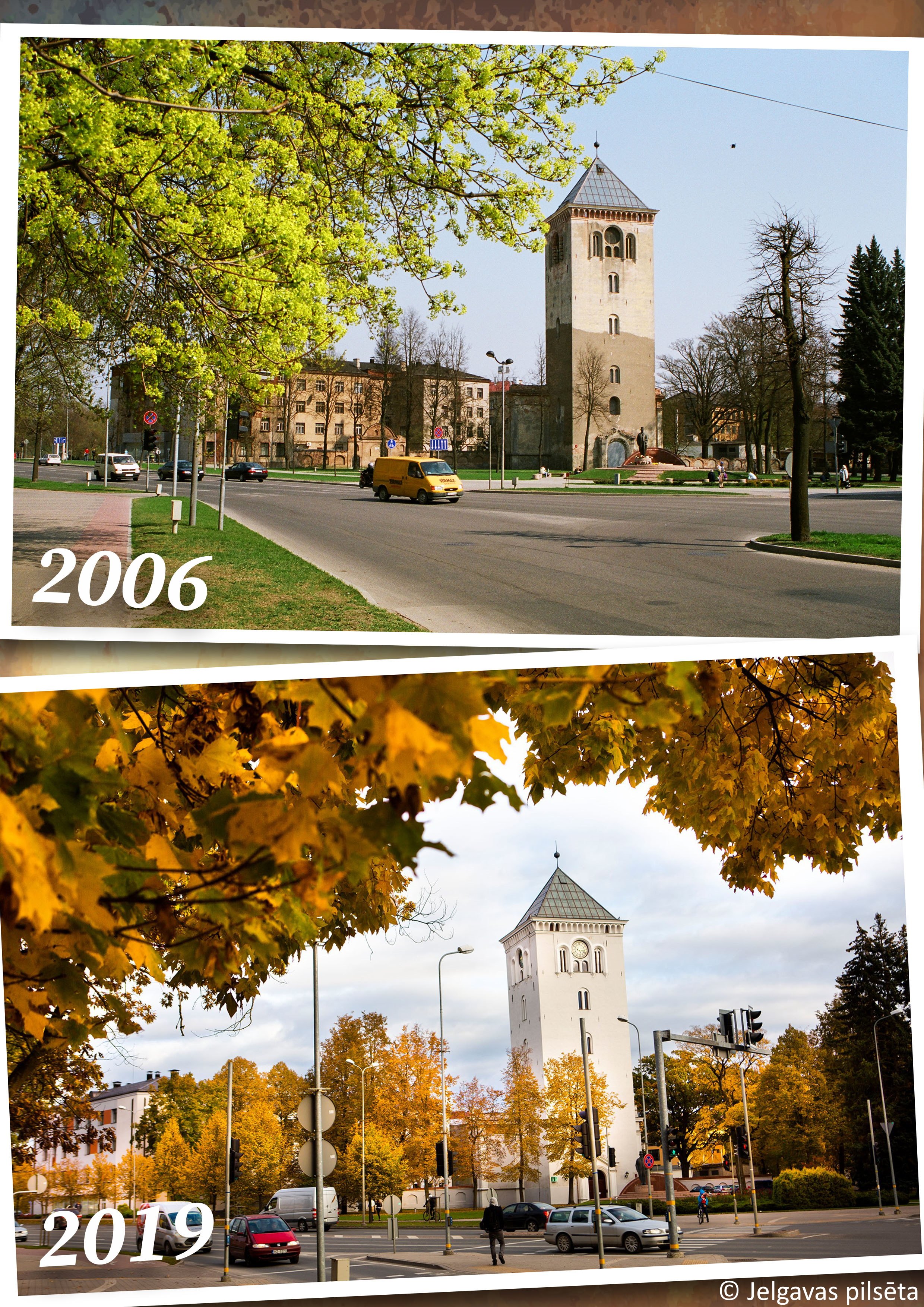
Interesting facts:
- The church tower is the oldest building that has survived in Jelgava.
- The total height of the tower is 50 meters.
- The glass platform, from which you can enjoy the panorama of Jelgava, is located at a height of 37 meters.
- The central area of the historical Holy Trinity Church in Jelgava is decorated with a sculpture fountain “Trinity”, which symbolizes the core of the highest values of the Christian faith – the unity of God the Father, God the Son and God the Holy Spirit.
 31.7 °C,
5.1 m/s,
32.9 %
31.7 °C,
5.1 m/s,
32.9 % 